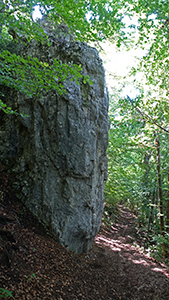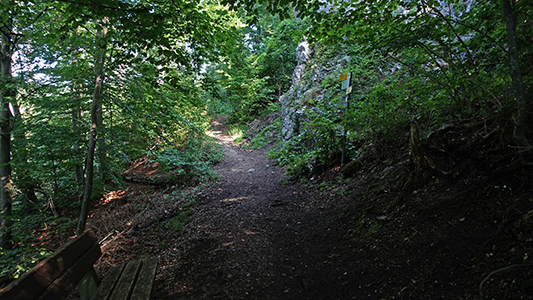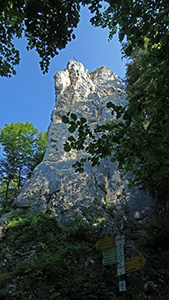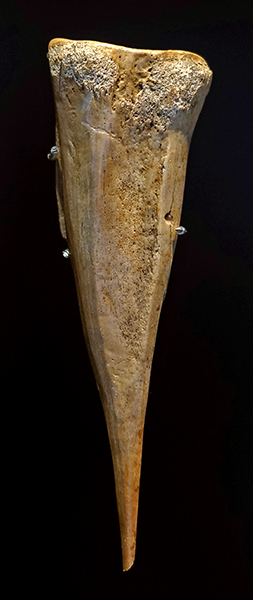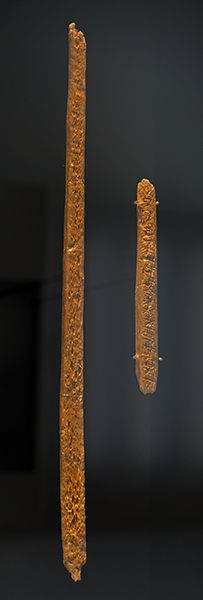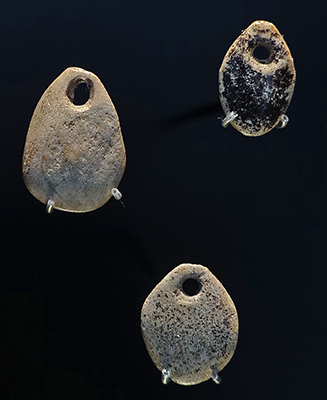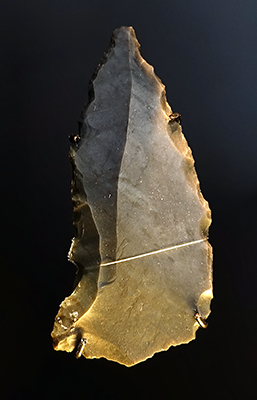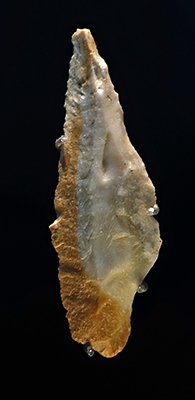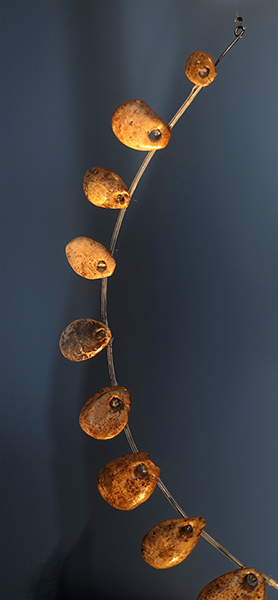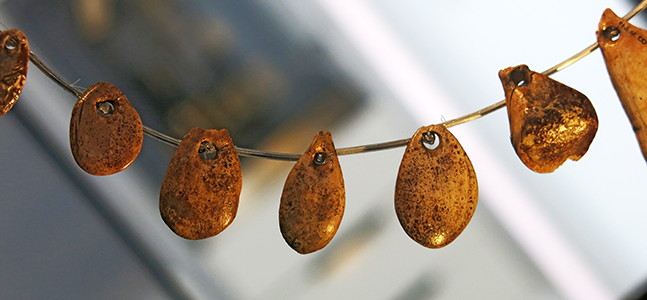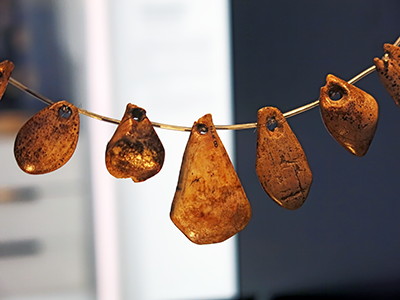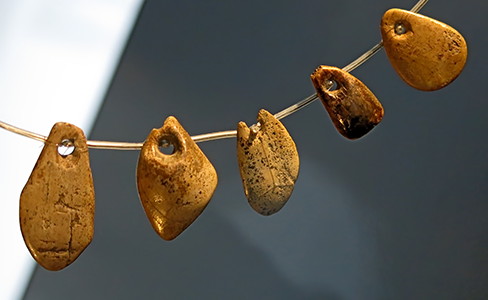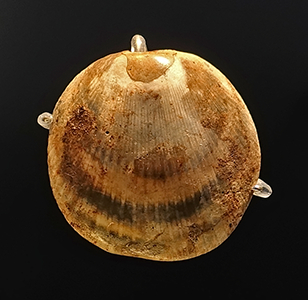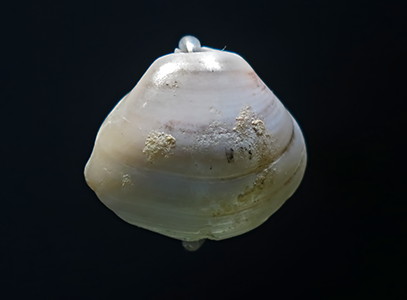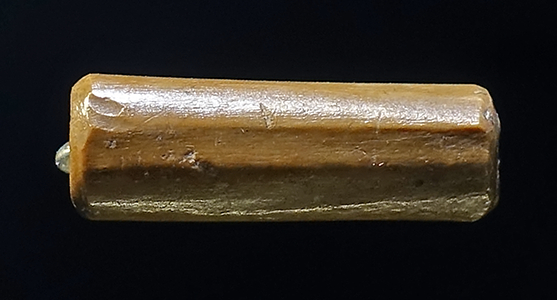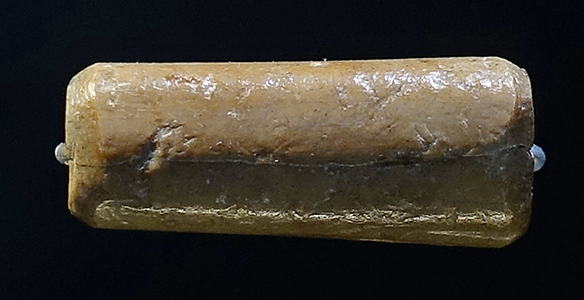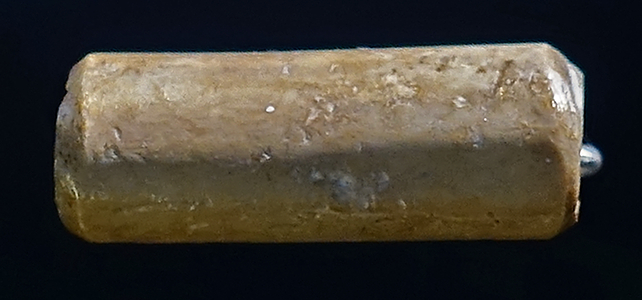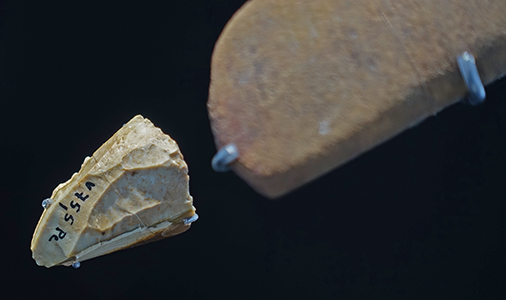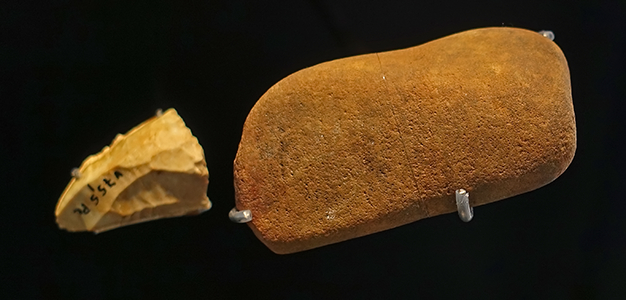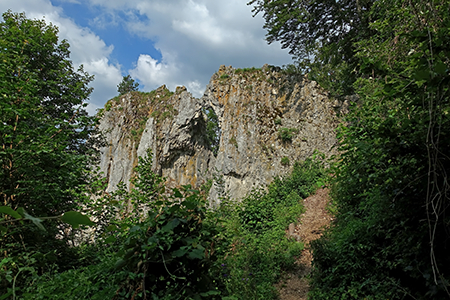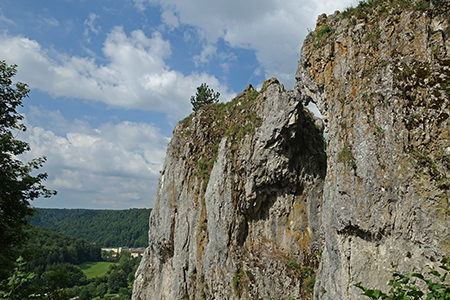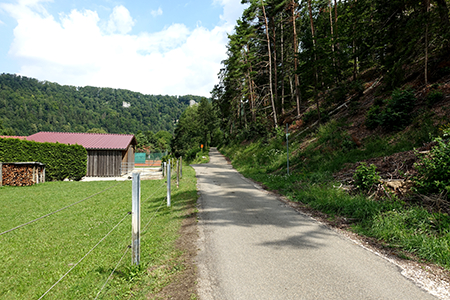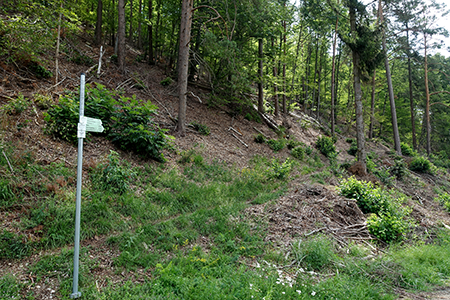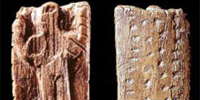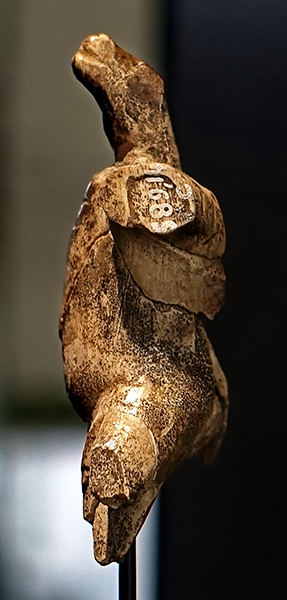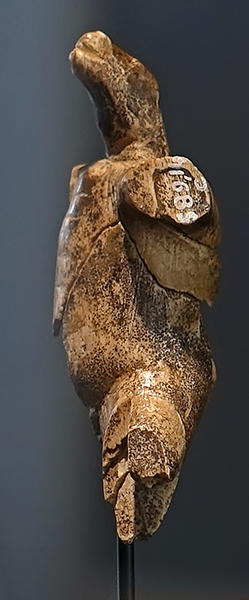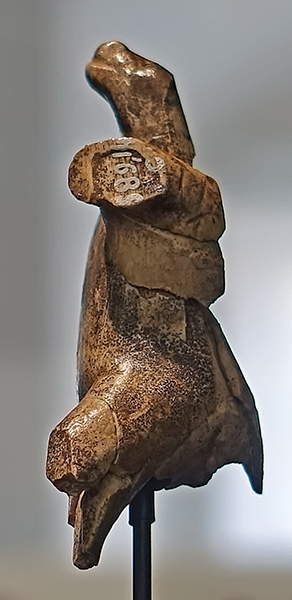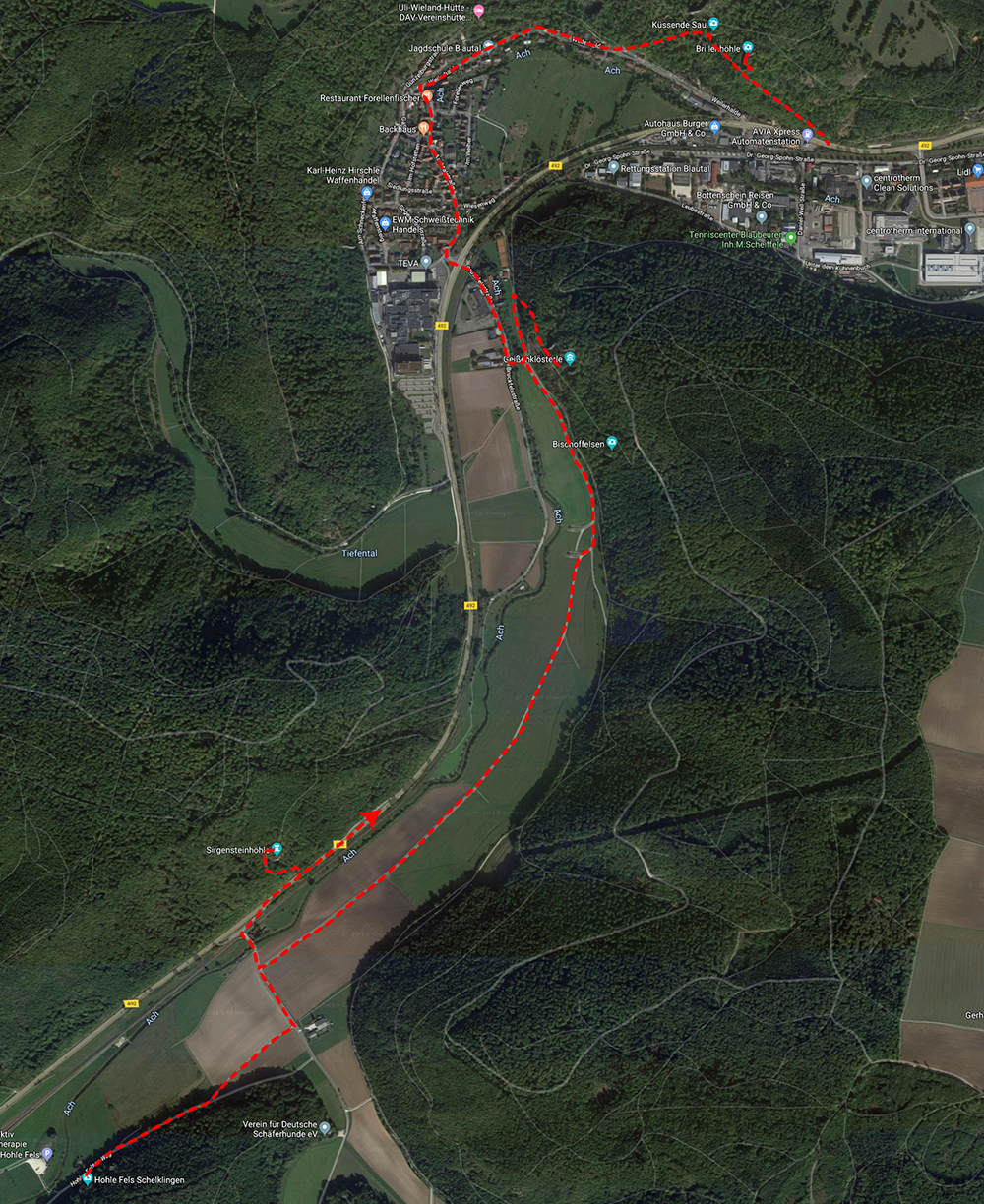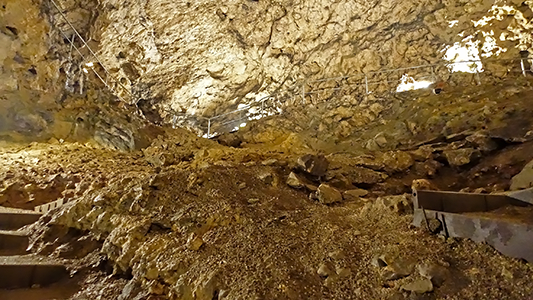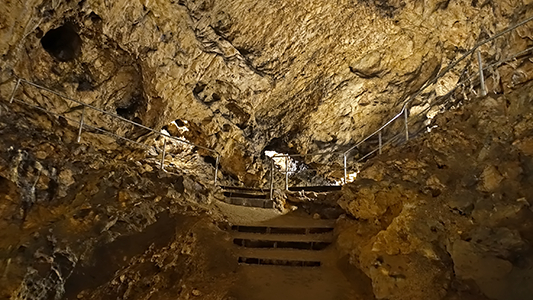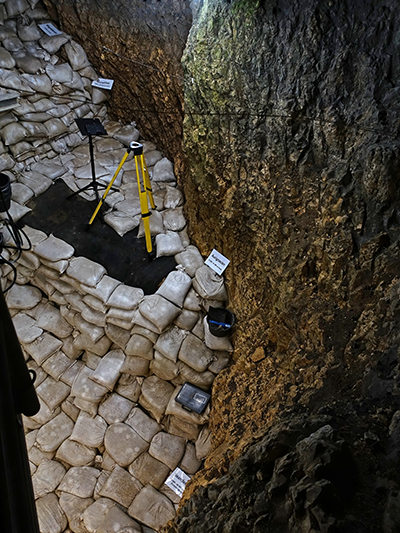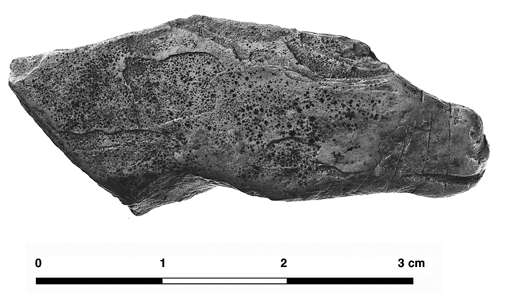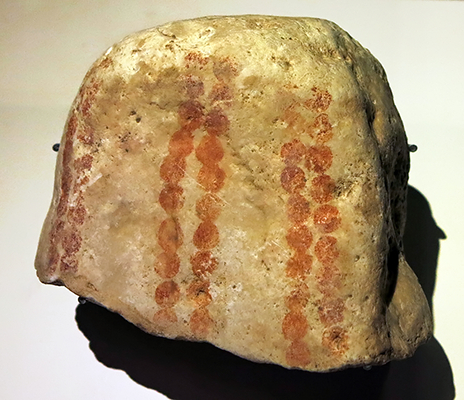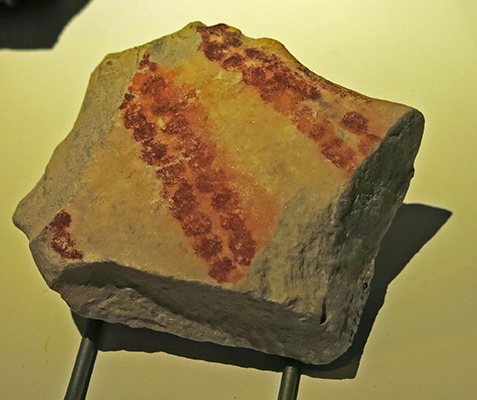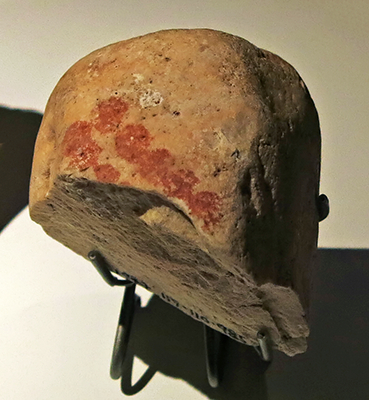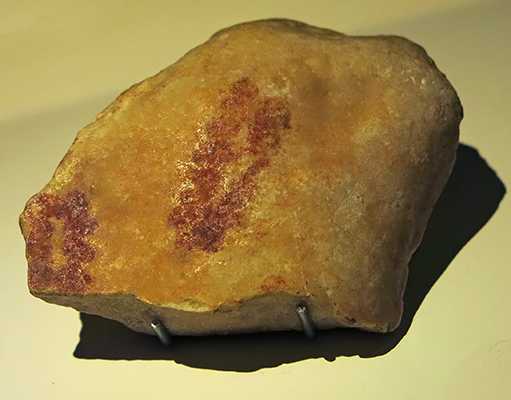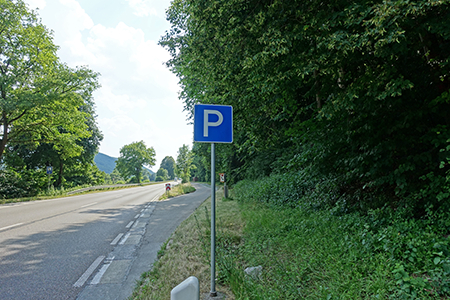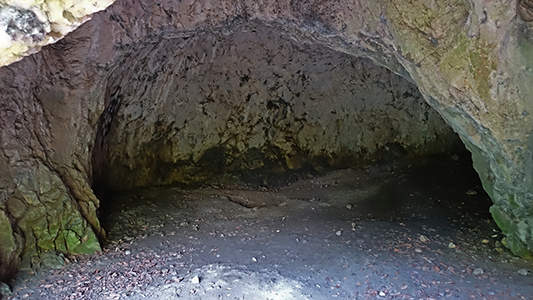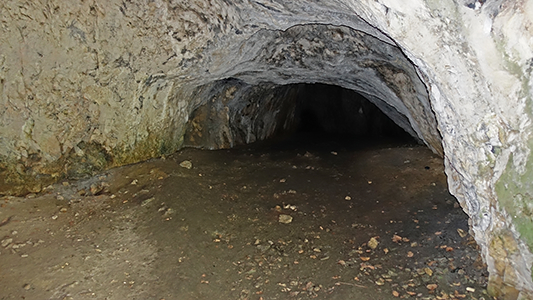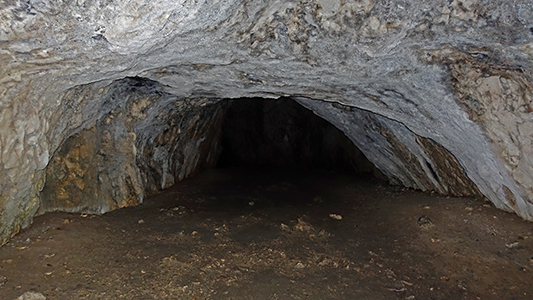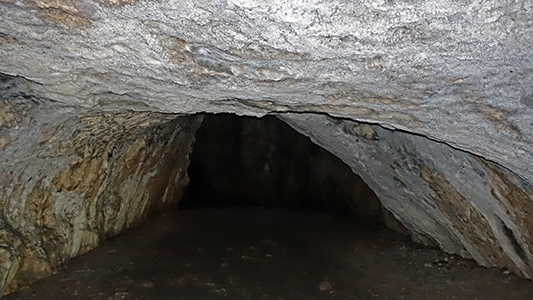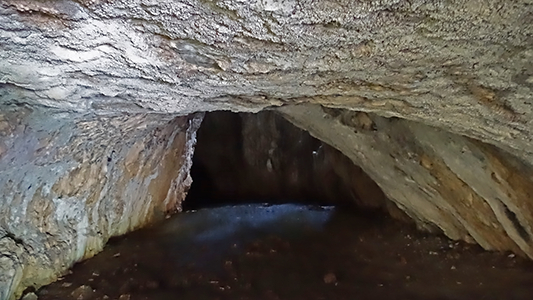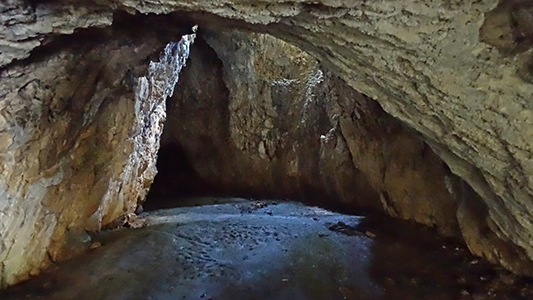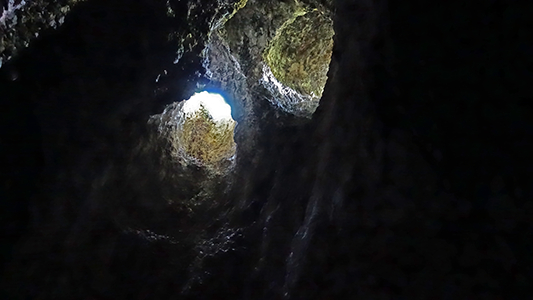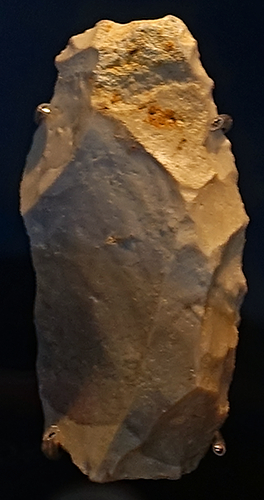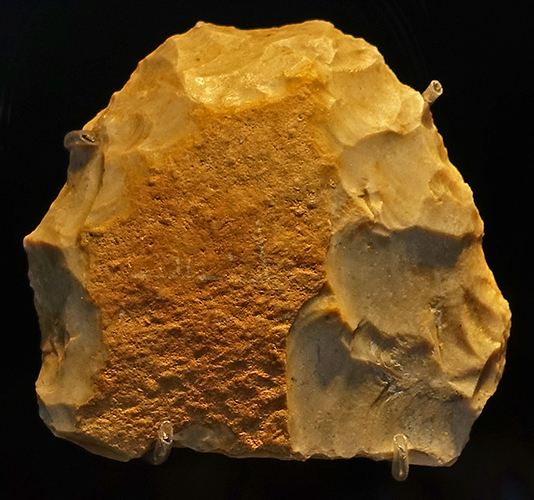The Sites of Geißenklösterle, Hohle Fels, and Middle Paleolithic sites in the Swabian Alb near the city of Ulm
Important areas of ice age art occurred near Ulm (Germany), in the Schwaebische Alb (Swabian Alb), in the valleys of the Ach and Blau river near Blaubeuren (48°24'25.03"N, 09°47'02.67"E) and the Lone valley (48°32'58.27"N, 10°10'16.09"E), where the famous lion/human figure was found in the Hohlenstein-Stadel cave.
A number of world-famous caves, such as the Geißenklösterle, Brillenhöhle ('spectacle cave'), Große Grotte (great cave), Sirgenstein and Hohle Fels cave, can be reached from Blaubeuren on a labelled hiking path and are easily accessible from the important Museum für Ur-und Frühgeschichte (Museum of Prehistory, also known as the Urgeschichtliches Museum) which display the earliest known flutes made of the bone of a swan's wing and the radius of a griffon vulture, as well as one of mammoth ivory (made of two pieces of ivory, hollowed out and glued together!), a museum that displays a gallery of 40 000 years of art.
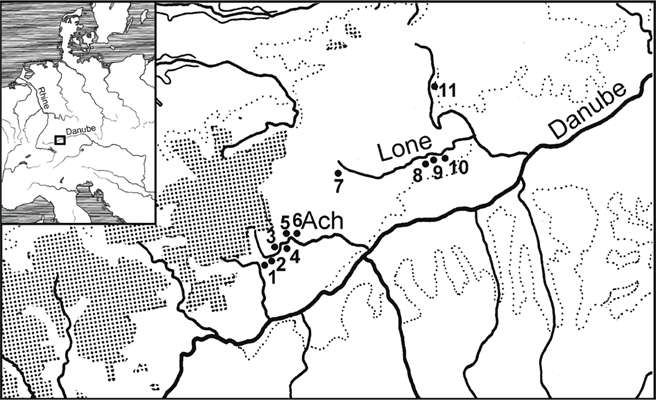
Map showing the major Middle Paleolithic and Aurignacian sites in the Swabian Jura.
1: Kogelstein;
2: Hohle Fels;
3: Sirgenstein;
4: Geißenklösterle;
5: Brillenhöhle;
6: Große Grotte;
7: Haldenstein;
8: Bockstein (Bockstein-Höhle, Bocksteinloch, Bocksteinschmiede, and
Bockstein-Törle);
9: Hohlenstein (Stadel and Bärenhöhle);
10: Vogelherd;
11: Heidenschmiede
(note that the Ach is mislabelled on this map, it is a tributary of the Blau, and should over most of its length shown here, especially as it approaches the Danube, be labelled as the Blau. See the map below - Don )
Photo: Conard et al. 2011
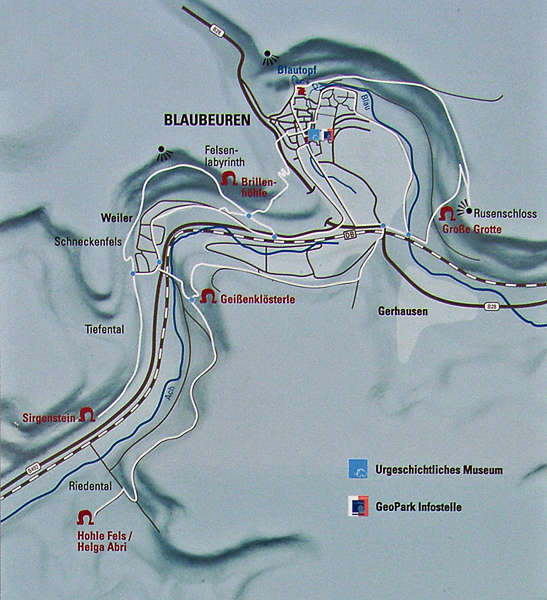
This is an excellent map of the important archaeological sites near Blaubeuren, and the hiking trail which connects them.
The Blautal (Blau valley) and the Schmiechtal (Schmiech valley) are both parts of the former Danube valley. This valley was used by the Danube before and during the ice ages, when it carried even more water than today. As the modern Rhine did not exist then, the Danube also brought water from Switzerland, which goes down the rhine today. At the same time the limestone plateau of the Swabian Jura was lifted by the forces of the Alps orogeny, and subsequently the Danube valley became deeper and deeper. The valley has several cut-off meander spurs, formed as meanders where the river finally has cut through the spur and thus created a shortcut.
During the Ice Ages, since 1.5 million years BP, the Danube brought down an increasing amount of detritus and started to partly fill in the valley it had created. The uplift of the Swabian Jura continued and during the Riß-Eiszeit (120 000 years BP) the Danube started to use a new bed some kilometres to the south. The Blau, Schmiech and Ach rivers today use a valley which they never could have formed.
The spring of the Blau is called Blautopf. The river Ach is not the river Aach in the west of the Swabian Jura, which spring in the Aachtopf, although it is pronounced identical.
Stone Age finds were made in many caves and shelters of the Blau valley. In the Alb-Donau-Kreis, the administrative area belonging to Ulm, archaeological excavations in more than 28 caves were made. In the area belonging to Ehingen 19 caves were excavated. One of the caves was developed as a show cave, the Hohle Fels (Hollow Rock). The age of the oldest finds from this cave was determined, using 14C dating, to be 50 000 years. The time of the highest number of finds, which is assumed to be the time of the most intensive inhabitation, is from about 15 000 to 11 000 years BP.
Höhlenwandertag (Cave Hike)
Every year on Labor Day (the 1st of May), the city of Blaubeuren organizes the Blaubeuren Cave Hike . The goal is to walk a trail of 10 Km leading to the most important excavation sites (aka caves) between Blaubeuren and Schmiechen. These are caves like Hohle Fels, Brillenhöhle, Geißenklösterle and others.
Most of those caves are closed during the year, to protect the archaeological remains. But on this day the archaeologists are on site and visits, with famous archaeologists giving tours and answering questions, are possible.
Photo: Michael Hess
Source: Sign on the hiking trail
Additional text: http://www.showcaves.com/english/de/region/Blautal.html
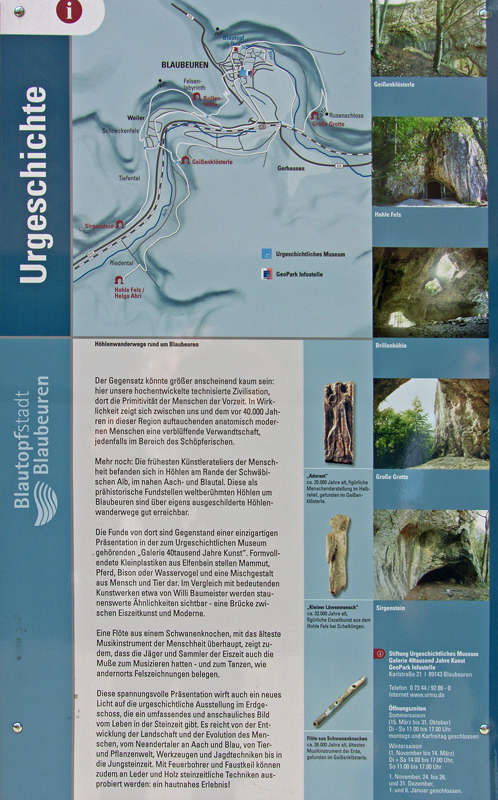
Translation of the sign at left, at the start of a hiking trail which leads the walker on a tour of the caves and important sites near Blaubeuren
The contrast could hardly be greater: here we have our highly developed mechanised civilisation, there, the primitive life of the people of the past. Finds from the local area show that between now and 40 000 years ago there emerged in this region anatomically modern humans with striking abilities in creativity. The earliest artists and craftsmen of mankind were in caves on the edge of the Swabian Alb, near the Ach and Blautal rivers.
These prehistoric sites are famous worldwide, and the caves near Blaubeuren are easily accessible via specially-marked hiking trails.
The finds from these caves are the subject of a unique presentation in the Prehistory Museum Gallery '40 thousand years of art'.
Perfect small sculptures made of ivory depict mammoths, horses, bison or water birds as well as a composite human and lion. Compared with major Kunstwerke.n. about by Willi Baumeister be astonishing similarities visible-a bridge between glacial and modern art.
There are astonishing similarities
Compared with important works of art such as by Willi Baumeister be astonishing similarities visible-a bridge between glacial and modern art.
A bone flute made from a swan wing bone, the oldest musical instrument of all mankind, also shows that the hunters and gatherers of the ice age also had the leisure to make music - and dancing, as elsewhere proved by petroglyphs.
The prehistoric exhibition on the ground floor gives a comprehensive and vivid picture of life in the Stone Age.
The exhibition ranges from the development of the landscape and the evolution of man, to the Neanderthals of the Ach and Blau river valleys, the animal and plant world of that time, to the hunting tools and techniques of the Neolithic period. Fire drills and hand axes can be tried, and up close experiences with leather and wood can be obtained!
Michael writes:
This is a display of the hiking path, at the Blautopf where the paths begins.
In an area north of Ulm, there are further archeologically important places. What is now the Lone valley (near the Autobahn A7, 25 km North of Ulm) was a tropical sea in the Jurassic - the Tethys. The now small, frequently dry creek called Lone meanders through a wide valley confined by the limestone reefs formed by the corals that populated that Jurassic sea. The retreating Tethys left the mighty Ur-Lone, flowing southwards, with its estuary first more to the South near the Alps, later near its present streambed.
Photo: Michael Hess
Source: Sign on the hiking trail
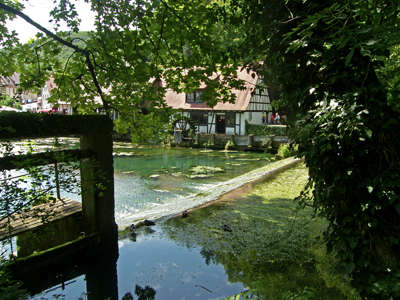
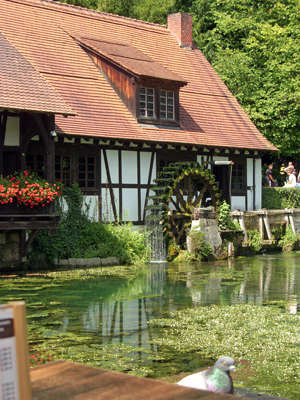
The Water Mill near Blaubeuren, at the spring of the river Blau, the so-called Blautopf (blue pot), where the hiking path starts. The Blautopf is 21 metres deep and gives access to a large subterranean system of rivers and lakes in caves under the Alb.
The blue colour of the water is due to the high concentration of dissolved lime.
Photo and text: Michael Hess
Brillenhöhle
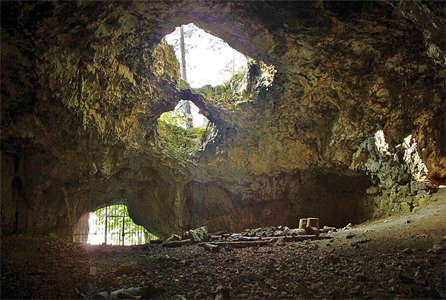
Between 30 000 and 12 000 years ago people lived in the Brillenhöhle and left numerous tools, jewellery and the remains of the hunt. It is assumed it was used mostly in winter and spring. Large fireplaces show that the cave was used extensively. A wall of stones was once built there for protection against the cold, and was probably used as a wall for a tent built in the cave. Geißenklösterle and the Brillenhöhle were used at the same time.
The Brillenhöhle is so called because of the two large holes in the roof which look like huge spectacles. They provide light and an exit for smoke from fires.
Photo: http://www.blaubeuren.de/de/Tourismus/H%C3%B6hlen/Brillenh%C3%B6hle
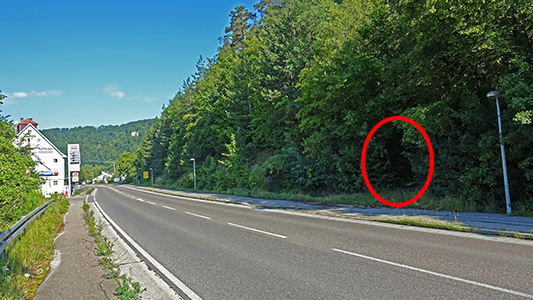
I had come by train, and decided to join the track at the closest point to the Brillenhöhle, rather than walking all the way through the town, and starting at the Blautopf where the path officially begins.
Finding the start of the track up to the Brillenhöhle at this point is not easy, since it is not marked. I walked up and down this section of road, asked in a number of shops (who knew nothing about it!) and finally asked an elderly lady wheeling her bicycle across the road where it was. She pointed up to the side of the very steep slope, tracing the path with her finger, and from that I was able to work out where the entry had to be.
I have marked the entry with a red oval on this thumbnail. Click on it, as always, to see the original photo. The unmarked entry is just a small opening in the forest near the AVIA Xpress Automatenstation which can be seen in this photograph.
Photo: Don Hitchcock 2018
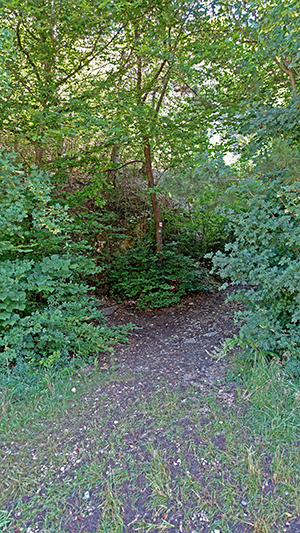
After you have entered the opening in the forest, the track leads up by steps to the left.
The main path from the Blautopf comes in from the right.
Photo: Don Hitchcock 2018
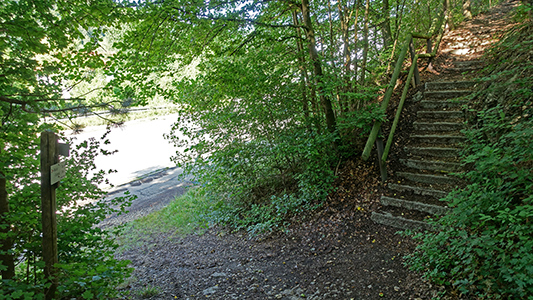
Once you are actually on the track, it is well signposted. The track leads up the steps, with handrails at a suitable height for both adults and children.
Photo: Don Hitchcock 2018
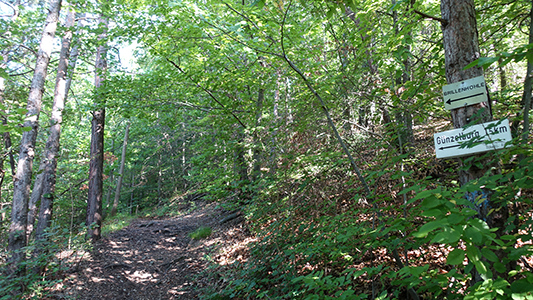
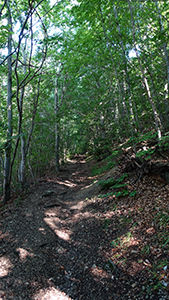
The track is a pleasure to walk on.
Photo: Don Hitchcock 2018
Looking back down the track, and a few minutes later the signpost to the 200 metre long side track leading upwards to the right to the Brillenhöhle appears.
Photo: Don Hitchcock 2018
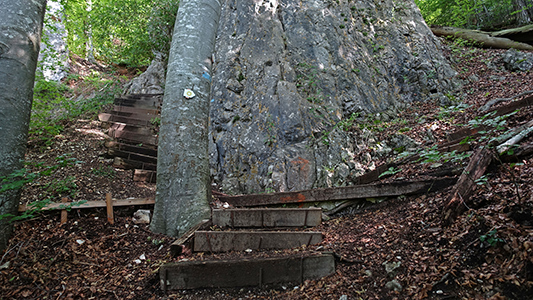
The track becomes quite steep just before the cave.
Photo: Don Hitchcock 2018
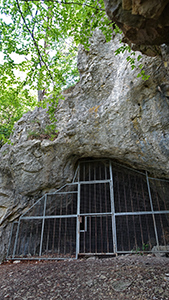
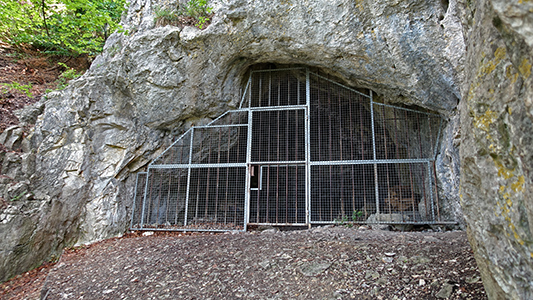
And finally the gated entrance to the Brillenhöhle is reached.
Photo: Don Hitchcock 2018
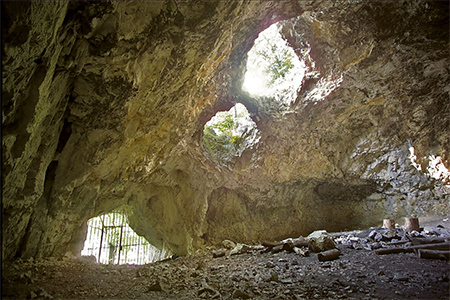
The gate is opened only for researchers or on special occasions. At one time local teenagers used to use the cave for parties.
Photo: https://www.blaubeuren.de/de/Tourismus/Wandern/Eiszeitjaegerpfad
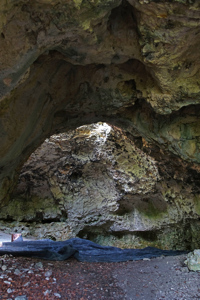

However it is possible to take photos through the mesh.
Photo: Don Hitchcock 2018
The Brillenhöhle 28 000 BP
The Gravettian (29 000 - 21 000 BP) layers in particular of this site provide an extremely vivid picture of the various activities of hunters and collectors in their winter camp.
Flint and the remains of a pattern of stones point to the intensive use of the cave. Narrow small points from flint were inserted into lance tips. Probably at that time the spear thrower was invented.
(top row, left to right) Lissoir, hide polisher, horse rib; Awl, metatarsal bone; straightened rod, reindeer antler; projectile point, reindeer antler (the last repeated in closeup photo).
(second row, left to right) Three beads, mammal bone; Two drills and a scraper, in radiolarite and Jurahornstein, Jurassic chert.
Photo: Don Hitchcock 2018
Source and text: Landesmuseum Württemberg, Stuttgart
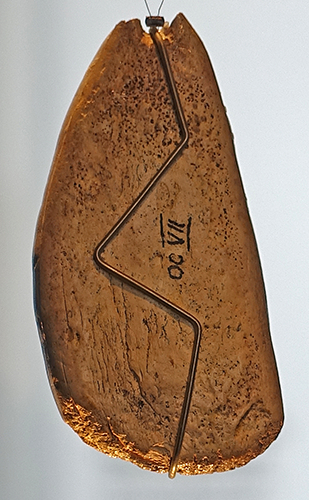
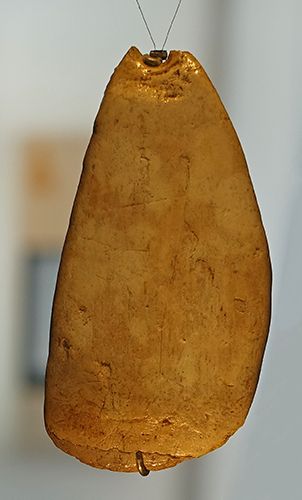
Pendant, back and front.
Power and beauty - jewellery and art are often inextricably linked.
Brillenhöhle, Blaubeuren-Weiler, Alb-Donau-Kreis, Gravettien, circa 28 000 - 25 000 BP
Photo: Don Hitchcock 2018
Source and text: Landesmuseum Württemberg, Stuttgart
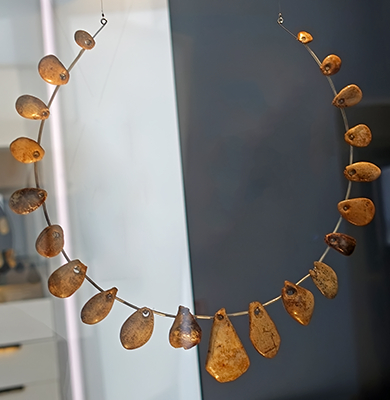
Necklace, mammoth ivory.
Much has been gathered, carved and pierced, threaded and worn on the neck, such as pendants and necklaces from ivory, fox teeth, or even seashells from the Atlantic and Mediterranean. They were probably both signs of their clan as well as their own identity.
Brillenhöhle, Blaubeuren-Weiler, Alb-Donau-Kreis, Gravettien, circa 28 000 - 25 000 BP
Photo: Don Hitchcock 2018
Source and text: Landesmuseum Württemberg, Stuttgart
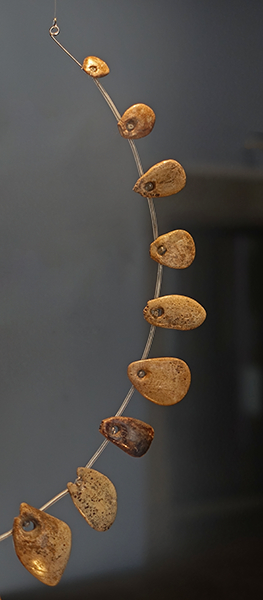
Necklace , closeups.
Brillenhöhle, Blaubeuren-Weiler, Alb-Donau-Kreis, Gravettien, circa 28 000 - 25 000 BP
Photo: Don Hitchcock 2015, 2018
Source and text: Landesmuseum Württemberg, Stuttgart

Mammoth ivory - the raw material par excellence.
The two main methods for making beads of this type from mammoth ivory are shown here.
The method on the left is suited to manufacturing large numbers of beads, all of similar shape and size.
During the Gravettian in the Ach Valley near Blaubeuren many mammoth tusks were processed into beads and spearheads. The production of beads from ivory is shown here in all its phases from the blank to the polished bead. The material was used because of its nature - hard yet elastic at the same time, and easy to work with.
Artist: Unknown
Rephotography: Don Hitchcock 2015
Source and text: Landesmuseum Württemberg, Stuttgart
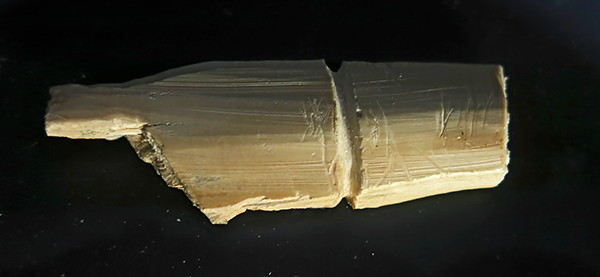
First, a piece of mammoth ivory is detached from the tusk, and the piece to be turned into a bead is scored and broken off.
Photo: Don Hitchcock 2015
Source: Landesmuseum Württemberg, Stuttgart

Next, the bead is roughly carved and ground to shape, and a hole is created with a borer.
Photo: Don Hitchcock 2015
Source: Landesmuseum Württemberg, Stuttgart

Further shaping and polishing is then undertaken, and the hole is refined with a suitable borer.
Photo: Don Hitchcock 2015
Source: Landesmuseum Württemberg, Stuttgart
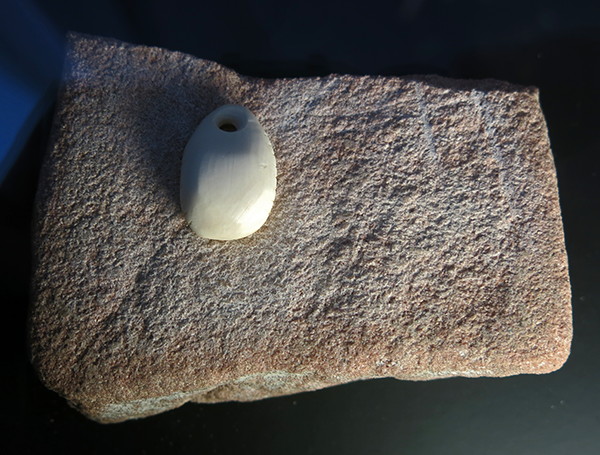
Finally, the bead is ground to its final shape, as here, on sandstone, then the final polish is obtained with a much finer abrasive surface than that shown here.
Photo: Don Hitchcock 2015
Source: Landesmuseum Württemberg, Stuttgart
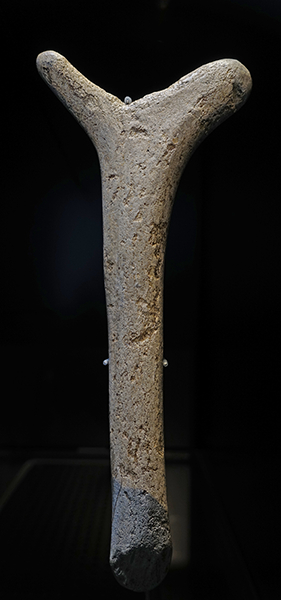
Drum stick
Reindeer antler
Drum Mallet, Reindeer antler, Brillenhöhle, Blaubeuren-Seissen, Alb-Donau-Kreis.
From the Magdalenian, 12 000 BP.
Photo: Don Hitchcock 2018
Source and text: Landesmuseum Württemberg, Stuttgart

Fragment of a female figure, mammoth ivory, Brillenhöhle, Blaubeuren-Seißen, Alb-Donau-Kreis.
From the Gravettian, 28 000 BP - 24 000 BP.
Photo: Don Hitchcock 2015
Source and text: Landesmuseum Württemberg, Stuttgart



Three notched sticks.
Mammoth ivory.
( Note that the museum card states that they were used as hairpins. As my colleague Ann Dayton pointed out, ( pers. comm. August 2018 ) this is unlikely. She writes:
As someone with long hair who has used a number of different hair pins, I would never consider using any of those in my hair. Nearly all my pins are smooth and straight. The ones that aren't are wavy. These would snag hair, and would probably break when trying to get them out.
- Don )
Brillenhöhle, Blaubeuren-Seissen, Alb-Donau-Kreis.
From the Gravettian, 28 000 - 25 000 BP
Photo: Don Hitchcock 2015, 2018
Source and text: Landesmuseum Württemberg, Stuttgart

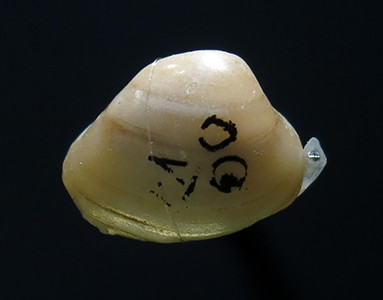
Five perforated bivalve shells.
Brillenhöhle, Blaubeuren-Seissen, Alb-Donau-Kreis.
From the Gravettian, 28 000 - 25 000 BP
Photo: Don Hitchcock 2015, 2018
Source and text: Landesmuseum Württemberg, Stuttgart
Four tubular beads, in bone.
Brillenhöhle, Blaubeuren-Seissen, Alb-Donau-Kreis.
From the Gravettian, 28 000 - 25 000 BP
Photo: Don Hitchcock 2018
Source and text: Landesmuseum Württemberg, Stuttgart
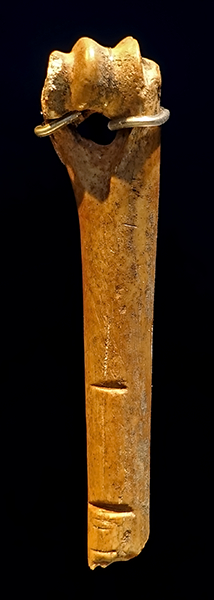
Pierced animal bone decorated with notches.
Brillenhöhle, Blaubeuren-Seissen, Alb-Donau-Kreis.
From the Gravettian, 28 000 - 25 000 BP.
Photo: Don Hitchcock 2015
Source and text: Landesmuseum Württemberg, Stuttgart

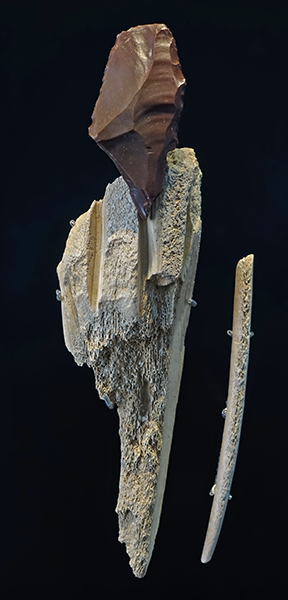
To produce a spearpoint, two parallel grooves were first cut longitudinally into an antler, in order subsequently to pry out the thus preformed rod.
The pierced baton was then used to bend it straight, after treatment by soaking in hot water, drying for a day or two after binding the piece to a straight piece of wood, to maintain the straightness, and the tip was then filed to a point.
(left) Reindeer antler, used for rod production, circa 14 000 - 12 000 BP. Bad Schussenried, Kreis Biberach, Magdalenian. On loan from Staatlichen Museums für Naturkunde Stuttgart
(right) Production waste from making rods from reindeer antler and a burin, (shown in position in the groove), radiolarite, as well as a carved out, and in some respects further processed, rod of reindeer antler.
Brillenhöhle, Blaubeuren-Seissen, Alb-Donau-Kreis, Magdalenian, circa 14 000 - 12 000 BP.
Photo: Don Hitchcock 2015, 2018
Source and text: Landesmuseum Württemberg, Stuttgart
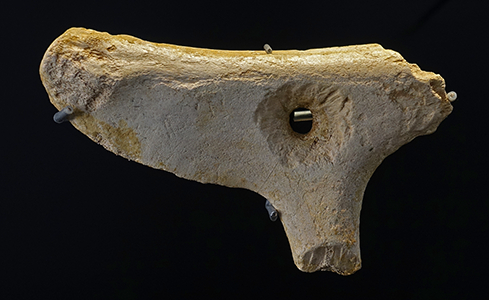
Pierced baton, reindeer antler.
Brillenhöhle, Blaubeuren-Seissen, Alb-Donau-Kreis, Magdalenian, circa 14 000 - 12 000 BP.
Photo: Don Hitchcock 2018
Source and text: Landesmuseum Württemberg, Stuttgart
Barbed death
Although Neanderthals had already produced pointed spears, sharpening and fire hardening one end, attached points made of ivory, antler and bone only become a standard technique with anatomically modern humans.
Harpoons, however, were only invented about 15 000 years ago. The head (usually antler or bone) is provided with barbs and detaches from the shaft as soon as it penetrates the animal's body. The detachment of the head reduces the likelihood of the shaft breaking, and the harpoon head remains connected to either the hunter or the shaft of the spear by a cord or strap. In addition, replacement of a damaged harpoon head with a spare is easy in the field.
Five harpoons, reindeer antler, partly decorated with notches, Brillenhöhle, Blaubeuren-Seissen, Alb-Donau-Kreis, Magdalenian, circa 16 000 BP - 12 000 BP
Photo: Don Hitchcock 2018
Source and text: Landesmuseum Württemberg, Stuttgart
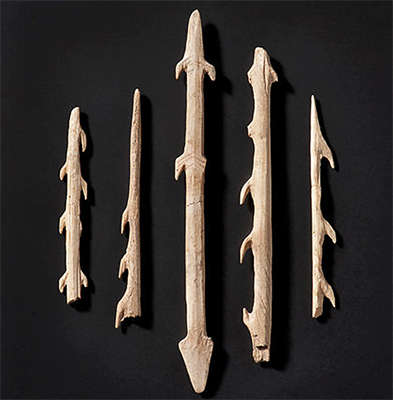
Harpoon points, ca 12 000 BP
Bone and antler
Brillenhöhle bei Blaubeuren, Alb-Donau-Kreis
Harpoons were invented about 15 000 years ago by reindeer hunters. The head piece is provided with a marked bone or antler barbed tip. The spear shaft was made of wood and is hardly ever found. The actual projectile - the top - detaches from the shaft once it has penetrated into the animal body. It is usually connected by a short thong to the shaft. This meant that the harpoon and its shaft were much less likely to be broken, and either could then be easily replaced in the field.
When thrown with an atlatl or spearthrower, a fatal hit could be made from a distance of 100 metres. The harpoon points are in the permanent collection 'LegendäreMeisterWerke', at Landesmuseum Württemberg, Stuttgart.
Photo: http://www.landesmuseum-stuttgart.de/sammlungen/archaeologie/alt-und-mittelsteinzeit/harpunenspitzen/
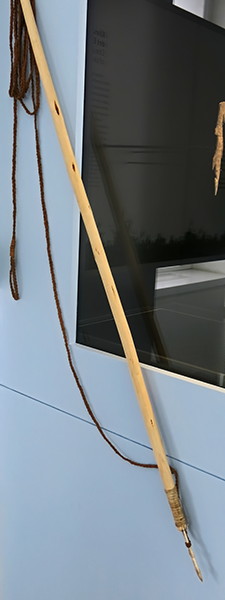
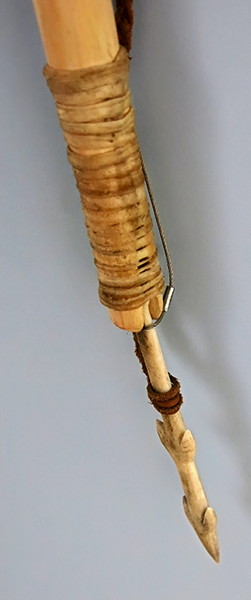
Modern reproduction of a harpoon with shaft.
The harpoon head and bindings are usually designed, as here, so that the head comes away from the shaft on impact, so that the shaft comes free and is not damaged, and the fish or other prey can be hauled in by the hunter with the cord or leather thong attached to the harpoon head.
If the harpoon head itself is damaged, it is a simple matter to replace it in the field.
Photo: Don Hitchcock 2015
Source: Landesmuseum Württemberg, Stuttgart
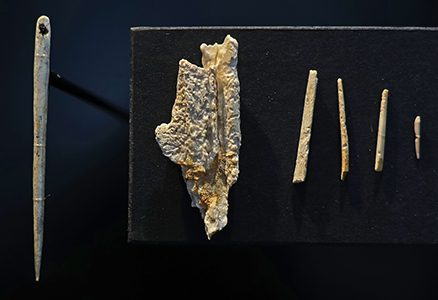
Left to right:
Sewing needle, bone.
Provenance: Petersfels, Engen-Bittelbrunn, Kreis Konstanz.
Needle blank with negatives of sewing needles, bone.
Four sewing needles, bone.
Provenance: Felsställe, in the Kirchener Tal near Ehingen-Mühlen, 30 km southwest of Ulm.
Photo: Don Hitchcock 2018
Source: Landesmuseum Württemberg, Stuttgart
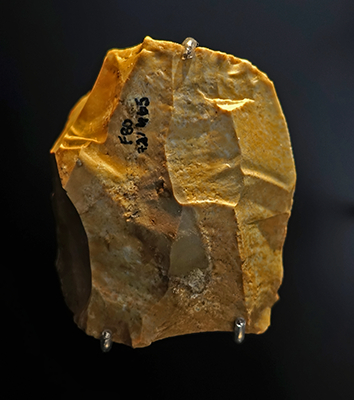
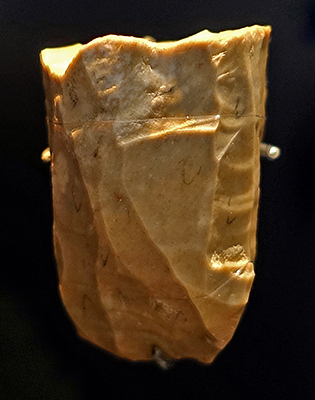
The remains of two cores from Felsställe, in the Kirchener Tal near Ehingen-Mühlen, 30 km southwest of Ulm.
Photo: Don Hitchcock 2018
Source and text: Landesmuseum Württemberg, Stuttgart
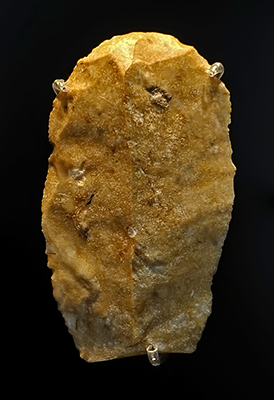
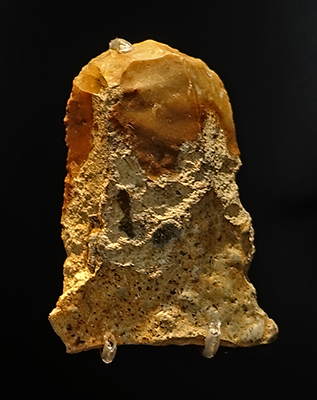
Two scrapers, Jurahornstein, Jurassic chert, Felsställe.
Photo: Don Hitchcock 2018
Source and text: Landesmuseum Württemberg, Stuttgart
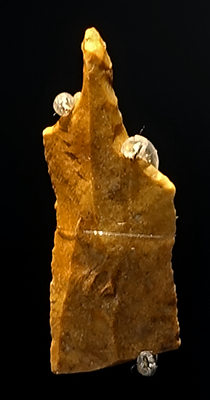
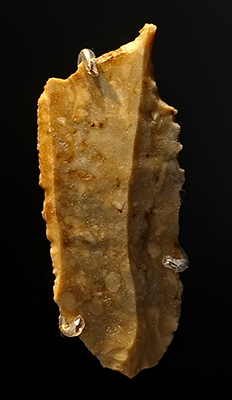
Two drills, Jurahornstein, Jurassic chert, Felsställe.
Photo: Don Hitchcock 2018
Source and text: Landesmuseum Württemberg, Stuttgart
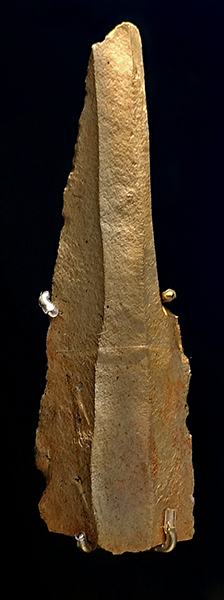
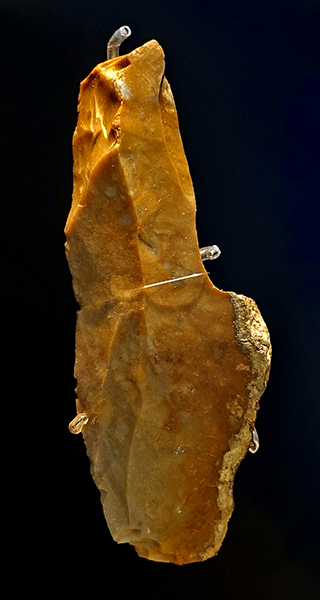
Two burins, Jurahornstein, Jurassic chert, Felsställe
Photo: Don Hitchcock 2018
Source and text: Landesmuseum Württemberg, Stuttgart

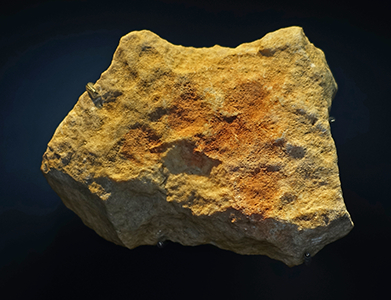
Left: Harpoon fragment, reindeer antler, Vogelherdhöhle, Stetten ob Lontal (30 km northeast of Ulm)
Right: Limestone with daubs of red ochre, Brillenhöhle, Blaubeuren-Weiler
Photo: Don Hitchcock 2018
Source and text: Landesmuseum Württemberg, Stuttgart
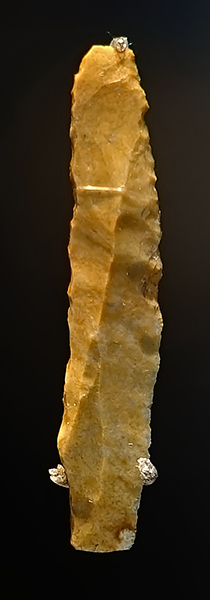


Three backed bladelets, Jurahornstein, Jurassic chert, Felsställe
Felsställe is in the Kirchener Tal near Ehingen-Mühlen, 30 km southwest of Ulm.
During the Gravettian period, the rather inhospitable climate of the Swabian Jura seems to have allowed no more than sporadic settlement. In these dry and cold times, the region was dominated by steppe and tundra landscapes covered with little more than grasses and herbs. Only a few robust tree species like pines, birches and willows managed to grow in well-protected spots.
In the cold and dry conditions, the sparsely wooded steppe with roaming herds of mammoths gradually became a tree-less tundra grazed by wild horses and reindeer. And as Alpine glaciers advanced further and further south in these climatic conditions, the Blaubeuren region, (the Blautal and Schmiechtal) ultimately became uninhabitable for millennia. The Gravettian period, which began 29,000 years ago and continued for some 8 000 years, was named after the French site of La Gravette (Dordogne).
The first sewing needles were invented during the long nights spent in winter quarters.
The finds from caves and hunting camps 12 000 to 14 000 years ago prove the outstanding importance of reindeer hunting. They also provide insights into daily life. It is now known that the sewing needle with an eye was invented almost 20 000 years ago and harpoons were used for the first time around 15 000 years ago. In addition, red-spotted stones with abstract patterns appeared, which are regarded as specific ciphers or codes for the spiritual world.
Photo: Don Hitchcock 2018
Source and text: Landesmuseum Württemberg, Stuttgart

Blade core, radiolarite.
( Radiolarite is a high quality material for stone tools, and in this region is quite dark, but sometimes of this attractive red-brown chocolate colour - Don )
From Brillenhöhle, Blaubeuren-Weiler.
Photo: Don Hitchcock 2018
Source and text: Landesmuseum Württemberg, Stuttgart
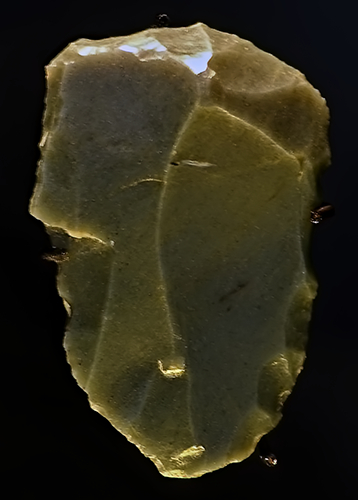

Scrapers, Jurahornstein, Jurassic chert, and dark Radiolarite.
From Brillenhöhle, Blaubeuren-Weiler.
Photo: Don Hitchcock 2018
Source and text: Landesmuseum Württemberg, Stuttgart

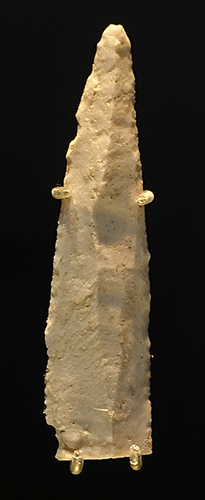
Projectile points, Jurahornstein, Jurassic chert, and Radiolarite.
From Brillenhöhle, Blaubeuren-Weiler.
Photo: Don Hitchcock 2018
Source and text: Landesmuseum Württemberg, Stuttgart



Left to right:
Projectile point, reindeer antler, Brillenhöhle, Blaubeuren-Seissen, Alb-Donau-Kreis, Aurignacian, circa 24 000 BP
Two projectile points, with beveled bases on both sides, Brillenhöhle, Blaubeuren-Seissen, Alb-Donau-Kreis, Magdalenian, circa 16 000 BP - 12 000 BP
Photo: Don Hitchcock 2018
Source and text: Landesmuseum Württemberg, Stuttgart
Core, Jurahornstein, Jurassic chert, and hammer.
Core from Petersfels, Engen-Bittelbrunn, Kreis Konstanz, Magdalenian, circa 14 000 BP - 12 000 BP.
(Sledge) Hammer of sandy limestone, Brillenhöhle, Blaubeuren-Weiler, Alb-Donau-Kreis, Magdalenian, circa 14 000 BP - 12 000 BP.
Photo: Don Hitchcock 2018
Source and text: Landesmuseum Württemberg, Stuttgart
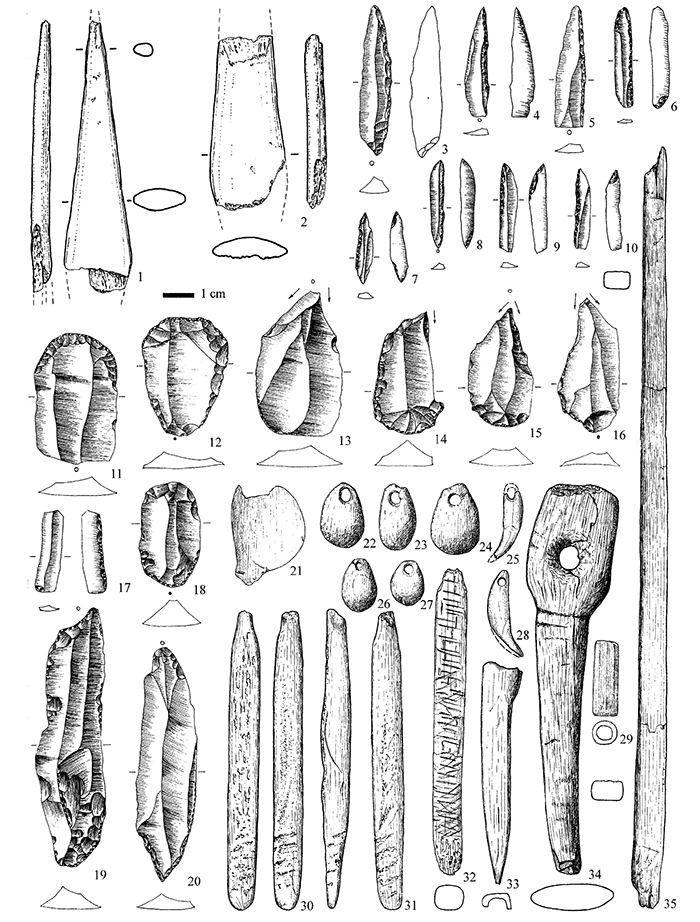
Aurignacian of Brillenhöhle XIV (1-2) and Gravettian of Brillenhöhle VII (3-35).
(1) bone point (with split base?)
(3–5) Gravette points
(6–10) micro-Gravette points
(11–12, 18) end scrapers
(13, 16) burins
(14–15) burins combined with endscrapers
(17) ventrally retouched bladelet
(19) truncated blade
(20) blade retouched on both ends
(21) fragment of an ivory figurine
(22-24, 26-27) teardrop-shaped ivory pendants
(25, 28) perforated canines
(29) bone tube
(30-31, 35) bone projectile points
(32) bone rod (decorated?) with incisions
(33) bone awl
(34) bâton percé of ivory
Photo and text: Conard & Bolus (2003)
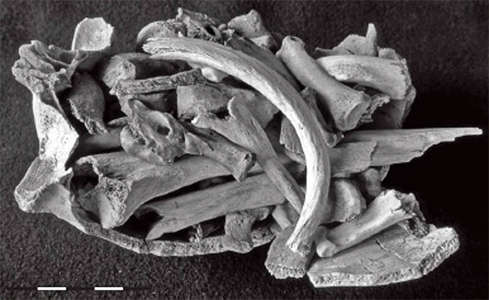
The human remains from Brillenhöhle. Picture showing a possible infill of the fragments in
the skull cap. 38 cranial and postcranial remains from a Magdalenian context in the Brillenhöhle in the Swabian Alb, Germany, reflect the process of secondary burial (Orschiedt 1997, 1999, 2002). The remains belong to at least three individuals, two adults and a child.
A direct AMS 14C measurement on a cranial fragment of 12 470 ± 65 BP (OxA-11 054) confirms the Magdalenian attribution. The remains were recovered from a hearth located centrally within the cave, and taphonomic or other factors for their positioning can be eliminated (Orschiedt 2002). Although the bones were considered to have been burnt, discolouration on the bone originates from ash and no traces of burning are present, and they seem to have been placed atop the hearth containing ashes from a bone fire (Orschiedt 1999) The study of the modifications has revealed evidence of dismemberment, defleshing, and careful 'cleaning' of the soft tissue from the bones probably shortly after death and prior to this deposition.
There are significant differences in the number and type of cutmarks on the bones compared with processed faunal remains from Magdalenian sites. The human remains from Brillenhöhle reveal a cutmark frequency of 64 %, compared to faunal assemblages with good bone preservation that show a frequency of 21% to 26%, (Orschiedt 1999, 2002) revealing that the majority of cutmarks on the human remains did not result from 'normal' butchery, but from defleshing that was considerably more intense and careful. The aim was evidently to free the skeletal remains as far as possible from soft tissue (Orschiedt 2002).
Cutmarks on phalanges, which are very rare among faunal assemblages, indicate careful skinning of the individuals, and marks on the crania indicate detachment from the cervical vertebra and scalping. The lack of long bones and dominance of cranial parts indicates that deliberate selection took place, i.e., the removal of all but the smallest anatomical elements and fragments. All of the recovered bones fit into the fragment of a skull cap, suggesting that it may have functioned as a container in which the retained remains were taken to the hearth. This might be a striking similarity to the suggested 'calotte containers' from Le Placard.
Photo: Orschiedt (2002)
The walk from the Brillenhöhle to Geißenklösterle
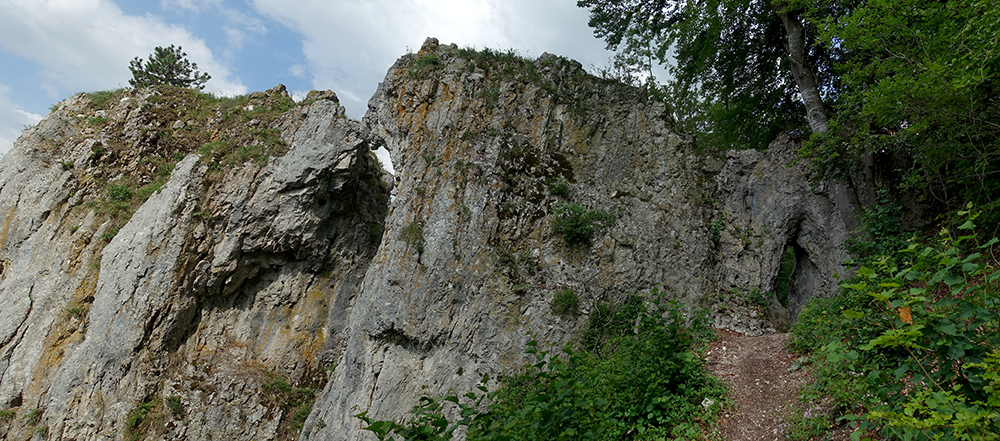
Panorama of the kissing sow.
Photo: Don Hitchcock 2018

On coming back down the hill from the Brillenhöhle, I turned right towards the Felsenlabyrinth and Geißenklösterle.
Photo: Don Hitchcock 2018
Just 200 metres down the track, the 'Kissing Sow' rock formation appears.
Photo: Don Hitchcock 2018
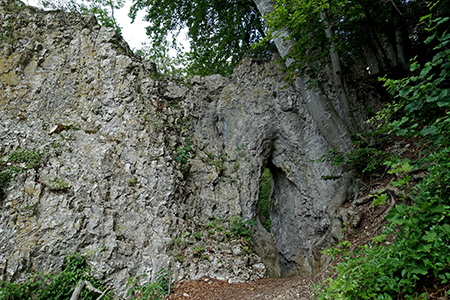
The track continues past this formation through a natural arch in the rock.
Photo: Don Hitchcock 2018
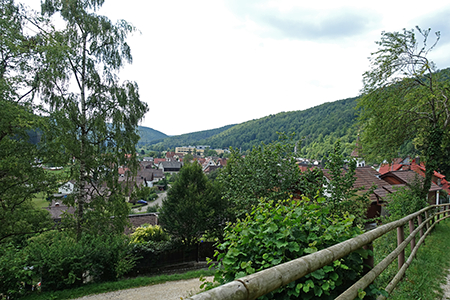
About 800 metres further on you reach the outskirts of the village of Weiler.
Photo: Don Hitchcock 2018
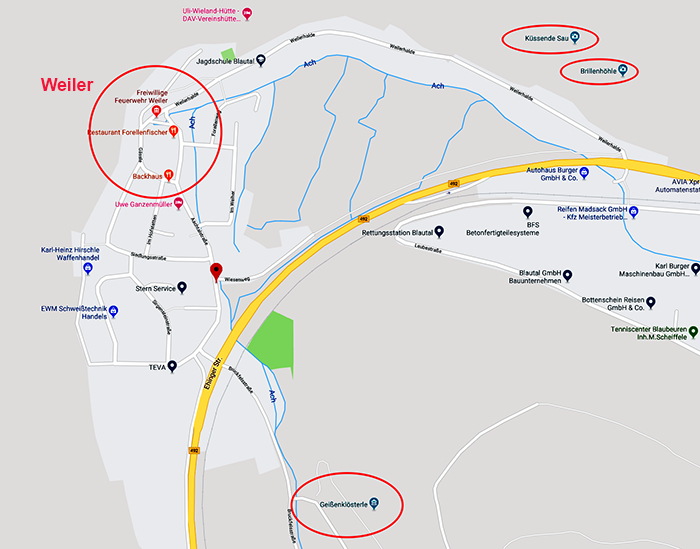
You cross the highway and the railway line to get to Geißenklösterle.
(As always, click on the small image to see the full size version.)
Photo: after Google Maps
Geißenklösterle
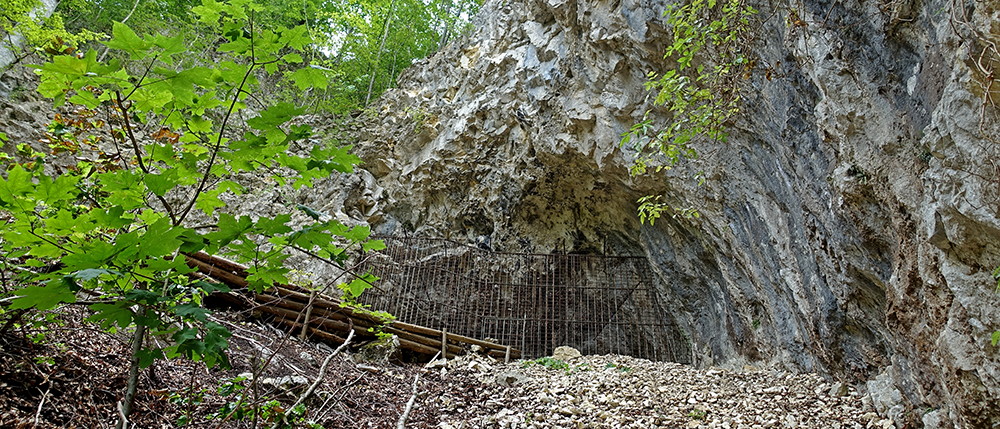
Geißenklösterle Cave
Photo: Don Hitchcock 2018
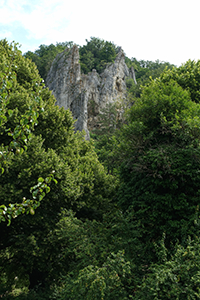
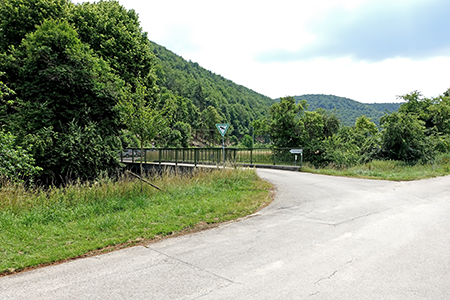
There is no sign, but it is obvious from the map that you have to cross the Ach river by this bridge to get to the start of the ascent to Geißenklösterle, which is barely visible in the left hand photo through the trees lining the Ach.
Photo: Don Hitchcock 2018
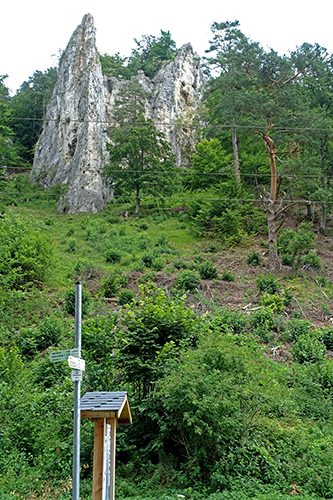
The T junction in the road across the bridge has parking for cars, and an information board.
It would be possible to scramble up this steep slope to Geißenklösterle, but there is a path from the road whose entrance is to the left of this view.
Photo: Don Hitchcock 2018
A short distance down the minor road to the left is the start of the 200 metre long path to Geißenklösterle, heading up the slope to the right just before the wooden building.
Photo: Don Hitchcock 2018

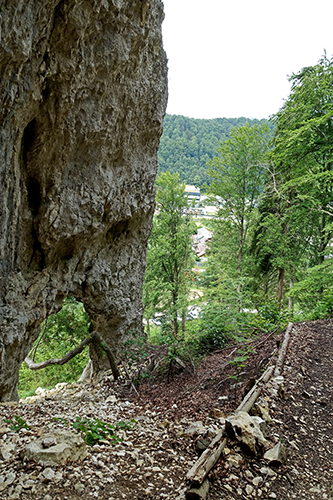
There is a steep short path to the cave at this point, leading through a small arch with a tree growing through it to get to the cave entrance.
Photo: Don Hitchcock 2018
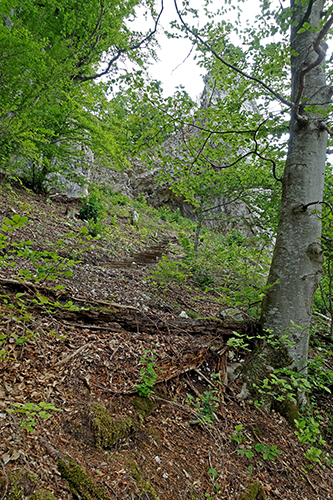
You can instead continue up the more circuitous path.
Photo: Don Hitchcock 2018
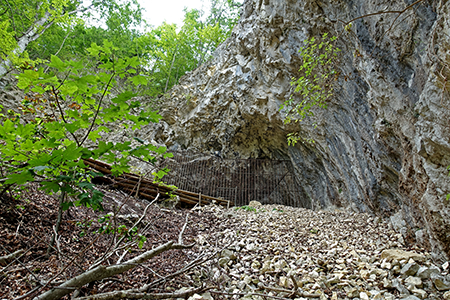
In either case, the gated entrance to the cave is soon gained.
Photo: Don Hitchcock 2018

The cave is still under investigation, and the vertical cords are there to fix the position of excavations and finds.
Photo: Don Hitchcock 2018

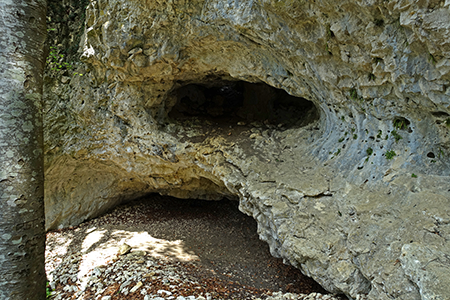
There are other caves close by, which have been excavated, but are sterile.
Photo: Don Hitchcock 2018
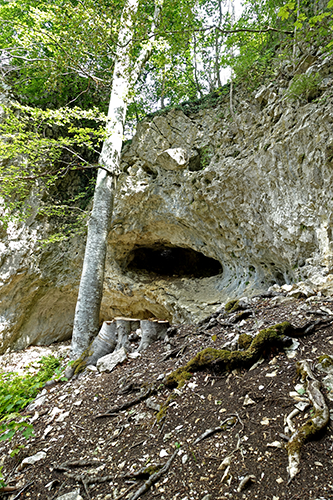
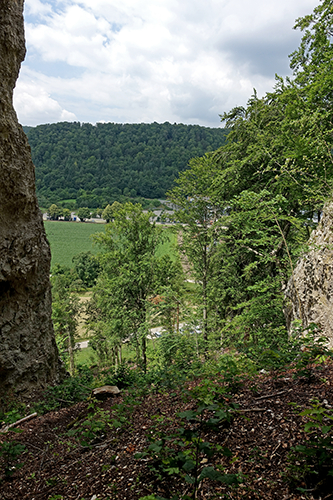
From this point, the valley is 60 metres below.
Photo: Don Hitchcock 2018
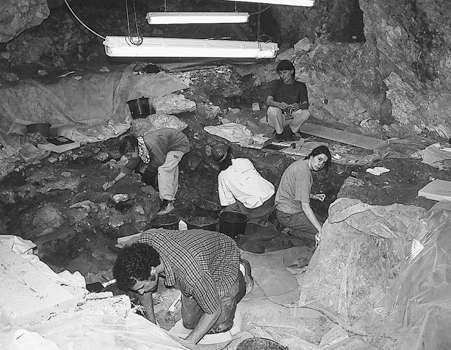
Geißenklösterle. Excavations in August 2001 in the middle Palaeolithic and the deepest layers of the Aurignacian.
Excavations have been going on sporadically ever since 1957, but activities were temporarily terminated in the autumn of 2002. Particularly since the 1970's, new excavation methods were applied and a great number of artefacts recovered. There were evidently six distinct living floors during the Aurignacian.
Photo and text: Conard (2002)
Additional text: Adapted from http://www.ice-age-art.de/anfaenge_der_kunst/geissen.php
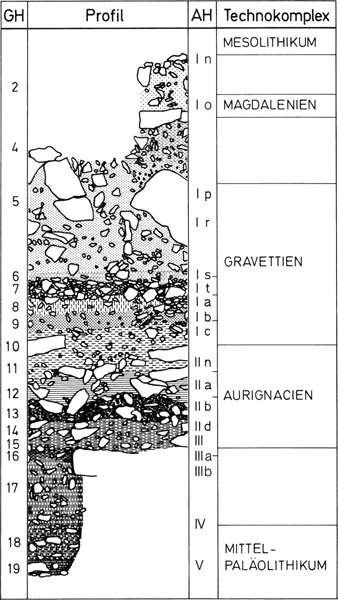
Stratigraphic profile of Geißenklösterle (modified after Hahn (1988)).
Photo: Zilhão et al. (2010)

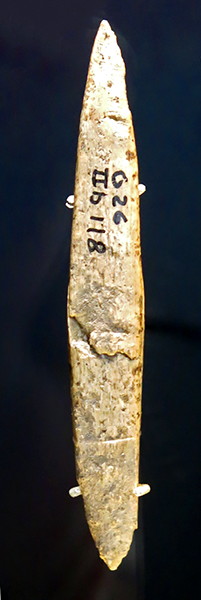
The Geißenklösterle - the beginnings of art and music
The cave contained the complete sequence of Palaeolithic layers. In addition, the discoveries of the early artefacts and musical instruments are of great importance.
Amongst the many leftovers from the time of the Aurignacian, 35 000 to 40 000 years ago, there are also large quantities of bone charcoal, which bear witness to several fire-places.
(left) Blank with cutting lines, mammoth ivory
(right) Projectile point, mammoth ivory
From the Aurignacian, 40 000 - 35 000 BP from Geißenklösterle, Blaubeuren-Weiler, Aib-Donau-Kreis.
Photo: Don Hitchcock 2015
Source and text: Landesmuseum Württemberg, Stuttgart
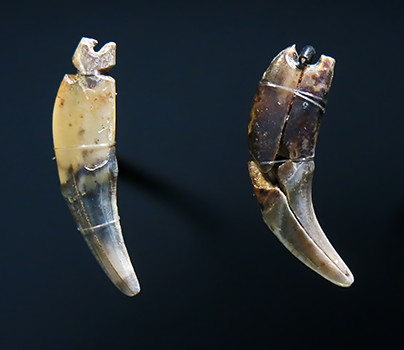
Two perforated fox teeth.
Geißenklösterle, Blaubeuren-Weiler, Alb-Donau-Kreis.
From the Aurignacian, 40 000 - 35 000 BP.
Photo: Don Hitchcock 2015
Source and text: Landesmuseum Württemberg, Stuttgart

Baby mammoth milk tusks.
Geißenklösterle, Blaubeuren-Weiler, Alb-Donau-Kreis.
Photo: Don Hitchcock 2015
Source and text: Blaubeuren Museum

Unborn horse bones.
Sirgenstein and Hohle Fels.
Photo: Don Hitchcock 2015
Source and text: Blaubeuren Museum

Retoucher with eyelet, reindeer antler.
( this was possibly part of the normal toolkit carried by hunters on their belts, in order to sharpen tools while in the field as necessary - Don )
Geißenklösterle, Blaubeuren-Weiler, Alb-Donau-Kreis.
From the Aurignacian, 40 000 - 35 000 BP.
Photo: Don Hitchcock 2018
Source and text: Landesmuseum Württemberg, Stuttgart
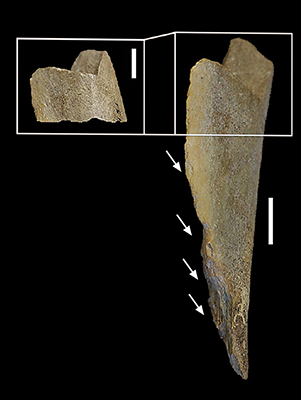
Retoucher using a horse tibia, Geißenklösterle, Layer IIb, Aurignacian.
Scale = 1 cm.
Photo and text: Toniato et al. (2018)

Retoucher using a megaherbivore rib, Geißenklösterle, Layer It, Gravettian.
Scale = 1 cm.
Photo and text: Toniato et al. (2018)
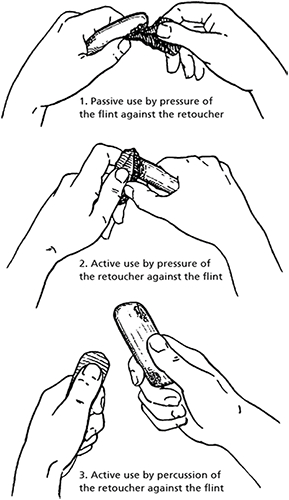
Passive and active use of retouchers.
Photo: after Taute, 1965
Proximal source and text: Toniato et al. (2018)
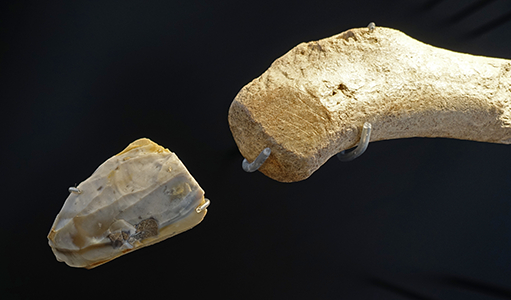
Core, Jurahornstein, Jurassic chert, and hammer.
Core from Petersfels, Engen-Bittelbrunn, Kreis Konstanz, Magdalenian, circa 14 000 BP - 12 000 BP.
(Sledge) Hammer of reindeer antler, Geißenklösterle, Blaubeuren-Weiler, Alb-Donau-Kreis, Magdalenian, circa 14 000 BP - 12 000 BP.
Photo: Don Hitchcock 2018
Source and text: Landesmuseum Württemberg, Stuttgart
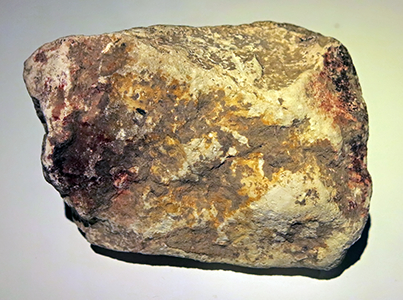
Painted stone from Geißenklösterle.
Circa 38 000 BP
Limestone painted with charcoal, haematite, and ochre.
On loan from the Archäologisches Landesmuseum Baden-Württemberg
Photo: Don Hitchcock 2015
Source: Blaubeuren Museum

Stone Age Sounds
Experiments show that one can play such a stone age 'notch flute' by closing part of the tube with the lower lip and directing the air flow over a sharp-edged indentation in the flute edge. One can also play the bone flute as an 'oblique flute'. The flute is blown as if you wanted to whistle.
Flute of swan-wing bone, a reproduction of a flute found at Geißenklösterle, Blaubeuren-Weiler, Alb-Donau-Kreis.
From the Aurignacian, 40 000 - 35 000 BP.
Photo: Don Hitchcock 2015
Source and text: Facsimile, Landesmuseum Württemberg, Stuttgart
Flute in three pieces from Geißenklösterle, made of mammoth ivory, 38 000 BP.
Photo: Don Hitchcock 2015
Source and text: Blaubeuren Museum

Schraper, scraper, or idiophone.
Ivory, Geißenklösterle, Blaubeuren-Weiler, Alb-Donau-Kreis, Aurignacian, 35 000 - 40 000 BP.
( The three holes are puzzling. The object was scraped by a piece of antler across the notches on the left edge, to create a musical sound. The holes look like finger holes, but seem too small for even a child's fingers. The most likely explanation is that the three holes were used to ply thread into string or rope, and that the object had two roles - as a maker of music, and as a maker of yarn - Don )
Blaubeuren-Weiler, Alb-Donau-Kreis.
From the Aurignacian, 40 000 - 35 000 BP
Photo: Don Hitchcock 2018
Source and text: Landesmuseum Württemberg, Stuttgart
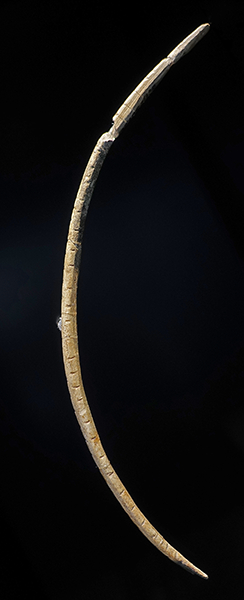
Mouth bow.
Ivory, Geißenklösterle, Blaubeuren-Weiler, Alb-Donau-Kreis, Aurignacian, 40 000 - 35 000 BP.
The mouth bow is strung end to end with a taut cord.
The usual way to make the bow sound is to pluck the string, although sometimes a subsidiary bow is used to scrape the string, much as on a violin.
The most usual type of resonator in modern times consists of a gourd attached to the back of the string bearer. The bow may also be stood in a pit or gourd on the ground, or one end of it may be partially placed in the mouth. This last method allows the size of the resonator to be varied as the instrument is played, thus allowing a melody to be heard consisting of the notes resonating in the player's mouth. As well as these various forms of resonators, the bow is now frequently played without a resonator at all.
Photo: Don Hitchcock 2018
Source and text: Landesmuseum Württemberg, Stuttgart
Additional text: Wikipedia

The mouth bow was strung with cord, like a hunter's bow, and placed in front of the mouth, and the string was strummed, while the musician made their mouth cavity larger and smaller to vary the musical pitch. It could also be played while singing. Readers may be interested in these links which demonstrate the use of the bow in American folk music:
Appalachian Mouthbow, demonstrated by 'morbanjo' who has a number of good videos of him playing home made instruments.
Buffy Sainte Marie's use of the instrument is also interesting:
Buffy Sainte Marie plays the Mouthbow
Photo: Morbanjo
Text: Don Hitchcock


Three holed flute.
Swan radius bone, found in 23 pieces, excavated in 1990.
Geißenklösterle, Blaubeuren-Weiler, Alb-Donau-Kreis.
From the Aurignacian, 40 000 - 35 000 BP from Geißenklösterle, Blaubeuren-Weiler, Aib-Donau-Kreis.
Photo: Don Hitchcock 2018
Source and text: Landesmuseum Württemberg, Stuttgart
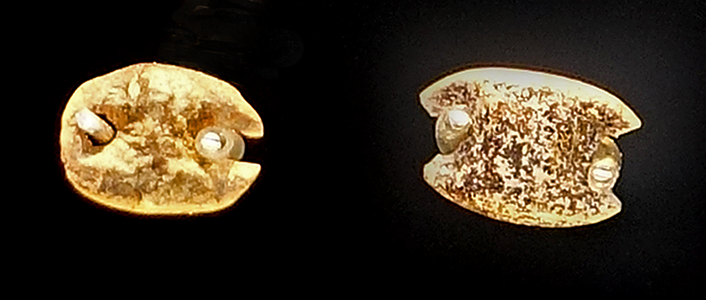
Two toggle buttons, mammoth ivory.
From the Aurignacian, 40 000 - 35 000 BP from Geißenklösterle, Blaubeuren-Weiler, Aib-Donau-Kreis.
Photo: Don Hitchcock 2018
Source and text: Landesmuseum Württemberg, Stuttgart
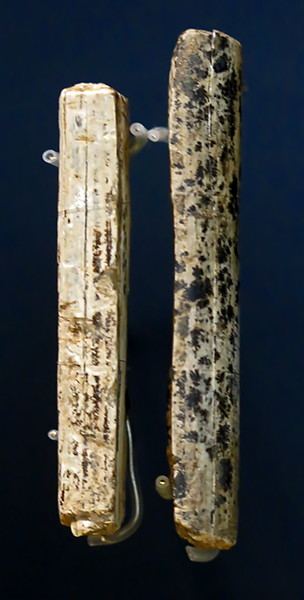
Two half-batons (unfinished roughouts), mammoth ivory.
From the Aurignacian, 40 000 - 35 000 BP from Geißenklösterle, Blaubeuren-Weiler, Aib-Donau-Kreis.
Photo: Don Hitchcock 2015
Source and text: Landesmuseum Württemberg, Stuttgart
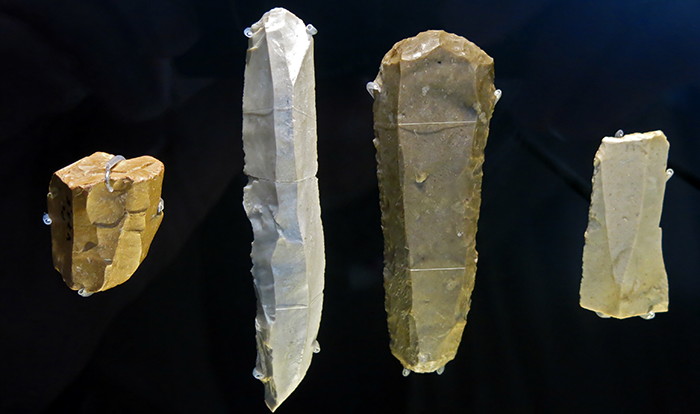
(left) Blade core, Jurahornstein, Jurassic chert
(centre) Two scrapers, Jurahornstein, Jurassic chert
(right) Burin, Jurahornstein, Jurassic chert
( Note that the burin on the right appears to be of the Noailles type, which is usually attributed to the Gravettian, not the earlier Aurignacian - Don )
From the Aurignacian, 40 000 - 35 000 BP from Geißenklösterle, Blaubeuren-Weiler, Aib-Donau-Kreis.
Photo: Don Hitchcock 2015
Source and text: Landesmuseum Württemberg, Stuttgart

(left and centre) Two burins, one with production waste, Jurahornstein, Jurassic chert
( as noted above, the burin on the left is of the Gravettian Noailles type - Don )
(right) Scraper on a wide flake, Jurahornstein, Jurassic chert
From the Aurignacian, 40 000 - 35 000 BP from Geißenklösterle, Blaubeuren-Weiler, Aib-Donau-Kreis.
Photo: Don Hitchcock 2015
Source and text: Landesmuseum Württemberg, Stuttgart

 Left to right:
Left to right:
Projectile point with split base, reindeer antler, Geißenklösterle, Blaubeuren-Weiler, Alb-Donau-Kreis. Aurignacian, circa 40 000 BP - 35 000 BP
Projectile point, ivory, Geißenklösterle, Blaubeuren-Weiler, Alb-Donau-Kreis. Aurignacian, circa 40 000 BP - 35 000 BP
Photo: Don Hitchcock 2018
Source and text: Landesmuseum Württemberg, Stuttgart
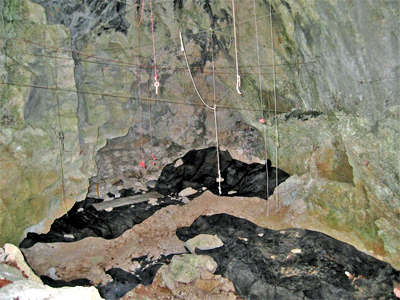
Geißenklösterle, September 2004
Photo: GFDL, uploaded by Ötzi
Permission: Creative Commons Attribution-Share Alike 3.0 Unported license.
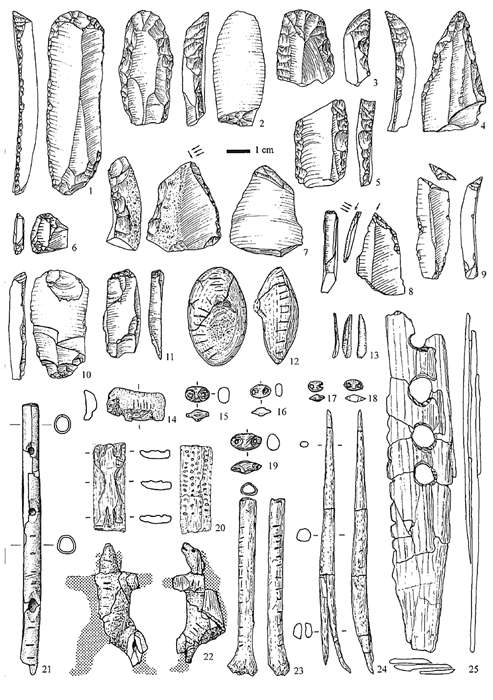
Aurignacian of Geißenklösterle, Archeological Horizon II.
1-3. endscrapers
4. pointed blade;
5. laterally retouched blade
6, 10-11. splintered pieces
7. busked burin
8. burin on truncation
9. truncated blade
12. antler pendant
13. Dufour bladelet
14, 20, 22. ivory figurines
15-19. double perforated ivory beads
21. bone flute
23. decorated bone
24. bone point with split base;
25. bâton percé of ivory.
( Note that number 25 is not a bâton percé, it is an idiophone, see the image and text above. Antler is stronger, and more normally used for a bâton percé. This piece is far too thin and fragile to perform the functions of a bâton percé - Don )
After Hahn 1988 (1–2, 4–5, 7–21) and Hahn 1989(3, 6)
Photo and text: Conard & Bolus (2003)
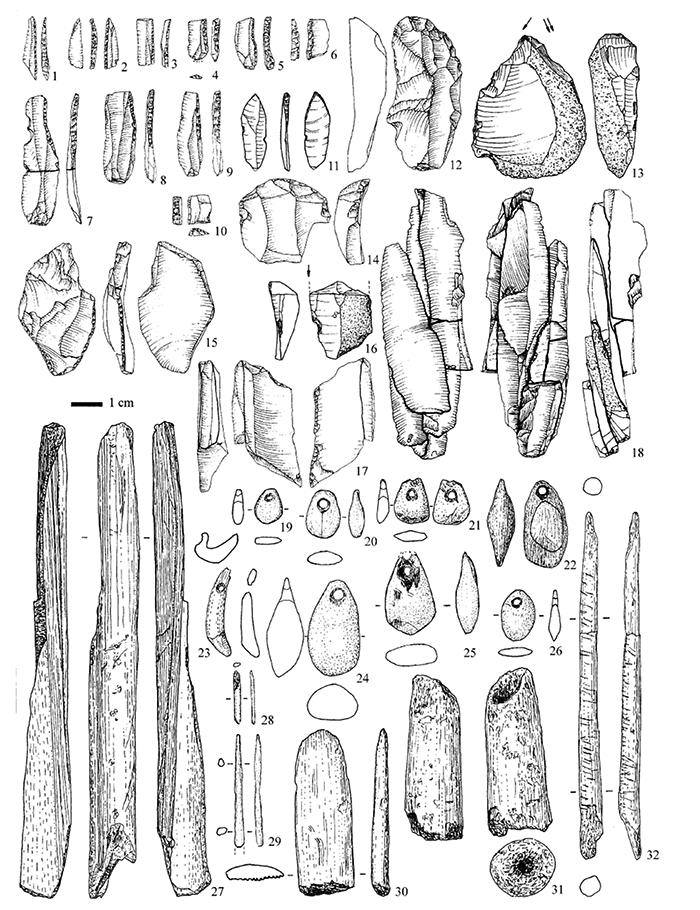
Gravettian of Geißenklösterle.
(1–2) micro-Gravette points
(3–10) backed bladelets
(11) flechette
(12, 14) end scrapers
(13, 15–17) burins
(18) refitted blade sequence
(19–22, 24–26) ivory pendants
(23) perforated fox canine
(27) bone demonstrating the use of groove and splinter technique
(28-29) needle-like tool fragments of bone
(30) burnisher
(31) shaft segment of antler
(32) antlerpoint with incisions.
After Hahn et al.(1985) (1–10, 12, 14–15, 17–18, 20, 22, 25–31) and Scheer 1989(11, 13, 16, 19, 21, 23–24, 32).
Photo and text: Conard & Bolus (2003)
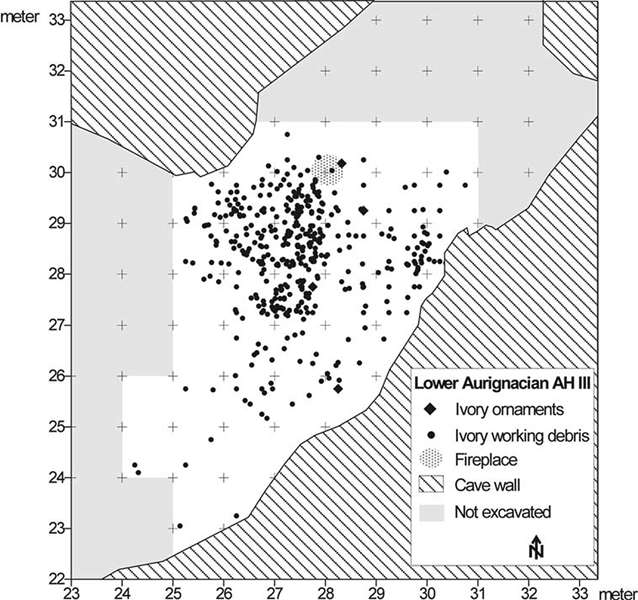

Geißenklösterle. The horizontal distribution of mammoth ivory artefacts and ornaments from AH III (left) and AH II (right).
Photo: Zilhão et al. (2003)
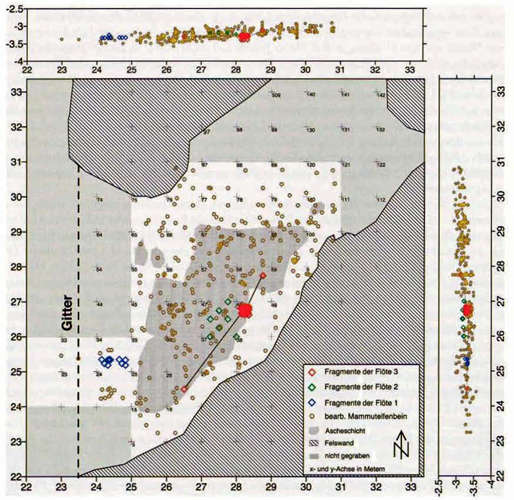
Geißenklösterle.
The distribution of processed mammoth ivory (yellow), Flute 1 (blue), Flute 2 (green) and Flute 3 (red). All findings are from the Archaeological Horizon II
Photo: Conard et al. (2004)
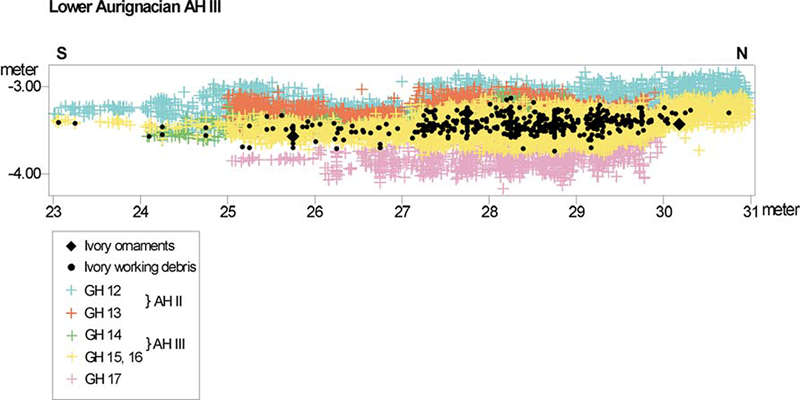
Geißenklösterle. The vertical distribution of mammoth ivory artefacts and ornaments from AH III.
Photo: Zilhão et al. (2003)
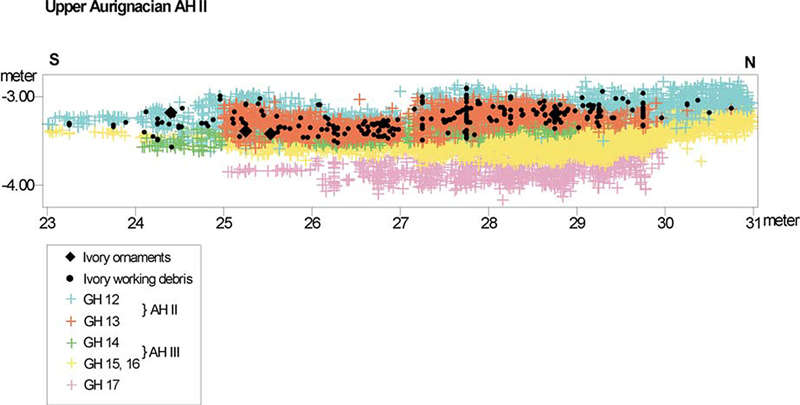
Geißenklösterle. The vertical distribution of mammoth ivory artefacts and ornaments from AH II.
Photo: Zilhão et al. (2003)
ã
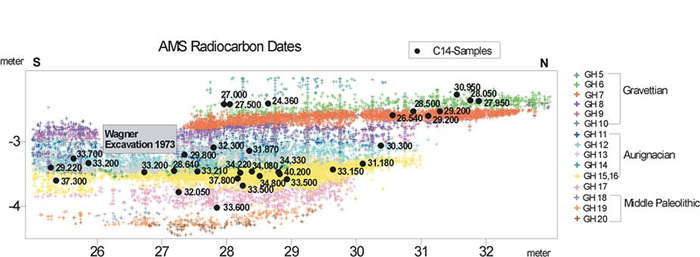
Geißenklösterle. The vertical projection of AMS dates on archeological material from the Middle Paleolithic, Aurignacian and Gravettian horizons.
Photo: Zilhão et al. (2003)
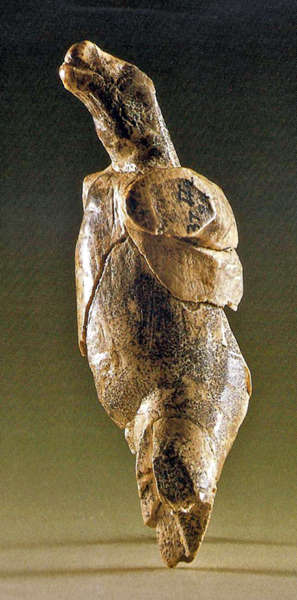
Erect Bear.
The bear was reconstructed from 11 pieces of ivory. Its head is raised and the snout slightly opened, which gives the animal a threatening appearance. It displays either aggression or a state of defence. Its body is covered with the lines of notches typical of these figures.
Length: 50 mm
Height: 21 mm
Width: 19 mm
Site: Geißenklösterle, Blaubeuren
The original carving is in the Württemberg Landesmuseum, Stuttgart
Photo: Holdermann et al. (2001)
Text: http://www.ice-age-art.de/
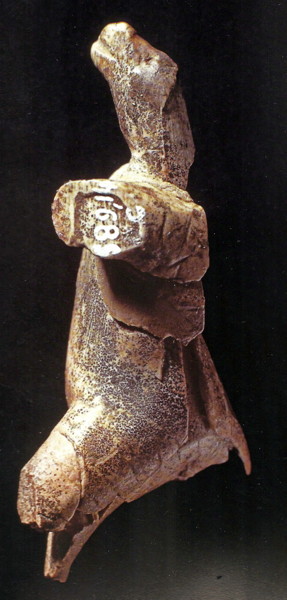
Geißenklösterle bear.
( note that this image has been mirrored from that in the book, which was wrongly typeset - Don )
Photo: Rau et al. (2009)
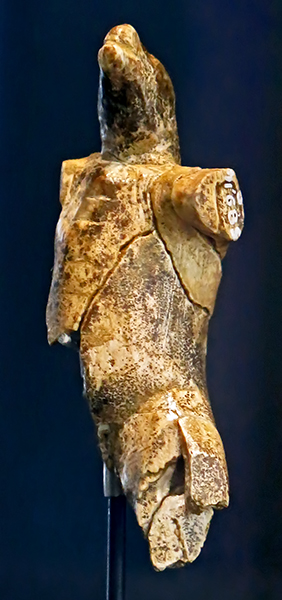
Figurine of a Bear, standing upright, in mammoth ivory.
Geissenklösterle, Blaubeuren-Weiler, Alb-Donau-Kreis.
From the Aurignacian, 40 000 - 35 000 BP.
Photo: Don Hitchcock 2018, 2015
Source and text: Landesmuseum Württemberg, Stuttgart

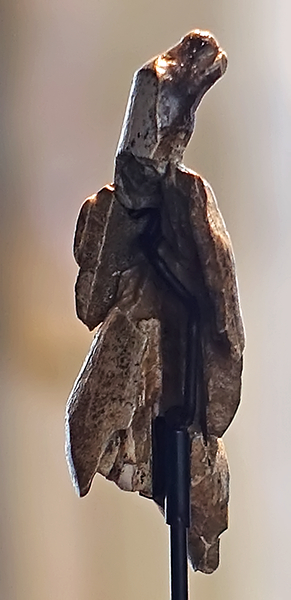
Side and back of the bear, showing its fragmentary nature.
Displaying artefacts of this type is a highly skilled art, and requires top quality curators and technicians.
Geissenklösterle, Blaubeuren-Weiler, Alb-Donau-Kreis.
From the Aurignacian, 40 000 - 35 000 BP.
Photo: Don Hitchcock 2018
Source: Landesmuseum Württemberg, Stuttgart
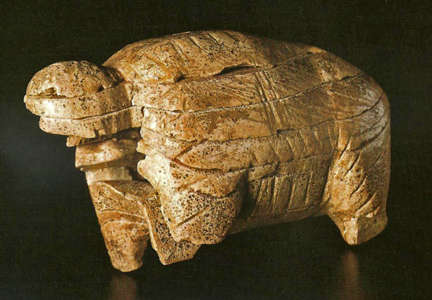
Mammoth
This sculpture from the Geißenklösterle cave was pieced together and reconstructed from more than 40 single fragments. Ivory grows in layers, so fossil ivory very often disintegrates into single flakes. Unfortunately, the lower parts of the head and trunk are missing, but the shape of the body clearly indicates a mammoth. The surface of the body was engraved with lines similar to those on the small bison, which was also found at Geißenklösterle.
Length: 67 mm
Height: 38 mm
Width: 29 mm
Site: Geißenklösterle, Blaubeuren
The original carving is in the Württemberg Landesmuseum, Stuttgart
Photo: Holdermann et al. (2001)
Text: http://www.ice-age-art.de/

Figurine of a Mammoth, in mammoth ivory, showing the right hand side.
Geissenklösterle, Blaubeuren-Weiler, Alb-Donau-Kreis.
From the Aurignacian, 40 000 - 35 000 BP.
Photo: Don Hitchcock 2018
Source and text: Landesmuseum Württemberg, Stuttgart
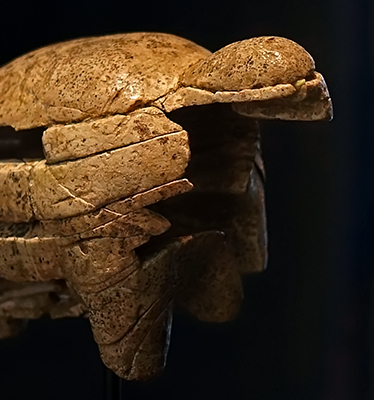
Figurine of a Mammoth, in mammoth ivory, close up of the forequarters.
Geissenklösterle, Blaubeuren-Weiler, Alb-Donau-Kreis.
From the Aurignacian, 40 000 - 35 000 BP.
Photo: Don Hitchcock 2018
Source and text: Landesmuseum Württemberg, Stuttgart
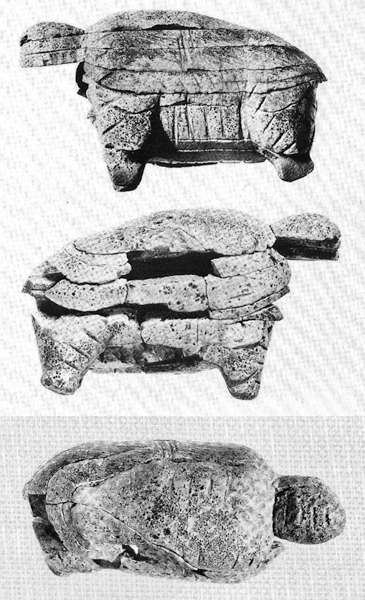
Mammoth - another version, showing left, right and top views.
Photo: Adam et al. (1980)
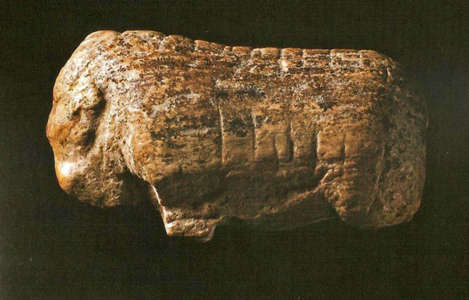
Bison
The bison from the Geißenklösterle cave is a very small and simple bas-relief. Head, neck and extremities are merely outlined, with faint hints of a beard and a horn, which leads to the assumption that this probably depicts a bison.
Length: 25.5 mm
Height: 14.5 mm
Width: 6 mm
Site: Geißenklösterle, Blaubeuren
The original carving is in the Württemberg Landesmuseum, Stuttgart
Photo: Holdermann et al. (2001)
Text: http://www.ice-age-art.de/
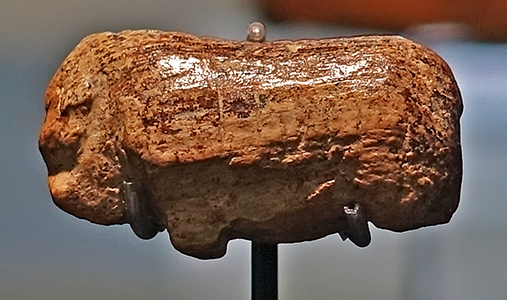
Figurine of a Bison, in mammoth ivory.
Geißenklösterle, Blaubeuren-Weiler, Alb-Donau-Kreis.
From the Aurignacian, 40 000 - 35 000 BP.
Photo: Don Hitchcock 2018
Source and text: Landesmuseum Württemberg, Stuttgart
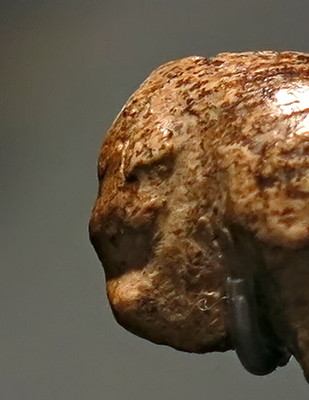
Close up of the head of the bison. It would have been no mean feat for hunters to bring down such a large and strong beast.
Geißenklösterle, Blaubeuren-Weiler, Alb-Donau-Kreis.
From the Aurignacian, 40 000 - 35 000 BP.
Photo: Don Hitchcock 2015
Source and text: Landesmuseum Württemberg, Stuttgart
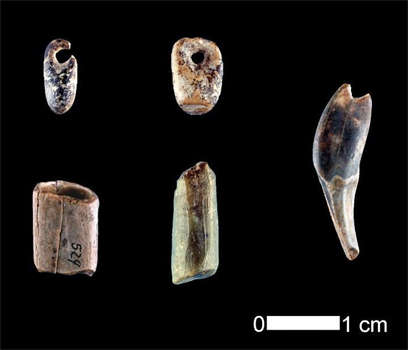
Jewellery.
Geißenklösterle Cave is one of several caves in the Swabian Jura that have produced important examples of personal ornaments, figurative art, mythical imagery and musical instruments.
Photo: © Universitaet Tübingen
Text: http://www.sciencedaily.com/releases/2012/05/120524092226.htm

These are the oldest musical instruments ever discovered.
Some of the world's first musicians may have been flautists. Archaeologists reanalysing artefacts from a cave in southern Germany have determined that two prehistoric flutes — one fashioned from bird bone, the other mammoth ivory — are somewhere between 42 000 and 43 000 years old. If the researchers are right, these primitive instruments predate the previous record holder (also a flute) by thousands of years.
Photo and text: http://io9.com/5913322/these-are-the-oldest-musical-instruments-ever-discovered
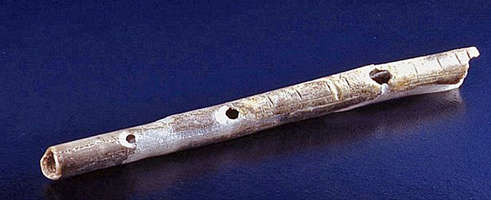
The flutes were discovered in Germany's Geißenklösterle Cave, an important archaeological site to researchers who study the arrival and spread of modern humans in and across Europe (pictured up top is the flute fashioned from mammoth ivory, below the one made from bird bones). Now, a team led by Oxford University archaeologist Tom Higham has used a refined dating method to determine the age of animal bones excavated from the same geological layers as the instruments. Their findings are described in the latest issue of the Journal of Human Evolution.
'These results are consistent with a hypothesis we made several years ago that the Danube River was a key corridor for the movement of humans and technological innovations into central Europe between 40 000 and 45 000 years ago,' explained Tübingen University researcher and study co-author Nick Conard in a statement.
Photo and text: http://io9.com/5913322/these-are-the-oldest-musical-instruments-ever-discovered
Flute made from the radius bone of a swan, circa 127 mm long.
Geißenklösterle, Blaubeuren-Weiler, Alb-Donau-Kreis.
Photo: Don Hitchcock 2015
Text: Adapted from https://www.toneinsight.com/music-history/geissenklosterle-flutes/
Source: Blaubeuren Museum
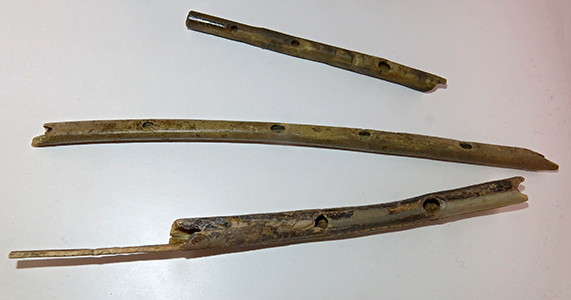
Facsimile flutes on display at Monrepos Archäologisches Forschungszentrum und Museum.
The upper and lower flutes are obviously the same as the two flutes in the images above, the centre flute is the one discovered at Hohle Fels archaeological horizon Vb, see the report below.
Photo: Don Hitchcock 2015
Source: Facsimile, Monrepos Archäologisches Forschungszentrum und Museum, Neuwied, Germany
Here is what a reconstruction of an ivory flute from the archaeological horizon II at Geißenklösterle sounds like. The new flute found at Hohle Fels (see below) would have had a deeper register since it is a larger flute:
© Wulf Hein, University of Tübingen
The walk from Geißenklösterle to Hohle Fels
The entire route I took to walk from the entry to the path near the AVIA Xpress Automatenstation to Die Brillenhöhle, then to Geißenklösterle, Hohle Fels, and Sirgensteinhöhle, then return to Blaubeuren train station via the main road, B 492.
As always, click on the photo to see the full size version.
Photo: After Google Maps
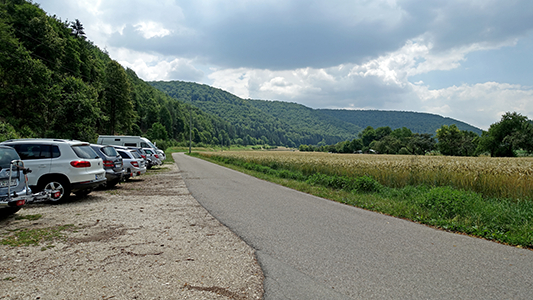
The walking (or cycling or vehicle) route leads from this parking area beside the notice board at Geißenklösterle. The road shown goes mostly south towards the site of Hohle Fels, and is much used by cyclists in fine summer weather.
Photo: Don Hitchcock 2018
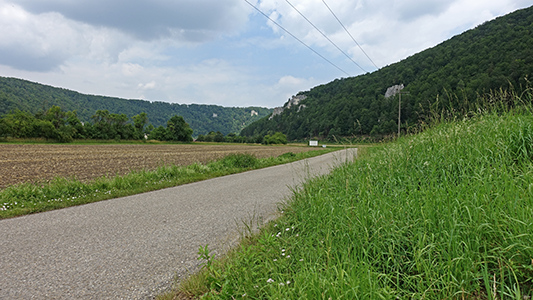
This is a side road I took in error when I missed the unmarked right turn to Hohle Fels.
The roads in this area area are a favourite route for cyclists, since there is little traffic, and the road is flat and well made.
Photo: Don Hitchcock 2018

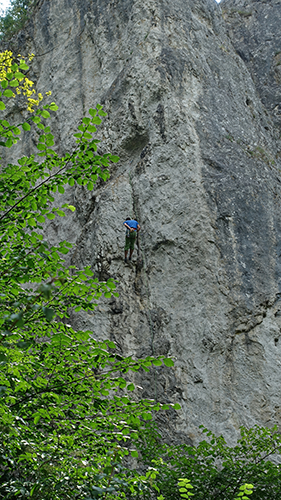
The road just before Hohle Fels passes by sheer limestone cliffs, providing good climbing for the local enthusiasts.
Photo: Don Hitchcock 2018
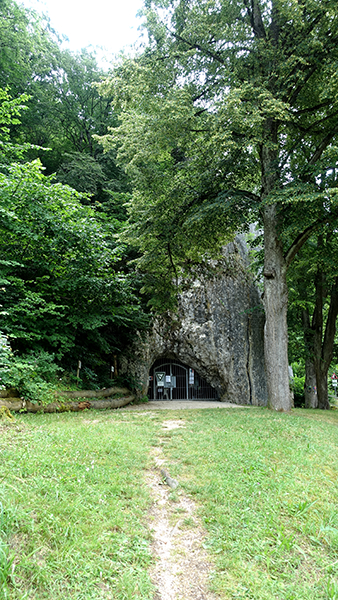
A few minutes later I arrived at the entrance to Hohle Fels. Luckily I only had to wait a short time before it opened, and I was able to make a visit to the inside of the cave.
The Hohle Fels is open for visitors from 1st May to 31st October, from Wednesday to Saturday from 14:00 h to 17:00 h, Sunday 11:00 h to 17:00 h.
Photo: Don Hitchcock 2018
Additional text: adapted from https://www.geopark-alb.de
Hohle Fels
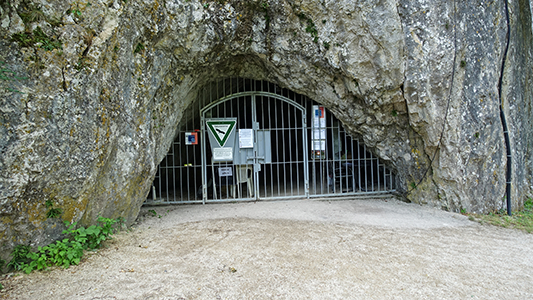
Entry to Hohle Fels Cave.
Hohle Fels (also Hohlefels, Hohler Fels, German for "hollow rock") is a cave in the Swabian Alb of Germany that has yielded a number of important archaeological finds dating to the Upper Paleolithic. Artefacts found in the cave represent some of the earliest examples of prehistoric art and musical instruments ever discovered.
The cave is just outside the town of Schelklingen in the state of Baden-Württemberg, near Ulm.
Hohle Fels Cave is situated on the eastern extension of the Swabian Jura about 2 0 km west of Ulm. The cave is formed within an Upper Jurassic (Malm) limestone reef and occurs at about 534 metres above sea level in the valley of the Ach River, a tributary of the Danube. The Ach Valley was cut by the Danube before it left its bed shortly during the Riss glacial maximum. Today the Ach River is about 3 m wide and flows to the east into the Blau river. Prior to the Riss Glacial Period the valley bottom was up to 40 metres lower than today and much narrower; it has subsequently been filled with gravel and sand. The cave is located on the southeast side of the valley, about 7 metres above the current valley bottom which hereis about 350 metres wide. During the terminal Pleistocene the valley bottom was ca. 5 - 10 metres lower than today's position.
Photo: Don Hitchcock 2018
Text: Adapted from Wikipedia, and Goldberg et al. (2003)

Hohle Fels is one of the largest caves in the region with a large cave hall that has a maximum height of 12 m and covers an area of 500 m2. The entrance is connected with the cave hall by a 30 metre long passage. During the first scientific excavations in 1870/71 Oscar Fraas recovered an enormous number of cave bear bones, as well as stone, bone, and antler artifacts. R. R . Schmidt (Schmidt 1910, 1912) presented the Paleolithic from Hohle Fels in his classic monograph, 'Die diluviale Vorzeit Deutschlands'.
From 1958-1960 G. Matschak and G. Riek conducted excavations in several parts of the cave, most notably in a large niche on the left side of the passage leading to the main hall of the cave. The excavators never published their results, and C. Saier (Saier 1994) was the first to systematically study the finds from these excavations. Between 1977-79 and 1987-1996 Joachim Hahn renewed excavations in the niche in the hopes of gaining a stratigraphic section for comparison with the profile from nearby Geißenklösterle (Hahn 1988).
Photo and text: Goldberg et al. (2003)


No hint is given from the outside as to the size of the cave.
Photo (left): Unknown, possibly from a historical post card.
Source: Display at Hohle Fels
Photo (right): Don Hitchcock 2018

The entry corridor to Hohle Fels is flanked by some good notice boards.
Photo: Don Hitchcock 2018

Visitors to Hohle Fels pass over this elevated steel walkway, which gives access to the main cave further on.
Photo: Don Hitchcock 2018

The steel walkway also allows us to see the excavations which are still going on. Only the outer part of the cave was occupied, and much material has been excavated, and waits in labelled bags to be further washed and sieved to extract artefacts. Here the access walkway is far above the floor of the excavations, which are reached by scientists using similar steel walkways and ladders.
Photo: Don Hitchcock 2018

The walkway shown in the lower part of this photo, leads to this vast cavern, which has been very well appointed with lights and paths. It was never lived in by the Hohlefels people, as is also the case with most other such caves with large interior spaces. The entry to caves are far more attractive places to live in, usually, with access to dry and well lit living spaces, with good access to water and views of approaching game.
Photo: Don Hitchcock 2018
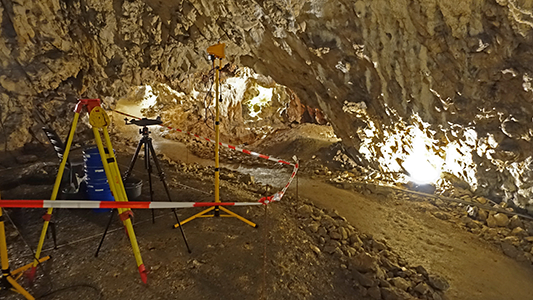
As can be seen here in this photo taken from the path at the bottom left of the photo above, the interior of the cave is damp, and the cave was cool, with humidity which felt like close to 100%.
Photo: Don Hitchcock 2018

Parts of the path are narrow and with low ceilings.
Photo: Don Hitchcock 2018
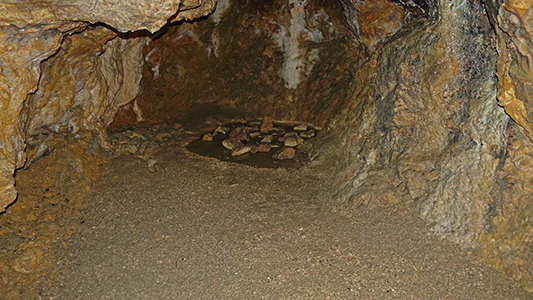
This small moist cul de sac had walls running with water, and standing water on the floor.
Photo: Don Hitchcock 2018
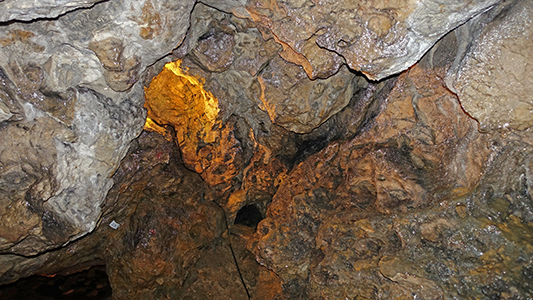
Parts of the walls were glistening with crystals of redeposited calcite.
Photo: Don Hitchcock 2018
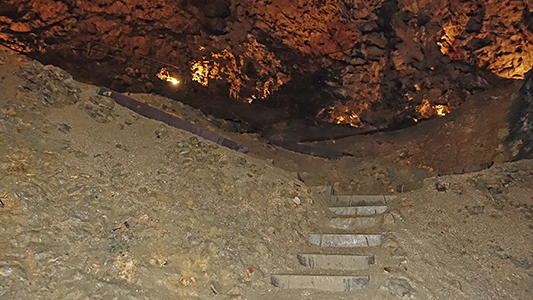
The path then leads to the floor proper of the main cave via these steps.
Photo: Don Hitchcock 2018
The cave is well lit, with appropriate paths, steps, and guard rails.
Photo: Don Hitchcock 2018
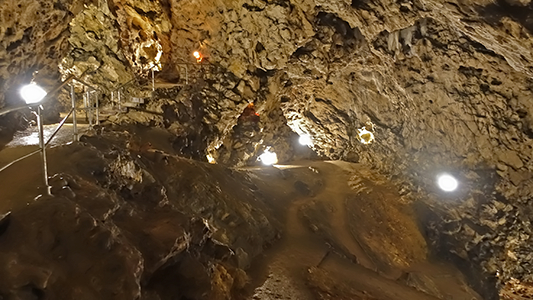
Since these areas are sterile of archaeological remains of any kind, it has been possible to put in good paths and railings so that visitors can have the experience of visiting the whole cave with safety.
Photo: Don Hitchcock 2018
The placement of paths and the judicious use of lighting for close inspection and for atmosphere, make the cave a delightful place to explore.
Photo: Don Hitchcock 2018
It is fortunate that a complete range of Upper Palaeolithic remains have been found, dating back to Neanderthal occupation from 65 000 BP, through to the Magdalenian, at 13 000 BP.
The site is a treasure house of art and tools.
In addition, it is very rare that visitors can look onto an archaeological dig in progress, without hindering the scientists in their work, and that the dig has been specifically organised and displayed so that visitors can learn much from just a short visit.
Here the levels have been labelled to make the progress of occupation much more visible, and to get a feeling for the gradual build up of the layers over time.
Photo: Don Hitchcock 2018
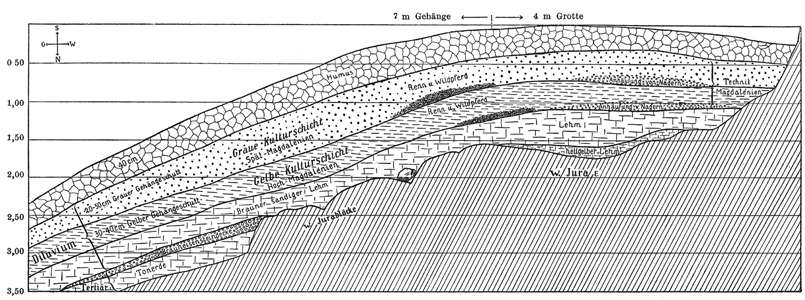
Longitudinal profile at Hohle Fels, 1912.
Photo: Schmidt (1912), in Bolus et al. (2012)
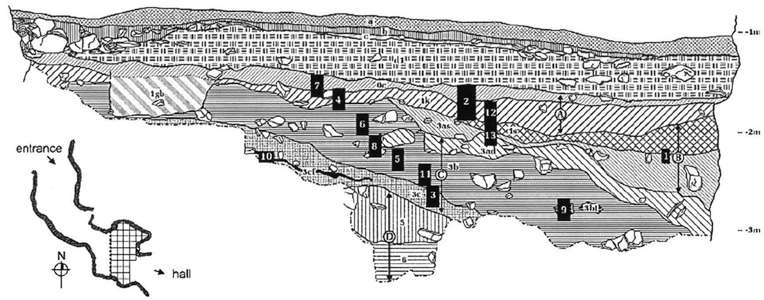
Profile showing stratigraphy with archaeological units and geological layers, as well as sampling locations.
The inset map shows the deep interior chamber and the location of excavated area with exposures of sediments discussed in the text. The grid lines are 1 metre apart.
Photo and text: Goldberg et al. (2003)
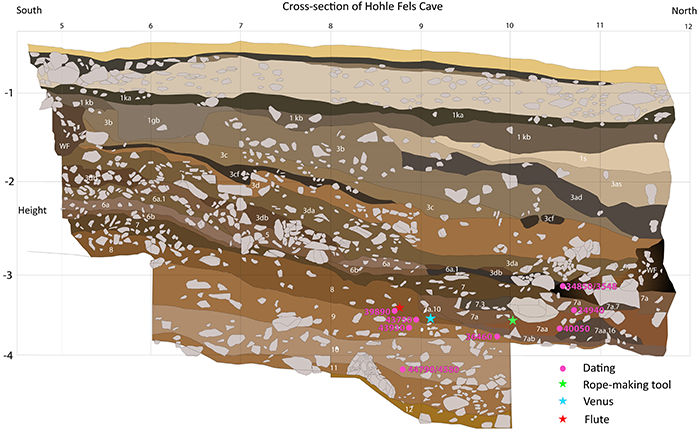
Cross Section of Hohle Fels Cave.
Photo: © University of Tübingen
Source: http://www.thehistoryblog.com/archives/date/2016/07
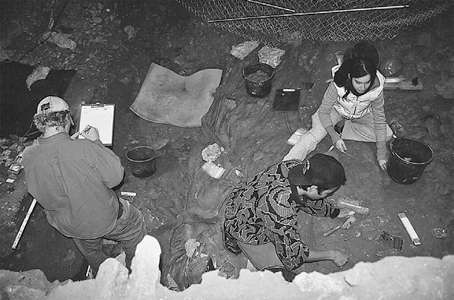
Hohle Fels. Excavations in August 2002. On the left the top layer of the middle Palaeolithic is being excavated. At right, the ivory workshop of the AH Aurignacian layer IV is being unearthed.
Photo: Conard (2002)
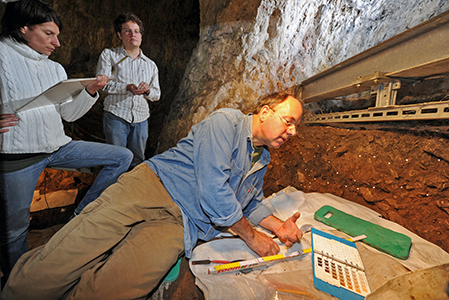
The archaeologist Nicolas Conard examines a find layer in Hohle Fels.
Photo: dpa
Source and text: Markus Brauer, https://stzn.atavist.com/zurueck-in-die-steinzeit

Archeologist Laura Bauer gently removes earth from pieces of ivory at Hohle Fels.
Photo: Universität Tübingen
Source and text: Markus Brauer, https://stzn.atavist.com/zurueck-in-die-steinzeit
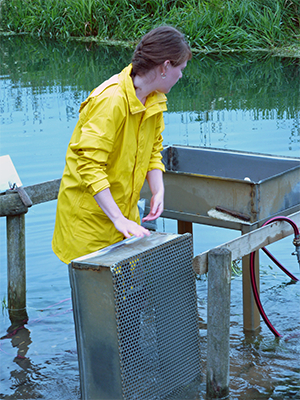
Archeology student Emma Kozitsky sieves sediments in the crystal clear waters of the nearby Ach.
Photo: Markus Brauer
Source and text: Markus Brauer, https://stzn.atavist.com/zurueck-in-die-steinzeit
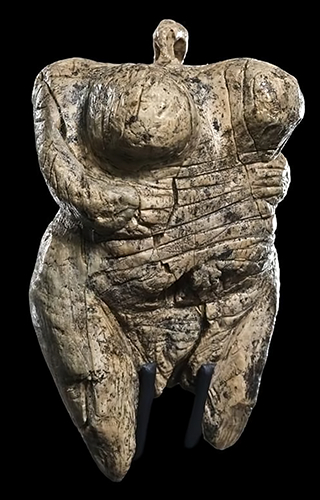
One of the most important recent finds was this venus figure.
At 40 000 years old, the Venus of Hohle Fels is the oldest figurative representation in the world. The six centimetre high figurine is almost completely preserved.
Photo: Landesmuseum Württemberg
Source and text: Markus Brauer, https://stzn.atavist.com/zurueck-in-die-steinzeit
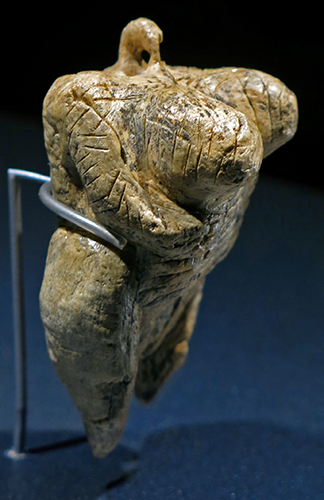
The Venus of Hohle Fels is treated in more detail on this page
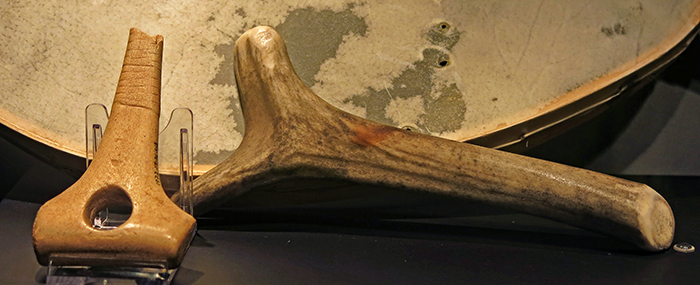
Both these objects could have been used as drum sticks for a shaman drum.
(left) Baton percé from Hohle Fels, circa 30 000 BP.
(right) Drum stick from the Brillenhöhle, circa 14 000 BP.
(background) modern reconstruction of a shaman drum.
Photo: Don Hitchcock 2015
Source and text: Blaubeuren Museum
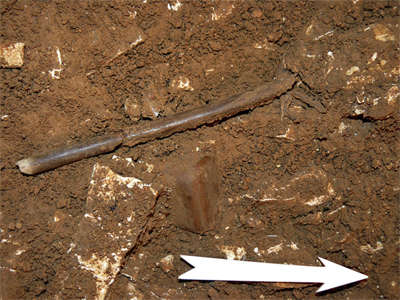
In their excavations in Hohle Fels the researchers made an extraordinary discovery: a 35 000 years old musical instrument.
Musical instruments from the past discovered by Conard and his colleagues are already well known. In 2004 they discovered in the nearby Geißenklösterle cave near Blaubeuren prehistoric flutes from swan bones and mammoth ivory . In contrast to these smaller instruments, the ones now discovered would be likely to produce a greater variety of sounds and melodies with the griffon vulture flute, suspected Conard. According to the researchers, the larger diameter of the instrument mainly produces lower notes. The musical repertoire resembles that of the reconstructed ivory flute from Geißenklösterle.
Photo: © Maria Malina, Universität Tübingen
Source of photo: http://www.spektrum.de/alias/ausgrabungen/steinzeitmusik/999398
Text: Conard et al. 2009, via http://www.spektrum.de/alias/ausgrabungen/steinzeitmusik/999398
Excavations in the summer of 2008 at the sites of Hohle Fels and Vogelherd produced new evidence for Paleolithic music in the form of the remains of one nearly complete bone flute and isolated small fragments of three ivory flutes.
The most significant of these finds, a nearly complete bone flute, was recovered in the basal Aurignacian deposits at Hohle Fels Cave in the Ach Valley, 20 km west of Ulm. The flute was found in 12 pieces. The fragments were distributed over a vertical distance of 3 cm over a horizontal area of about 10 x 20 cm. This flute is by far the most complete of all of the musical instruments thus far recovered from the caves of Swabia.
The preserved portion of the bone flute from Hohle Fels has a length of 218 mm and a diameter of about 8 mm. The flute preserves five finger holes. The surfaces of the flute and the structure of the bone are in excellent condition and reveal many details about the manufacture of the flute. The maker carved two deep, V-shaped notches into one end of the instrument, presumably to form the proximal end of the flute into which the musician blew. The find density in this stratum is moderately high with much flint knapping debris, worked bone and ivory, bones of horse, reindeer, mammoth, cave bear, ibex, as well as burnt bone. No diagnostic human bones have been found in deposits of the Swabian Aurignacian, but we assume that modern humans produced the artefacts from the basal Aurignacian deposits shortly after their arrival in the region following a migration up the Danube Corridor.
The maker of the flute carved the instrument from the radius of a griffon vulture ( Gyps fulvus ). This species has a wingspan between 230 and 265 cm and provides bones ideal for large flutes. Griffon vultures and other vultures are documented in the Upper Palaeolithic sediments of the Swabian caves.
Photo: Don Hitchcock 2015
Text: https://phys.org/news/2009-06-prehistoric-flute-germany-oldest.html
Source: Blaubeuren Museum

This flute was discovered by Nicholas Conard of the University of Tübingen in the Swabian Alb. It is 35 000 years old and comes from the Aurignacian culture - the oldest flute known.
The manufacture of musical instruments made of ivory requires a very complex technology, says Conard: First, the mammoth ivory was shaped, halved, then both halves were processed individually before recombining them finally gluing the two halves into an airtight tube. Typical traces of this complex process are found in the three exposed ivory fragments. This includes a number of grooves along the longitudinal edge of ivory, to seal the two halves better, air holes to generate different frequencies, and great care taken because of the curved shape of the hollow material. Due to the different sizes and thicknesses of the objects found, the researchers concluded that they are fragments of several different flutes.
The flutes artifacts were from the lower strata of the Aurignacian culture stage, a stage of culture of early man (Homo sapiens sapiens) , which began with the younger Palaeolithic in Europe. Radiocarbon dating of the deposits gave an age of layers 31 000-40 000 years. Thus, the flutes of 'Hohle Fels"' are probably a little older than their counterparts from the Geißenklösterle and are among the oldest musical instruments in the world. The first modern humans in Europe had therefore already a highly developed musical culture, the archaeologists concluded. The music could even helped to maintain a better social network and have promoted the spread of modern humans.
Photo and text: © Universität Tübingen
Source of photo and text: http://www.spektrum.de/alias/ausgrabungen/steinzeitmusik/999398
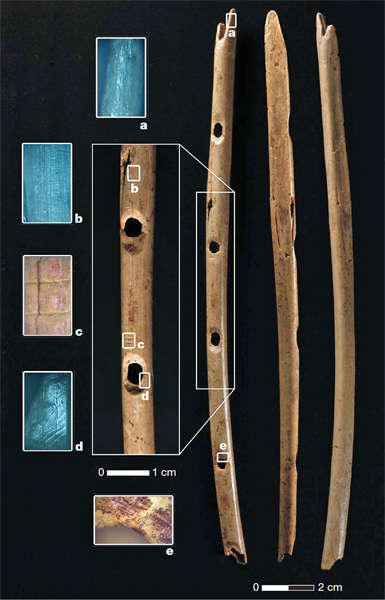
Bone flute from Hohle Fels archaeological horizon Vb.
Photomicrographs documenting striations and notches from manufactureand polish from use:
a, b, d, incident-light fluorescence mode (ultraviolet-and violet-light excitation);
c, e, incident light, obliquely crossed polars, λ plate.
The photomicrographs were made with a Leica DMRX-MPVSPmicroscope photometer. The long axis of the micrographs is 2.8mm long
The maker of the flute carved the instrument from the radius of a griffon vulture (Gyps fulvus ). This species has a wing span of between 230 and 265 cm and provides bones ideal for large flutes. Griffon vultures and other vultures are documented in the Upper Palaeolithic sediments of the Swabian caves with several examples identified from Gravettian and Aurignacian deposits at Geißenklösterle.
The preserved portion of flute1 from Hohle Fels has a length of 21.8cm and a diameter of about 8mm (Fig. 1). Comparisons with modern specimens indicate that the unmodified radius had a length of roughly 34cm. The surfaces of the flute and the structure of the bone are in excellent condition and reveal many details about the manufacture of the flute. The flute has five finger holes. The maker carved two deep, V-shaped notches into one end of the instrument, presumably to form the proximal end of the flute, into which the musician blew. This end of the flute corresponds to the proximal end of the radius. The other end of the flute is broken in the middle of the most distal of the five finger holes. Several centimetres of the flute are missing from this end. As many as four very fine lines were incised near the finger holes. These precisely carved markings probably reflect measurements used to indicate where the finger holes were to be carved using chipped-stone tools. Only the partly preserved, and most distal, of the five finger holes lacks such markings.
It is possible that the flute was played by blowing directly into the proximal end without using a mouthpiece. The smaller, three-holed bone flute, made from the radius of a swan, that was recovered from the Aurignacian deposits of archaeological horizon II at the nearby cave of Geißenklösterle can be played by blowing obliquely into its proximal end to produce four basic notes.
Three additional overtones can be produced by blowing more sharply into the flute. Given that the three-holed flute from Geißenklösterle produces a range of notes comparable to many modern kinds of flute, we expect flute 1 from Hohle Fels to provide a comparable, or perhaps greater, range of notes and musical possibilities. The larger diameter of the bone flute from Hohle Fels would have made its tone deeper than that of the bone flute from Geißenklösterle, and closer to that documented experimentally from a reconstruction of the ivory flute from archaeological horizon II at Geißenklösterle.
Photo and text: Conard et al. 2009
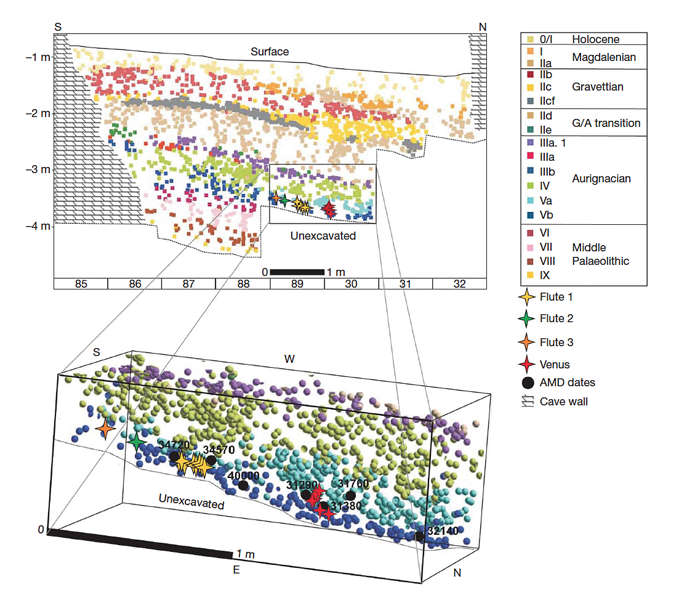
The stratigraphic positions of flutes 1–3 from Hohle Fels and associated radiocarbon dates. AMS, accelerator mass spectrometry (dates in noncalibrated years before present).
The 'Venus' marked on the diagram is the Venus of Hohle Fels.
The stratigraphic situation suggests that the flutes from the basal Aurignacian of Hohle Fels date from the initial Upper Palaeolithic settlement of the region, about 40 000 calendar years ago. These flutes pre-date the two bone flutes and the ivory flute from the upper Aurignacian at nearby Geißenklösterle.
Photo and text: Conard et al. 2009
Aurignacian musical instruments from the Swabian Jura
| Site | Flute | Archaeological horizon | Cultural group | Material | Number of pieces | Excavated | First publication |
|---|---|---|---|---|---|---|---|
| Geißenklösterle | 1 | II | Upper Aurignacian | Swan radius | 23 | 1990 | Hahn et al. (1995) |
| Geißenklösterle | 2 | II | Upper Aurignacian | Bird bone, swan size | 7 | 1973 | Hahn et al. (1995) |
| Geißenklösterle | 3 | II | Upper Aurignacian | Mammoth Ivory | 31 | 1974-1979 | Conard et al. (2004) |
| Hohle Fels | 1 | Vb | Basal Aurignacian | Griffon vulture radius | 12 | 2008 | - |
| Hohle Fels | 2 | Va.10 | Basal Aurignacian | Mammoth ivory | 1 | 2008 | - |
| Hohle Fels | 3 | Vb | Basal Aurignacian | Mammoth ivory | 1 | 2008 | - |
| Vogelherd | 1 | - | Aurignacian | Bird bone | 3 | 2005 | Conard et al. (2006) |
| Vogelherd | 2 | - | Aurignacian | Mammoth ivory | 1 | 2008 | - |

Hohle Fels. Two harpoons from the Magdalenian.
Photo: Conard (2002)

Canine tooth of a cave bear, drilled with a hole to use as a pendant, from Hohle Fels.
Photo: © Hilde Jensen, Inst. für Ur- und Frühgeschichte der Universität Tübingen
Source and text: Münzel (ca 2001)
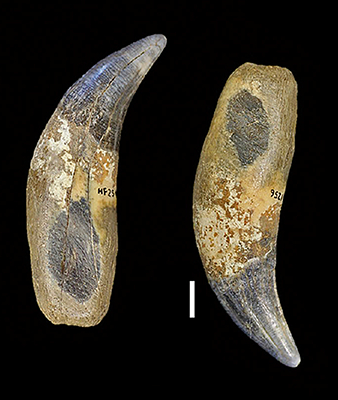
Lion canine, Hohle Fels, Layer Vaa, Aurignacian. Scale = 1 cm.
Photo and text: Toniato et al. (2018)
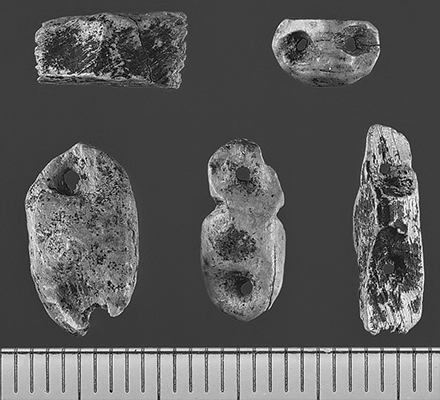
Double pierced ivory pendants or beads from the Aurignacian of Hohle Fels in various stages of production and wear.
Photo and text: Conard (2002)
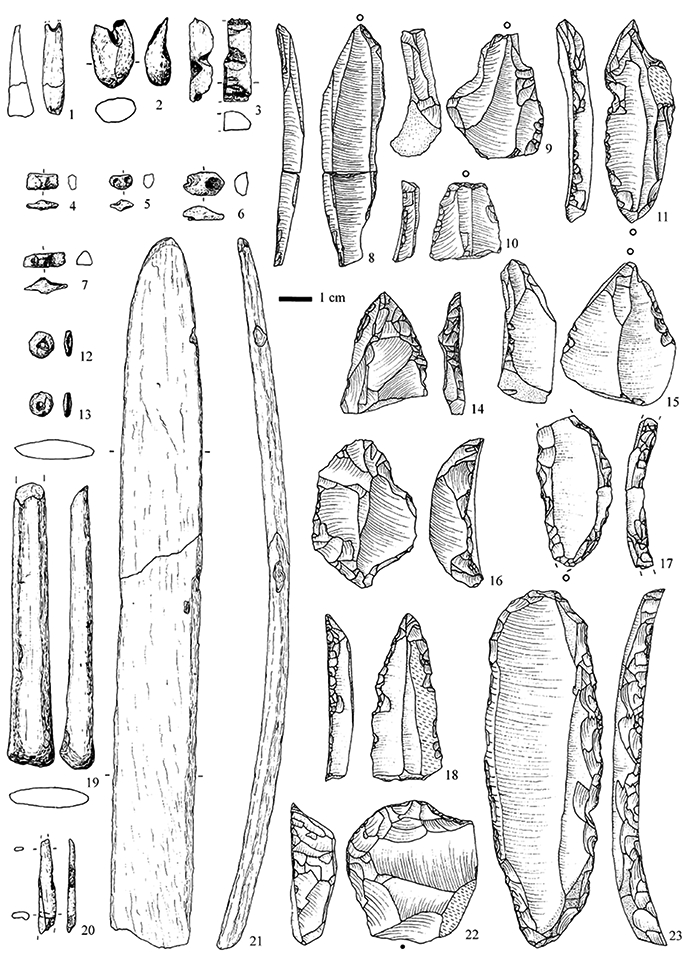
Aurignacian of Hohle Fels near Schelklingen. (1, 9–11, 15, 19, 21): AH III-(2–8, 12–14, 16–18, 20): AH IV-(22–23): AH V.
(1) perforated bear incisor
(2) perforated upper eyetooth from red deer
(3) roughout for ivory beads
(4) half-finished ivory bead
(5–7) double perforated ivory beads
(8–9) burins
(10) truncated blade
(11) busked burin
(12–13) disc-shaped ivory beads
(14) pointed blade
(15) carinated burin
(16) double nosed end scraper
(17) blade with Aurignacian retouch
(18) blade pointed at one end and truncated at the other
(19) bone awl with intense polishing
(20) fragment of a bone point
(21) worked mammoth rib
(22) nosed end scraper
(23) end scraper combined with a pointed end.
After Conard et al. (2002) (1–7, 11–18, 22–23); drawings by D. Punĉochář.
Photo and text: Conard & Bolus (2003)
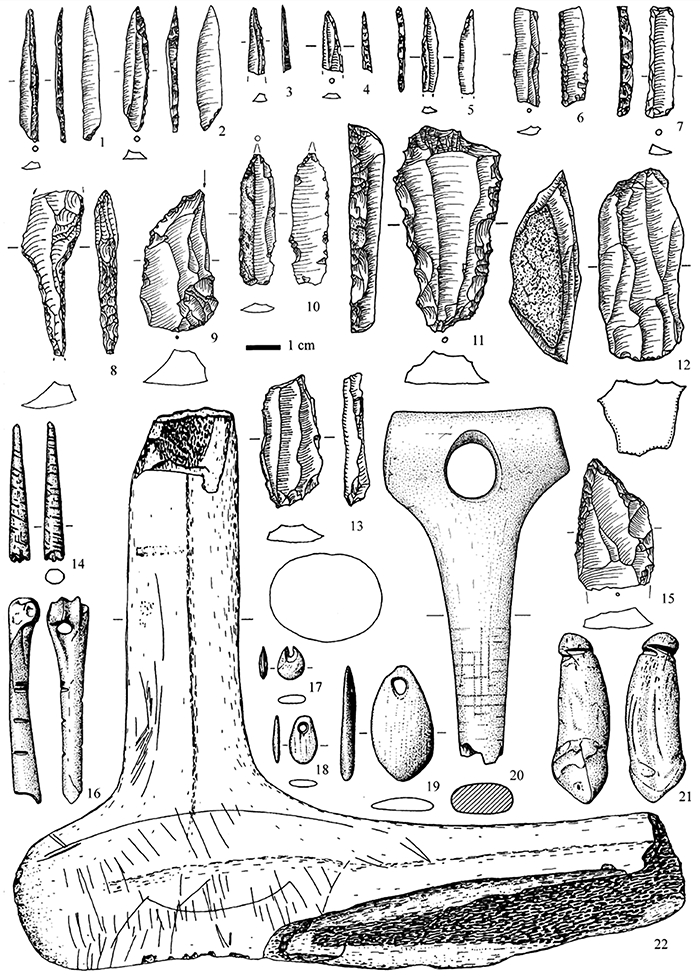
Gravettian of Hohle Fels near Schelklingen.
(1–4) Gravette points
(5) micro-Gravette point
(6–7) backed bladelets
(8) Font Robert point
(9, 13) burins
(10) borer
(11) end scraper
(12) bladelet core
(14) decorated bone point
(15) pointed blade
(16) decorated hare humerus
(17–19) ivory pendants
(20) bâton percé of antler
(21) pendant made of a bear canine
(22) decorated antler adze.
After Conard et al. (2001), Conard and Uerpmann (1999), Conard et al. (2000)
Photo and text: Conard & Bolus (2003)
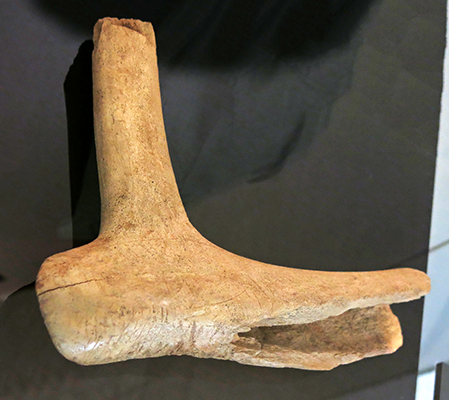
Decorated antler adze. See drawing above.
Photo: Don Hitchcock 2015
Text: Conard & Bolus (2003)
Source: Blaubeuren Museum
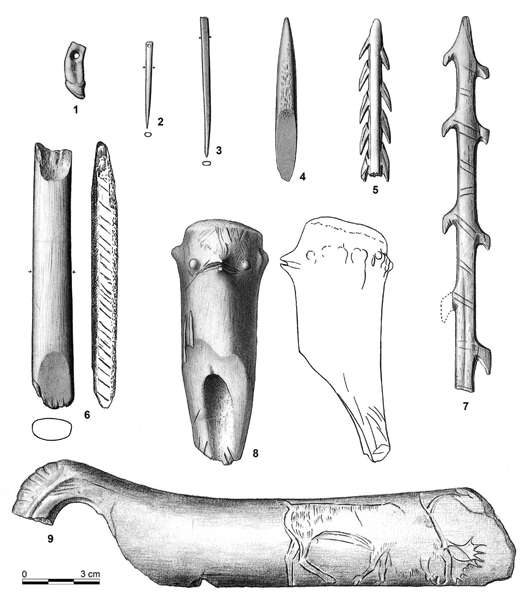
Organic tools, jewellery and art objects from the Magdalenian of Hohle Fels in Schelkingen (1, 3, 6), the Kesslerloch (2, 4-5, 7, 9) and from Andernach (8).
1 pierced wolf incisor
2-3 bone needles
4 antler tip with one side beveled base
5, 7 double row harpoons
6 bone point (?) with line decoration
8 bird illustration from the Rosenstück a Rengeweihs
9 pierced reindeer antler with engraved illustration of a reindeer
Photo: Schmidt (1912) pl XXI, XXX-XXXI, XXXVIII, in Bolus et al. (2012)
-->
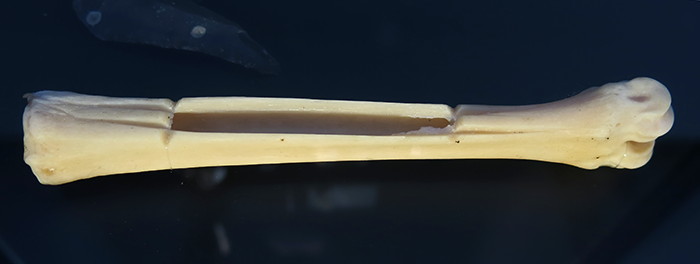
When making a bone needle, a rod is cut from a long bone by engraving with a burin over and over until the bone is cut through, and the rod is removed.
Photo: Don Hitchcock 2015
Source and text: Landesmuseum Württemberg, Stuttgart
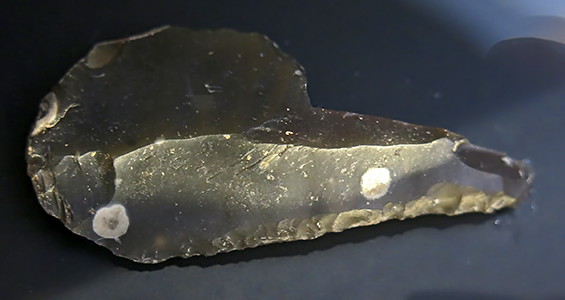
The tool shown here for releasing the rod from the bone is known as a parrot beak burin.
Photo: Don Hitchcock 2015
Source and text: Landesmuseum Württemberg, Stuttgart
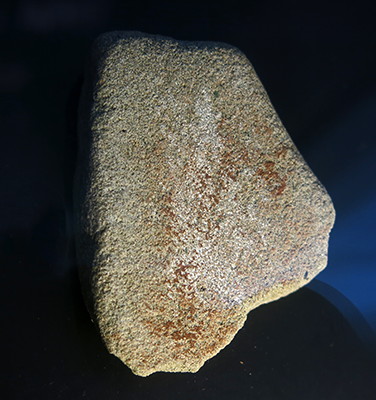
The rod is ground down to a needle shape by rubbing on rough sandstone or quartzite.
Photo: Don Hitchcock 2015
Source and text: Landesmuseum Württemberg, Stuttgart
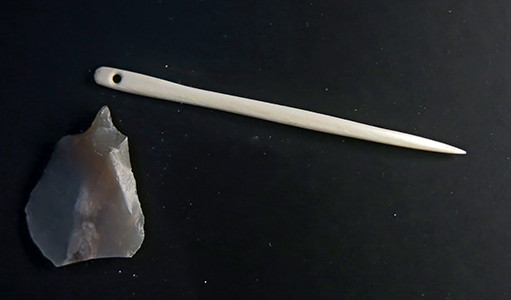
The finished needle, with a drill which was used to make the hole - this was done before the final finishing and trimming down of the rod to a needle.
Photo: Don Hitchcock 2015
Source and text: Landesmuseum Württemberg, Stuttgart
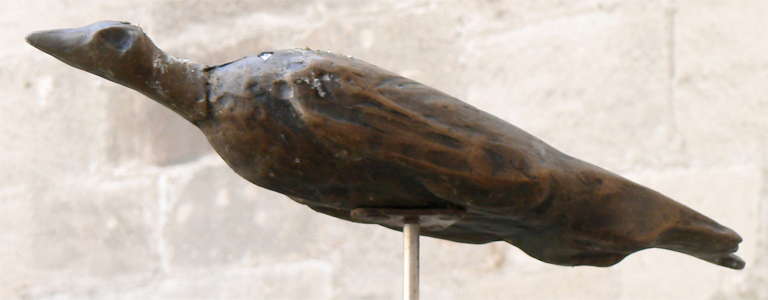
Wasservogel, a water bird from Hohle Fels, facsimile.
The original is carved from mammoth ivory and is 47 mm long. Age about 32 000 years. Locality near Schelklingen.
Photo and text: dierk schaefer
Permission: Creative Commons, Attribution 2.0 Generic (CC BY 2.0)
Date: 2011.05.16
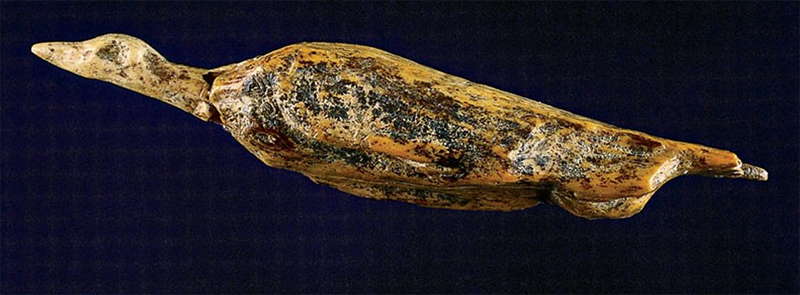
The sculpture depicts a water bird, perhaps a diver, cormorant or duck. The legs of the bird are short, but they lack feet, perhaps because to represent the bird in flight. The back is etched with a series of distinct lines representing feathers; 31 000 - 33 000 years old approximately; measures 47 x 13 x 9 mm; Hohle Fels, Germany
(this is either the original or a museum quality facsimile - Don )
Photo: © Universität Tübingen
Text: http://www.telegraph.co.uk/culture/culturepicturegalleries/9847457/Ice-Age-Art-in-pictures.html?frame=2470447
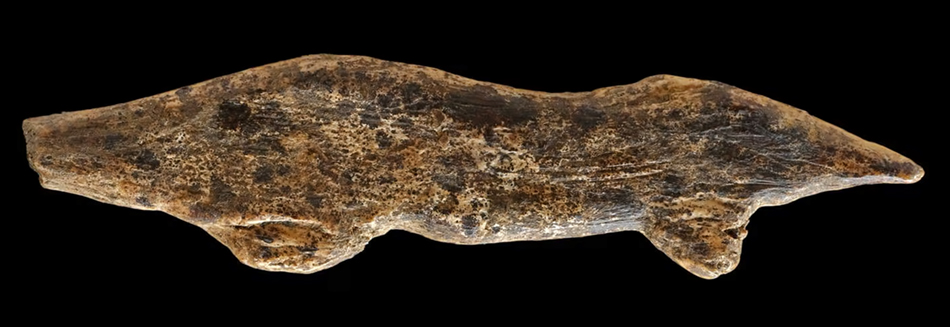
Archaeologists from Tübingen have presented the find of the year, discovered July 20th 2023 at Hohle Fels. It is an otter. The small figure is around six cm long, and is almost 40 000 years old. The tail is on the right, the head on the left is missing at the moment. The back is more curved than an otter's back normally is, but perhaps this is artistic licence.
As far as the significance of the find is concerned, the field of interpretation is wide. Ria Litzenberger says: 'The reason why these objects were made is not directly related to hunting success or survival, but rather it was probably more about what preoccupied the people, what their beliefs were, in other words: what was going on in their heads and not in their stomachs.' According to the researchers, the shape of the headless ivory figure is so unique that it also confirms their move away from the formerly popular interpretation that only large or dangerous animals were considered worthy of artistic representation in Ice Age hunter-gatherer societies.
It is therefore likely that the figurines have a connection to spiritual symbolism. It is not possible to say exactly what the Ice Age artist associated with his little otter around 38 000 years ago. 'People ate a lot of fish back then and were anglers. Perhaps they admired the otter's ability to catch fish,' speculates Conard. The professor does not want to commit to a single interpretation. Even in the case of the female figurines found, interpreting them solely as a symbol of fertility would be too simplistic.
Photo: Unattributed, but possibly © University of Tübingen, Ria Litzenberg
Text: © David Drenovak
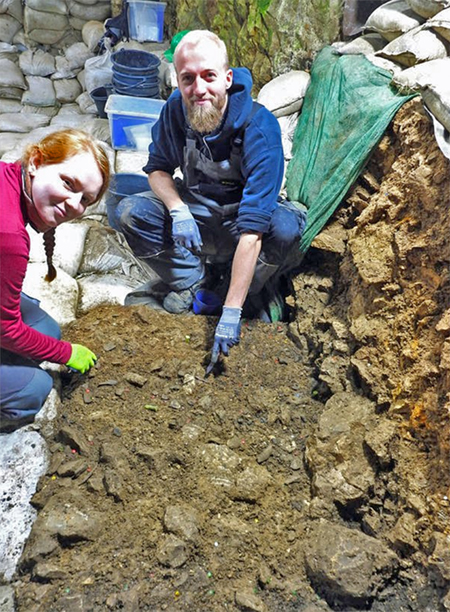
The ivory otter figure was discovered during excavations at Hohle Fels in Schelklingen by Frederik Mygdam, a young Danish student at the University of Arhus (right).
'This is probably the find of his life' says Professor Nicholas Conard with a grin on his face. The small ivory otter was found in the same layer of earth as the famous Venus figure.
Photo: Unattributed, proximal source Peter Schmid
Source: www.swr.de/swraktuell/baden-wuerttemberg/ulm/fund-des-jahres-otter-100.html
Text: Adapted from Peter Schmid
Hohle Fels - animal figure from left front.
Photo © University of Tübingen, Ria Litzenberg
During excavations in the World Heritage cave Hohle Fels in the Swabian Jura near Schelklingen, archaeologists recently recovered a fragment of a carefully carved ivory figurine that gives one of the most famous Ice Age works of art a new look: the figurine fragment turned out to be a piece of a body that was perfectly fitted to a animal figure head found more than 20 years ago. The head, recovered in 1999, became famous as the first ivory figurine found in Hohle Fels and had previously been interpreted as part of a horse figure.
Professor Nicholas Conard's team from the Department of Prehistory and Quaternary Ecology at the University of Tübingen is now questioning this assessment: "We still cannot identify the animal species depicted with certainty, but it could be a cave lion or a cave bear," said Professor Conard at one Press conference on the "Find of the Year" on Thursday. A scholarly publication on the figure, parts of which were recovered in layers of the Aurignacian Paleolithic culture and carved 35,000 years ago, appears in the current issue of the journal Archaeological Excavations in Baden-Württemberg, published by the Baden-Württemberg State Office for the Preservation of Monuments.
Professor Conard himself considers the work of art from the Upper Paleolithic to be a bear figure: "The figurine now has a massive body, shows the typical pronounced bear hump at shoulder height and presents itself in a posture that could imitate the trotting gait of a bear." But there is Even colleagues who ascribed the figure the anatomical and physiognomic properties of a cave lion, Professor Conard admits: »It is by no means always easy to determine Ice Age depictions with certainty, especially when they are preserved in such fragmentary form. It therefore makes sense to look particularly carefully for the missing parts of this animal in the years to come.«
In fact, the animal figure is now composed of five find fragments that were recovered in different years of excavation: Shortly thereafter, a small piece of the cheek was identified among the ivory finds and matched to the head found in 1999, which was broken off in the neck area. The find was exhibited in the Prehistoric Museum in Blaubeuren (urmu) for a good twenty years .
The new fragment The current ivory find, which is 3.99 centimeters long, 2.49 centimeters high and 0.55 centimeters thick and features several fine, deliberately engraved line patterns on one side, was identified as the animal's right shoulder and thorax shortly after excavation and attached. This led the researchers to look for other parts of the figurine among the numerous ivory finds from Hohle Fels. With success: Another small part of the right side of the body could be found on the basis of its engravings. This small piece of torso attached to the figure, like the other pieces, bears very fine lines of the same finish, which clearly demonstrate the coherence of the compositions. It is very likely that another fragment also belongs to the figure: it could be part of the left front leg,
The supplemented ivory figurine has now returned to the urmu, where it is on display to the public. "This figure shows us and our visitors like no other that the archaeological work is never finished," says Dr. Stefanie Kölbl, managing director of the Prehistoric Museum in Blaubeuren (urmu), which is also a branch museum of the Archaeological State Museum and a research museum at the University of Tübingen. In the building next door to the museum, the finds from Hohle Fels are read out in minute detail. "It's fascinating to see the excavators there at work with magnifying glasses and tweezers," says Dr. Kölbl, "and even more fascinating to realize that somehow nothing seems to be lost over this long, long time, and we can hope
Photo: © University of Tübingen, Ria Litzenberg Source: https://www.archaeologie-online.de/nachrichten/figurine-aus-der-eiszeit-zeigt-eine-neue-gestalt-5653/
Photo: © University of Tübingen, Ria Litzenberg
Source: https://www.archaeologie-online.de/nachrichten/figurine-aus-der-eiszeit-zeigt-eine-neue-gestalt-5653/
In 1999 the ivory head only was uncovered at Hohle Fels. At that time it was thought to be of a horse.
The object was found in the GH level 3d, that is to say in an intermediate position between the Gravettian levels and the Aurignacian levels of the cave.
The object is 36 mm long, 7 mm wide, 15 mm high and weighs 3.6 g. It is of ivory, recognisable by the lamellar structure quite typical of this raw material. The surfaces of the figurine are largely covered with manganese oxide dendrites. The nose and nostrils are clearly visible.
Photo and text: Conard et al. (2001)
There are no traces of eyes or ears but a hatching was thought to possibly represent the mane. Both cheeks are engraved with a decoration very similar to the Aurignacian statuettes from Vogelherd.
On the lower part of the head, there is a long oval engraved which is subdivided into transverse rows. The sculpted surfaces of the head are smooth, suggesting a prolonged handling of the piece. It is broken at the neck, which suggested, correctly as it turns out, that this was only part of a more complex sculpture, perhaps even an entire animal.
Two 14C dates of skeletal remains that were found in the immediate vicinity of the statue were made. These ages of 29 560 ± 230 BP (KIA 8964) and 30 010 ± 220 BP (KIA 8965) point out in an exemplary manner the stratigraphic position of the object just below the base of the Gravettian.
Photo and text: Conard et al. (2001)
Another version of the head.
Photo: © H. Jensen, University of Tübingen
Ancient phallus unearthed in cave
By Jonathan Amos
BBC News science reporter
http://news.bbc.co.uk/1/hi/sci/tech/4713323.stm
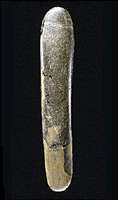
A sculpted and polished phallus found in a German cave is among the earliest representations of male sexuality ever uncovered, researchers say.
The 20cm long, 3cm wide stone object, which is dated to be about 28 000 years old, was buried in the famous Hohle Fels Cave near Ulm in the Swabian Jura.
The prehistoric 'tool' was reassembled from 14 fragments of siltstone.
Its life size suggests it may well have been used as a sex aid by its Ice Age makers, scientists report.
'In addition to being a symbolic representation of male genitalia, it was also at times used for knapping flints,' explained Professor Nicholas Conard, from the department of Early Prehistory and Quaternary Ecology, at Tübingen University.
'There are some areas where it has some very typical scars from that,' he told the BBC News website.
Researchers believe the object's distinctive form and etched rings around one end mean there can be little doubt as to its symbolic nature.
Photo and text: http://news.bbc.co.uk/1/hi/sci/tech/4713323.stm
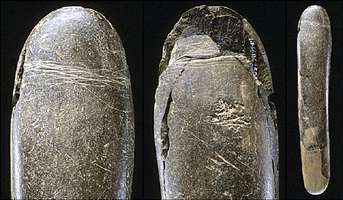
'It's highly polished; it's clearly recognisable,' said Professor Conard.
The Tübingen team working Hohle Fels already had 13 fractured parts of the phallus in storage, but it was only with the discovery of a 14th fragment last year that the team was able finally to put the "jigsaw" together.
Photo and text: http://news.bbc.co.uk/1/hi/sci/tech/4713323.stm

The different stone sections were all recovered from a well-dated ash layer in the cave complex associated with the activities of modern humans (not their pre-historic "cousins", the Neanderthals).
The dig site is one of the most remarkable in central Europe. Hohle Fels stands more than 500m above sea level in the Ach River Valley and has produced thousands of Upper Palaeolithic items.
Photo: http://www.tagesspiegel.de/wissen/archaeologie-eiszeit-kunstwerke-gefunden/876156.html
Text: http://news.bbc.co.uk/1/hi/sci/tech/4713323.stm

Phallus, circa 30 000 BP
This phallus from Hohle Fels was reconstructed from fourteen fragments. This approximately 30 000 year old and almost 20 centimetres long piece of grey-green siltstone weighs 287 grams.
Photo: Hannes Wiedmann
Permission: This file is licensed under the Creative Commons Attribution-Share Alike 4.0 International license.
Source and text: Wikipedia
Ice Age Paintings from the Swabian Jura, Southwestern Germany Document the Earliest Painting Tradition in Central Europe
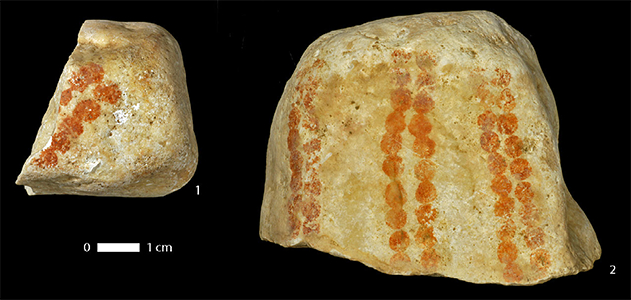
Hohle Fels 2010. Two painted limestone cobbles with parallel lines of red dots.
ScienceDaily (Nov. 8, 2011) — Recent excavations conducted by the University of Tübingen at Hohle Fels Cave in the Swabian Jura of southwestern Germany have produced new evidence for the earliest painting tradition in Central Europe about 15 000 years ago. This period is referred to as the Magdalenian and is named after the site of La Madeleine in France.
Three of the new paintings show double rows of red dots on limestone cobbles, while one painted fragment may originate from the wall of the cave. These are the first examples of painted rocks recovered in Germany since 1998 when Prof. Nicholas Conard's team working at Hohle Fels discovered a single painted rock.
In addition to the painted rocks, finds of ochre and hematite that were used to make pigments have also been recovered.
Although Ice Age cave paintings are well documented in western Europe, particularly in France and Spain, wall paintings are unknown in central Europe. The lack of wall paintings at Hohle Fels in particular as well as in Central Europe as a whole may in part be a reflection of the harsh climate of the region that continually led to the erosion and damage to the walls of the caves.
The paintings from Hohle Fels Cave in the Ach Valley near Schelklingen document the oldest tradition of painting in central Europe. The painted limestone cobbles from Hohle Fels all show very similar motifs, and these rows of painted red dots certainly must have had a particular meaning to the inhabitants of the region. This being said, unlike the many examples of painting of animals in the Paleolithic art, these abstract depictions remain difficult to interpret.
Photo: Marina Malina, University of Tübingen, Wolf et al. (2018)
Painted stones from Hohle Fels
Limestone with paintings of double lines of red ochre dots, Circa 15 000 BP
Red ochre is a mineral colour, and consists of a soft mixture of clay, chalk and haematite (Fe2O3), an iron oxide mineral.
Photo: Don Hitchcock 2015
On loan from Archaologishches Landesmuseum Baden-Wurttemberg
Source: Blaubeuren Museum
Additional text: Wikipedia

Painted stone from Hohle Fels, possibly part of a mural painting, circa 15 000 BP
Red ochre on limestone.
Photo: Don Hitchcock 2015
On loan from the Archäologisches Landesmuseum Baden-Württemberg
Source: Blaubeuren Museum
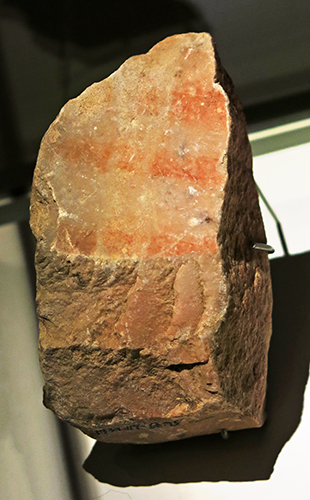
Painted stone from Hohle Fels
Circa 15 000 BP
Red ochre on limestone.
On loan from the Archäologisches Landesmuseum Baden-Württemberg
Photo: Don Hitchcock 2015
Source: Blaubeuren Museum
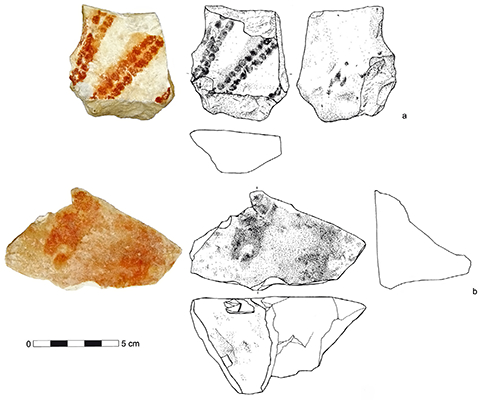
Hohle Fels, painted limestones, excavated 2009.
Photo: M. Malina, Drawings: R. Ehmann.
Source: Wolf et al. (2018)
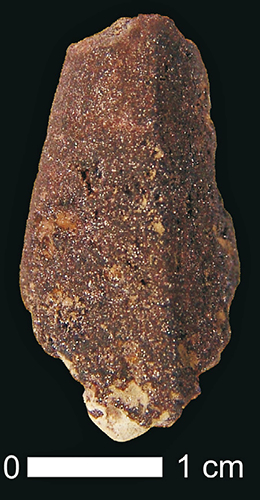
Hohle Fels, haematite fragment, excavated 2009.
One Magdalenian haematite fragment (Find 102/630.1) was found in AH IIag in 2009 and is 23 x 13 x 8 mm in size. The fragment is dark purple and contains numerous mica inclusions thereby rendering a “glittery” luster common of specular haematite or specularite. The worked faces display two faceted or flattened juxtaposed surfaces, forming a single ridge along the artefact. In anthropogenically modified ochre pieces, faceting is often a by-product of grinding or rubbing, though it may not directly show striations or micro-striations. The primary purpose of grinding of ochre materials is to acquire pigments or fine powder more efficiently. Rubbing or soft-surface grinding suggests direct skin contact, whether on animal hides or human skin.
Photo: M. Malina
Source and text: Wolf et al. (2018)
Hohle Fels, 'crayon'-shaped artefact made from ochre, excavated 2009, four views.
A red ochre chalk piece (Find 102/555.1) was found in 2009 in AH IIaf and measures 8 x 7 x 6 mm. It shows three worked surfaces with highly weathered scoring or incision marks, flanked by micro-striations. This artefact has been described as a 'crayon', that indicates direct pigment application on a flat surface, similar to a real crayon or writing utensil.
However, for the red chalk piece from Hohle Fels, this scenario seems unlikely, given the high amount of use-traces on three of the small surfaces which indicate intensive grinding. Furthermore, the tip that was broken or removed from the piece shows no indication of direct contact. During experiments conducted by Lyn Wadley, she found that ochre fragments, morphologically defined as 'crayons,' could indeed be the by-product of powder production from ochre nodules. Even so, the piece from Hohle Fels is unique amongst known modified ochre artefacts, as the colour and texture differ from that of haematite. It is also one of the only pieces with both micro-striations and scoring marks, indicating a variety of modifications and perhaps the utilisation of different tool types.
Photo: M. Malina
Source and text: Wolf et al. (2018)

Hohle Fels, fragments of haematite rondelle(s), excavated 2010.
The Rondelle consists of three separate fragments, two of which fit together (Find 110/1104.1 & 110/992). The latter come from AH IIad. When combined, these pieces construct a unique artefact, as the nature of modification suggests that the pieces were shaped and not necessarily used for acquiring pigment, though both scenarios could have occurred simultaneously. Together, the two refitted pieces are made of the same haematite rich material and measure 34 x 21 x 4 mm.
The outer edge of the complete ochre artefact depicts the arc of a circle, with a ground hole in the centre. Its appearance suggests a pendant; however, the exact function of this object is unclear. Further micro-wear and residue analyses of the central perforation may provide more information. The smaller third piece (Find 110/434.1), which also appears to be haematite, measures 20 x 14 x 1 mm and was uncovered in AH IIad. Even though there is no evidence of a ground central hole, the rounded edges show clear striations indicating that grinding on a hard stone was the primary shaping mechanism. Though the smaller piece does not refit with the larger, the similar rounded edge suggests the pieces were originally comparable in their appearance and function.
Photo: M. Malina
Source and text: Wolf et al. (2018)
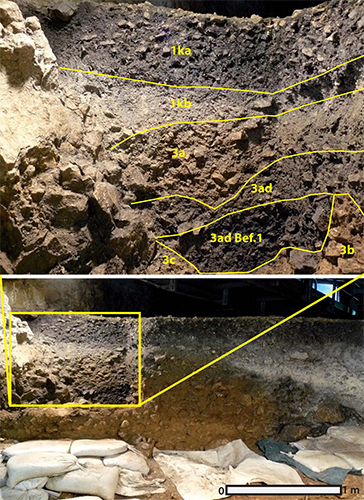
Hohle Fels Cave, stratigraphy, Magdalenian geological horizons.
Photo: After Conard and Malina (2011)
Proximal source:Wolf et al. (2018)
The walk from Hohle Fels to Sirgenstein
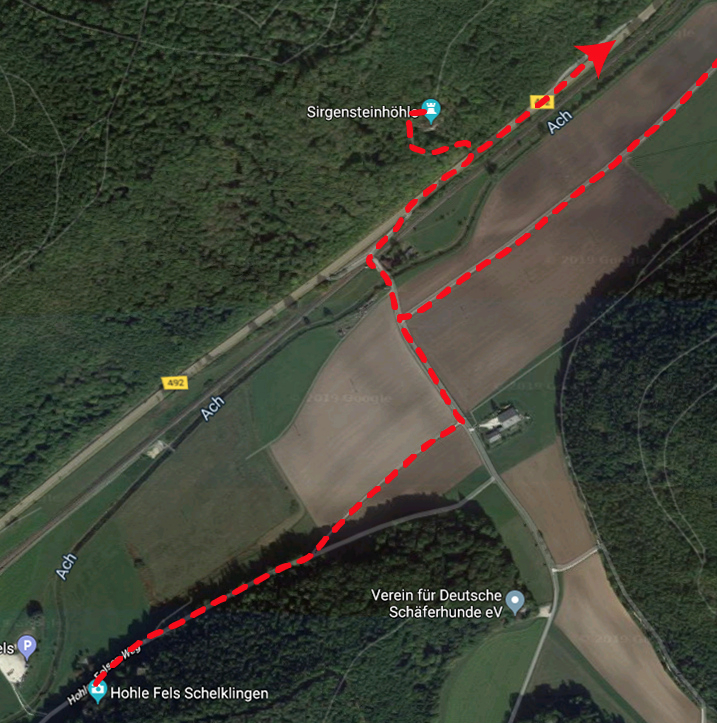
The route from Hohle Fels to Sirgensteinhöhle, then return to Blaubeuren train station via the main road, B 492.
As always, click on the photo to see the full size version.
Photo: After Google Maps
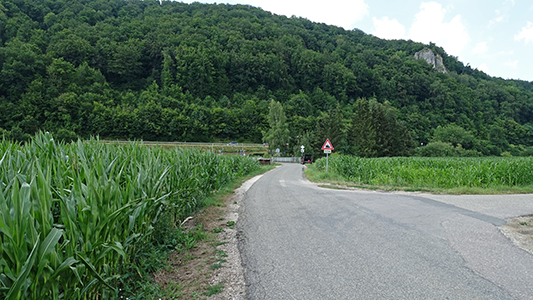
Approaching the bridge over the Ach River on the way to Sirgensteinhöhle.
Photo: Don Hitchcock 2018
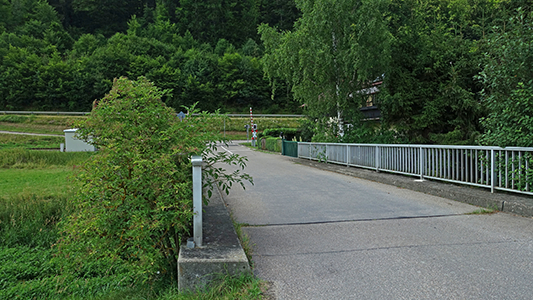
Immediately after the bridge is a railway crossing, which allows travellers to then reach the main road.
Photo: Don Hitchcock 2018
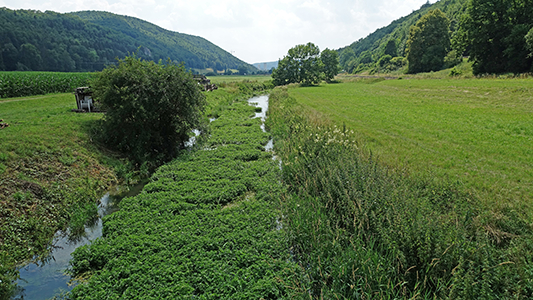
The Ach is only a small river at the end of summer.
Photo: Don Hitchcock 2018
The entry to the walk up to Sirgensteinhöhle may be reached from this pull-off on the main highway, B 492.
The sign marking the entry to the walk up to the cave may be made out in the bushes to the left of the building in the left hand photograph.
Photo: Don Hitchcock 2018
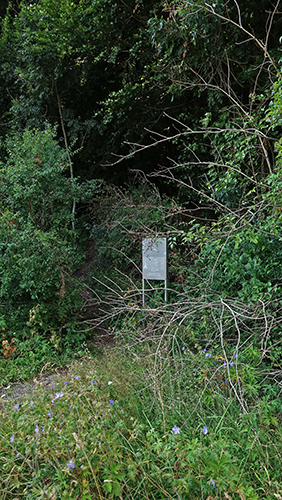
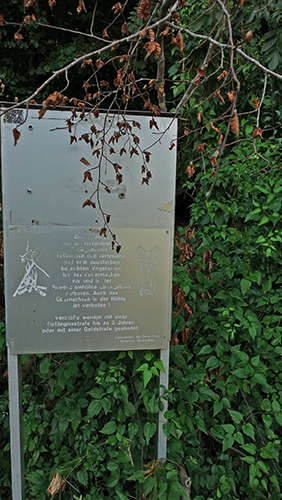
The sign is inconspicuous, hidden by vegetation to some extent, and faded, but at least marks the starting point for the walk.
Photo: Don Hitchcock 2018
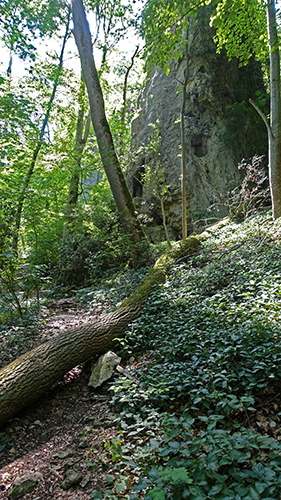

The short walk to the cave is very pleasant.
Photo: Don Hitchcock 2018
Sirgenstein
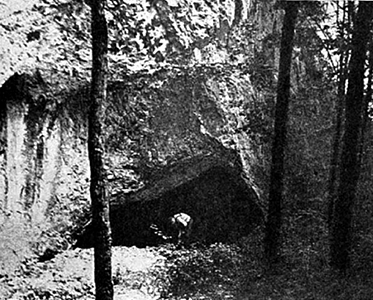
Old photograph of the entrance to Sirgenstein, probably at the time it was first excavated in 1906 by Schmidt.
Photo: Unknown
Source: Osborn (1915)
Of all the stations along the Danube, by far the most important is that of Sirgenstein, lying between the modern cities of Nuremberg and Augsberg, which was first occupied by the Neanderthals in early Mousterian times and continued to be visited by the Lower and Upper Palaeolithic men until the very close of the Upper Palaeolithic. The continuous section of this remarkable cavern yields afforded Schmidt (1910), who began his researches here in the spring of 1906, a key to the prehistory of all the eighteen caverns in the region of the upper Danube and upper Rhine. In Sirgenstein the primitive Mousterian culture of the early Neanderthals was found, together with the remains of the mammoth, bison, reindeer, a species of wild horse, and the cave bear. This Mousterian industry closed with a record of the arrival in this region of the Obi lemming from Northern Russia. Later on the Cro-Magnon race of Aurignacian times left on the floor of the cavern remains of their flint industry and of their feasts, including the bones of the woolly rhinoceros, mammoth, stag, and reindeer.Text above: Osborn (1915)
During Upper Palaeolithic Solutrean times ( this is now thought to be Gravettian - Don ) it was again inhabited by man, and coincident with his return is the arrival of a great migration of the banded lemming (Myodedes torquatus) from the arctic tundras of the north. Finally, towards the end of the Upper Palaeolithic, in late Magdalenian times, another climatic transition is indicated by the appearance of the pika, or tailless hare (Lagomys pusillus). During the Bronze Age, this favourite grotto was again entered, and it was also inhabited during a portion of the Iron Age. The debris of these various cultures, hearths, and deposits of cave loam reach a total thickness of 8½ feet and mark Sirgenstein as first in rank among the Palaeolithic stations of Germany.
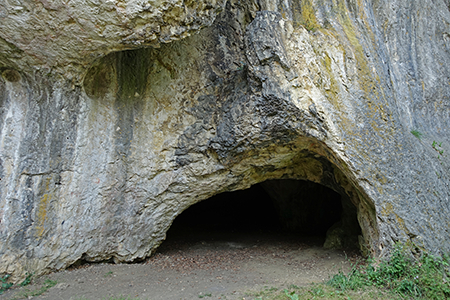
The entrance to Sirgenstein, a Palaeolithic cave site in the Lonetal.
Sirgenstein cave stands 35 metres above the valley bottom. R.R. Schmidt excavated at Sirgenstein in the summer and autumn of 1906 (Schmidt, 1910, 1912). He distinguished eight archaeological layers and correlated them with the French chronological system: one Magdalenian, one 'Solutreen' (Gravettian), four Aurignacian and two Middle Palaeolithic layers (type 'La Quina'and 'Primitiv-Mousterien').
The lithic material from the Middle Palaeolithic was reanalysed by Çep (1996). Between the Middle Palaeolithic layers VIII/ VII and the Upper Palaeolithic layer VI, Schmidt mentioned a thin sterile layer with a concentration of small rodents. (untere Nagerschicht ). He suggested a possible hiatus in human occupation between the Middle and the Upper Palaeolithic, but argued that the typology of the stone tools shows a continuity.
Photo: Don Hitchcock 2018
Text: Münzel et al. (2004)

Aurignacian of Sirgenstein cave
(1–2, 5–6, 9, 11–12, 14, 21): Sirgenstein IV
(3–4, 7, 10, 13, 16, 18–20): Sirgenstein V
(8, 15, 17): Sirgenstein VI.
(1–2, 7) carinated end scrapers
(3, 6) nosed end scrapers
(4) pointed blade
(5) end scraper
(8, 12) dihedral burins
(9, 13) burins on truncation
(10) borer
(11) ivory bead
(14) carinated burin
(15) bone awl
(16) truncated blade
(17) laterally retouched blade
(18) splintered piece
(19–20) bone points
(21) burnisher.
After Hahn (1977)
Photo and text: Conard & Bolus (2003)
The entry corridor (often called 'The Vestibule') is quite dark, and with a low ceiling.
Photo: Don Hitchcock 2018
The floor is flat from side to side, since it was completely excavated in 1906.
The floor was so flat, in fact, that it seemed to me that it must flood with water from time to time.
Photo: Don Hitchcock 2018
Finally light appears, from holes in the vault of the cave.
Photo: Don Hitchcock 2018
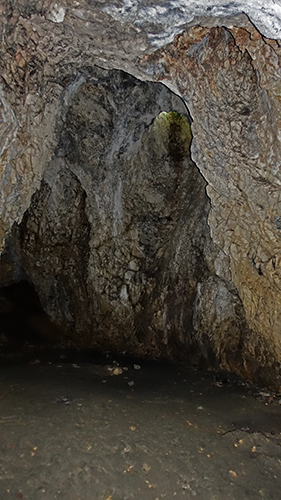
It was good to get to the well-lit end chamber.
Photo: Don Hitchcock 2018

As well as giving light, the holes in the roof would have provided a way for smoke from the hearth to exit the chamber.
Photo: Don Hitchcock 2018
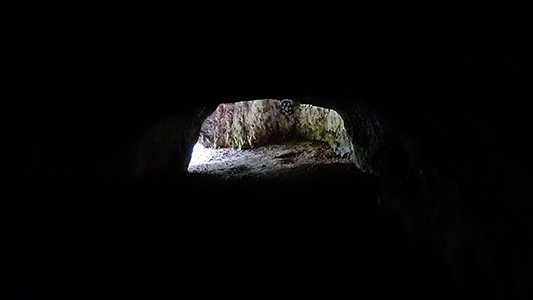
The exit was a welcome sight - though the visit to the cave was a wonderful experience.
Photo: Don Hitchcock 2018

Middle Palaeolithic fauna of Sirgenstein VIII and VII.
The faunal analysis was conducted by Koken, a palaeontologist at the University of Tübingen (Koken in Schmidt, 1912) Koken produced a species list, but no quantitative results, except remarks like 'common' or 'very common'. Schmidt mentioned 90% cave bear in the Middle Palaeolithic layers, but so far very few of these specimens have been found in the collections of the University of Tübingen. Horse is the second most important species, followed by reindeer and giant deer; the latter is represented by two bone retouchers.
Mammoth is represented only by an unworked piece of tusk from a juvenile animal. Schmidt argued that all the fauna was hunted by man, including the cave bears. Many of the large bones, including those of cave bear, he wrote, showed traces of impact fractures, and only a few gnawing marks from hyena were observed.
Trying to reanalyse and quantify the fauna for the Middle Palaeolithic layers at Sirgenstein, we recognised that despite the careful excavation, many of the faunal remains are missing. For example, cave bear should have been ‘very common’ in all layers, but the available faunal inventory is very small, considering the size of the cave and assuming that cave bear hibernated in Sirgenstein. Thus the quantitative results for layers VII and VIII are not conclusive.
Photo and text: Münzel et al. (2004)
| Mammalian Fauna at Sirgenstein |
|
|---|---|
| Scientific name | Common name |
| Sorex sp. | Shrew |
| Talpa europaea | European mole |
| Talpa magna (archaic) | Mole family |
| Myotis sp. | Mouse-eared bat |
| Homo sapiens neanderthalensis | Neanderthal human |
| Lepus sp. | Hare |
| Cricetus sp. | Hamster |
| Arvicola sp | Water vole |
| Mus musculus | House mouse |
| Alopex lagopus (archaic, now Vulpes lagopus) | Arctic Fox |
| Canis sp. | Dog |
| Canis lupus | Wolf |
| Vulpes vulpes | Red fox |
| Ursus spelaeus | Cave bear |
| Gulo gulo | Wolverine |
| Lutra lutra | Eurasian otter |
| Mustela sp. | Weasel, badger, otter family |
| Putorius sp. (archaic, probably Mustela sp.) | Family of weasels, badgers, otters etc. |
| Putorius putorius (archaic, now Mustela putorius) | European polecat |
| Crocuta crocuta spelaea | Cave hyena |
| Felis sp. | Cat family |
| Lynx lynx | Eurasian lynx |
| Panthera leo spelaea (archaic, now Panthera spelaea) | European cave lion |
| Panthera pardus | Leopard |
| Mammuthus primigenius | Woolly mammoth |
| Equus sp. | Horse family |
| Coelodonta antiquitatis | Woolly rhinoceros |
| Cervus elaphus | Red deer |
| Rangifer tarandus | Reindeer |
| Bison priscus | Steppe bison |
| Capra ibex-pyrenaica | Pyrenean ibex |
| Ovis argaloides | Argali sheep |
| Other Fauna at Sirgenstein | |
| Aves | Birds |
| Amphibia | Frogs, toads, and salamanders |
| Pisces | Fish |
Data above adapted from Schmidt (1910, 1912)
Proximal source: https://doi.pangaea.de/10.1594/PANGAEA.64558
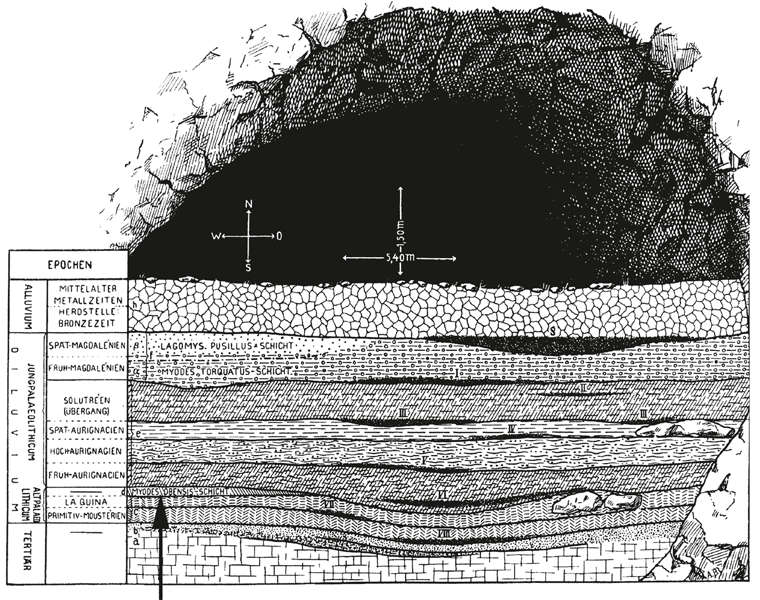
Transverse profile at the entrance of the Sirgenstein. The arrow points to the archaeologically sterile rodent layer between the Middle and Upper Palaeolithic.
Human activities
The profile below the entrance shows a vertical sequence of ash lenses or hearths dating from the Middle Palaeolithic to the Middle Ages (Schmidt, 1912). During the whole sequence the entrance was the preferred place of occupation. Each of the two Middle Palaeolithic layers contained a hearth, with that of layer VIII being the larger. The stratigraphic position of the hearths indicates at least two different periods of Neanderthal occupation.
Neanderthal activities, however, are not just reflected by stone tools and fireplaces, but also in the bones. Despite the small quantity of faunal remains, there are some clear cutmarks on horse bones including a first phalanx and a proximal metacarpal. These two levels also yielded several retouchers or 'compresseurs' from long bone shafts of giant deer and horse, as well as a retouched bone that resembles a side scraper. The use of shaft fragments as retouchers is well documented in both the Middle and Upper Palaeolithic of Swabia (Taute, 1965)
Photo: Schmidt (1912), in Bolus et al. (2012)
Text: Münzel et al. (2004)
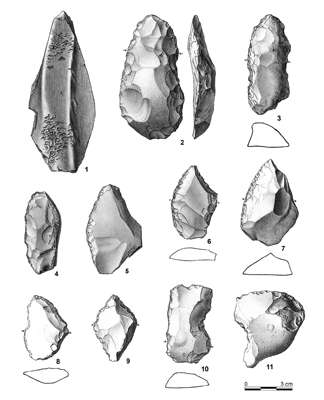
Sirgenstein. Typical tools of the 'lower Diluvial layers'. 1-7 'Herdzone' VII La Quina culture (late Mousterian)'; 8-11 'Herdzone' VIII 'primitive Mousterian'. Both inventories are placed by Schmidt in the Upper Palaeolithic, but in the terminology of most researchers today they are assigned to the Middle Palaeolithic.
1 Bone retoucher (see colour image below)
2 Laurel leaf pieces ('mallet shaped scraper with retouching on both surfaces')
3-4, scrapers with Quina retouch
5-6 scrapers
8-9 pointed scrapers
10 Piece with a concavity
11 Scraper with a concavity
After Schmidt (1912), Plates I-III.
Photo: Schmidt (1912), in Bolus et al. (2012)
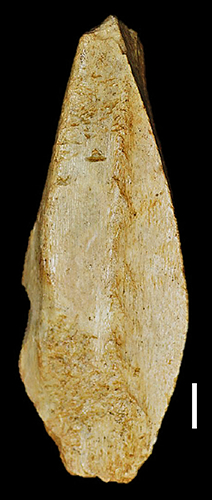
Giant deer tibia retoucher, Sirgenstein, Layer VII, Middle Palaeolithic.
(See the drawing number 1 in the image above)
Photo and text: Toniato et al. (2018)

Sirgenstein - stone tools from the Aurignacian of Sirgenstein (layer 'Herdzone' V: 1-3, 6, 8-10, layer 'Herdzone' VI: 7, 11) and the Bocksteinhöhle (4-5).
1,3 Kielkratzer, or keeled/ridged grattoirs, Grattoirs carénés
2 nosed scraper or Grattoir à museau
4,5 Bogenstichel, burins busqués, beaked burins (typical of the Middle Aurignacian - Don )
6, 10 scrapers with retouched edges
7 simple scraper
8 Point with retouched end
9 pointed blade
11 retouched edge blade
After Schmidt (1912), Plates III-V, XIX.
Photo: Schmidt (1912), in Bolus et al. (2012)

Sirgenstein - Bone/antler/ivory tools and ornaments from the Aurignacian of Sirgenstein (layer / 'Herdzone' IV: 2, layer / 'Herdzone' VI: 1), the Großen Ofnet (Große Grotte?) (3) and the Bocksteinhöhle (4).
1 Bone awl
2 double perforated ivory bead
3-4 Split-based spear points
After Schmidt (1912), Plates III, VII, XII, XX.
Photo: Schmidt (1912), in Bolus et al. (2012)
Große Grotte
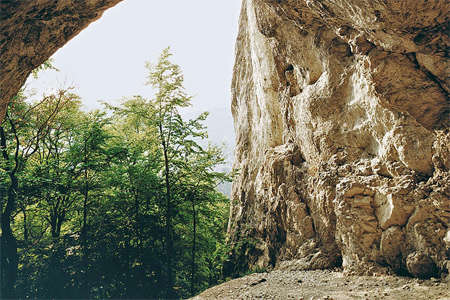
Große Grotte was used by Neanderthals as living quarters. . Eleven layers have been documented that are 100 000 to 50 000 years old. They are among the oldest Neanderthal evidence from the Swabian Alb. Of great importance is the discovery of a bone spear tip. Tools made of animal materials are extremely rare for Neanderthals. The reasons for the preference of the Neanderthals for this site as a place to live are easy to see. The view of the valley and thus the hunting is excellent. the Ibex was the favourite food of the Neanderthals, but they also brought reindeer, wild horse, red deer and bison to the cave.
Photo and text: http://www.blaubeuren.de/de/Tourismus/H%C3%B6hlen/Gro%C3%9Fe-Grotte
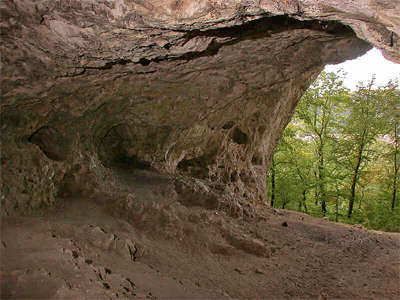
Große Grotte (Big Grotto) was named thus because of the fact that it is really big and a grotto! The term grotte was used in German for a very short cave, in general a cave which is higher than deep. Such a cave has no totally dark part. It is bright and dry, and has enough room for a large group of people. Facing towards southwest the sun shines in during the afternoon, and the place is a warm and dry place. Today it is surrounded by trees, but during the ice age, without the trees, it had a fine view over the surrounding countryside.
The Große Grotte was excavated between 1960 and 1964 by the archaeologist Prof. G. Riek. The results were impressive, but not as extraordinary as the artworks of the nearby caves of the Aach valley. This cave was visited by Neanderthals between 60 000 BP and 45 000 BP. This was the beginning of the last cold period of the Ice Age, and so the cave was used only for short times, as climatic conditions made a continuous settlement impossible. The archaeologists believe the cave was visited the cave every 100 to 1 000 days, for a few days while on a hunting trip. It is possible the cave as used not only as a shelter, but also as a viewpoint to wait for groups of prey animals crossing the valley.
Today the cave is a popular stopping point for hikers. The path from the Blaubeuren village up to the castle has a short branch off to the cave. Several climbing routes on the rock make it a popular location for climbers, and several routes start in the cave. The cave is visible from far, at its location at the foot of the cliff. Together with the castle above it is a romantic motif, drawn and painted for centuries. It is one of the highlights of Blaubeuren.
Photo and text: http://www.showcaves.com/english/de/caves/GrosseGrotte.html
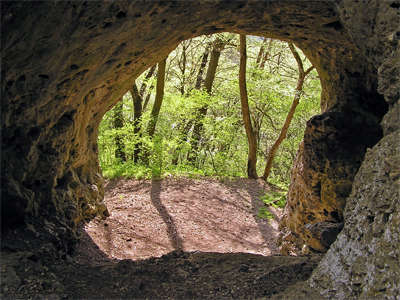
Große Grotte
Photo: © Gisela Geprägs via Panoramio
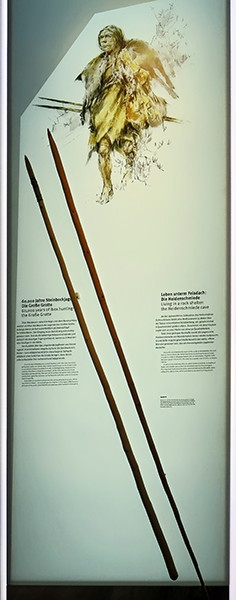
60 000 years of ibex hunting: the Große Grotte
On a hill east of Blaubeuren, a small Swabian town near Ulm, the Hohengerhausen castle ruin stands atop a stone massif known as the Große Grotte, a cave whose entrance is visible from afar. In the beginning, the grotto was nothing more than a refuge for cave bears. At the time, the entrance must have been narrow and low. Then part of the rockface facing the valley collapsed and formed a gate-like entrance, so that Neanderthals then came to the grotto more frequently.
It provided an excellent lookout over the surrounding hunting area, which was home to ibexes - an unusual species of game in this region. Bones found in all levels of the grotto show that this rare prey was often hunted in these parts.
( note that Neanderthals did not use separate heads on their relatively short, heavy spears. They simply sharpened one end of the wooden spear, perhaps fire hardening it, as far as we can tell - Don )
Photo: unknown artist and artisans
Rephotography: Don Hitchcock 2015
Treasures from the rubble
Two and a half metres deep deposits in the Große Grotte near Blaubeuren testify to intensive use at multiple times by the Neanderthals. It began 110 000 years ago and lasted for over 60 000 years.
The material found comprises around 2 000 artefacts and waste pieces from eleven overlying horizons. Layer 11 bears witness to the oldest habitation, layer 2 of the most recent.
Source and text: Landesmuseum Württemberg, Stuttgart
Text below from:
https://www.urmu.de/de/Forschung-Archaeologie/Fundstellen/Grosse-Grotte-(Blaubeuren)
Levallois cores, tees and Levallois tips were found in the lowest found layer XI on the cave floor.
In the inventories of layer X, scraper forms also occur. The basal layers are placed in time in the outgoing Eem-Warmzeit period about 80 000 years ago.
There are only a few artefacts from layer IX. With two hand-axes and a hand-ax scraper, they mark the micoquian, which begins with the start of the Würm glacial.
The layers VIII to III provided a handaxe-free, pure flake industry with a low incidence of Levallois tools. With numerous scraper shapes such as bow, concave, angled, straight and wide scrapers they indicate a Mousterian period of the early Würm Ice Age.
The largest find proportion was shown in layer II. Typical spiked scrapers, wedge-shaped scrapers and two blade tips, as well as a sharpened bony point with a D-shaped cross-section, indicate a younger stage of the Mousterian (early phase of the Alt mühl group), which is placed at the end of the early Würm.
Whether or not the irregular wall of limestone blocks found in layer II, which ran across the cave, can be considered as a settlement structure of Neanderthal man, must remain open, since the upper edge of the layer was no longer present.
Among the animal remains the cave bear is most commonly represented. As a hunting fauna of the Neanderthal man, Ibex are plentiful, but less numerous are reindeer, wild horse, red deer, fox and hare. There are also some remnants of mammoth, wooly rhinoceros, bison and hyena.
For the time being, (2016 - 2019+) the cave can not be visited due to the risk of falling rocks.
GPS data 48 ° 24'22 "N, 9 ° 48'05" E
Path to the Große Grotte
The Große Grotte is located below the castle ruins Hohengerhausen, called Rusenschloß, above the Blautals in the steep slope between Blaubeuren and Gerhausen.
It can be reached either from the so-called virtue path or from Rusenschloß on hiking trails.
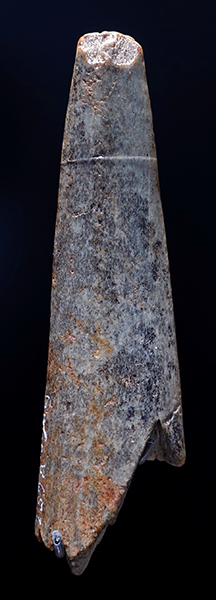
Spear point, Reindeer antler.
Große Grotte, Blaubeuren-Gerhausen, Alb-Donau-Kreis, circa 50 000 BP
Photo: Don Hitchcock 2018
Source and text: Landesmuseum Württemberg, Stuttgart
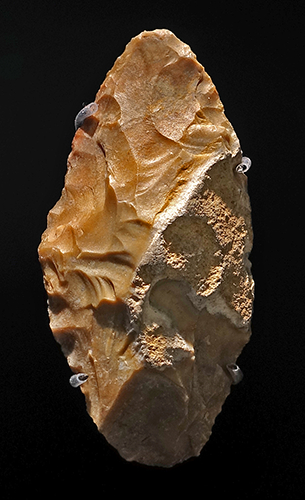
Leaf point, Jurahornstein, Jurassic chert.
Große Grotte, Blaubeuren-Gerhausen, Alb-Donau-Kreis, circa 50 000 BP
Photo: Don Hitchcock 2018
Source and text: Landesmuseum Württemberg, Stuttgart
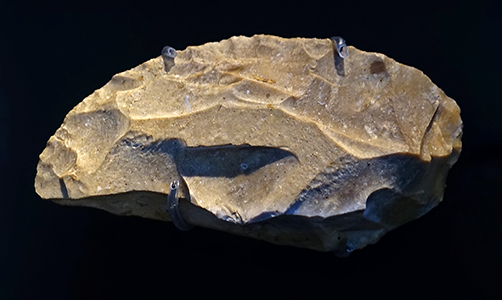
Point/rounded scraper
From layer 2, the youngest layer, Große Grotte, Blaubeuren-Gerhausen, Alb-Donau-Kreis, circa 50 000 BP
Photo: Don Hitchcock 2018
Source and text: Landesmuseum Württemberg, Stuttgart
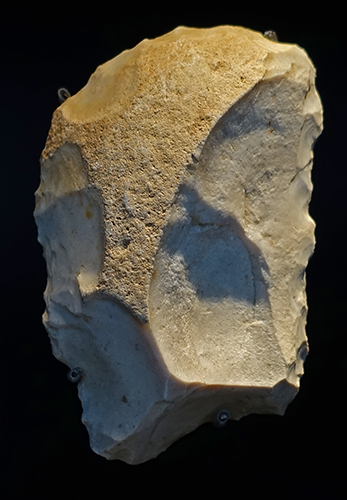
Scraper
From layer 2, the youngest layer, Große Grotte, Blaubeuren-Gerhausen, Alb-Donau-Kreis, circa 50 000 BP
Photo: Don Hitchcock 2018
Source and text: Landesmuseum Württemberg, Stuttgart
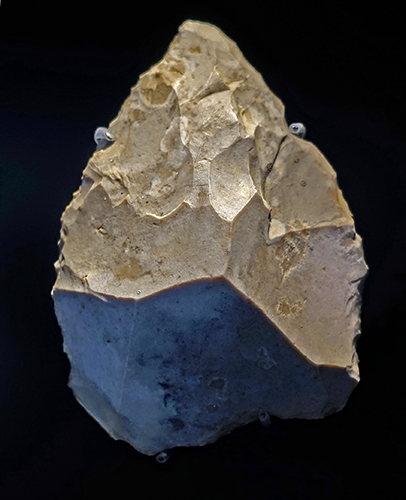
Handaxe
From layer 2, the youngest layer, Große Grotte, Blaubeuren-Gerhausen, Alb-Donau-Kreis, circa 50 000 BP
Photo: Don Hitchcock 2018
Source and text: Landesmuseum Württemberg, Stuttgart
Scrapers
From layer 5 or 6, Große Grotte, Blaubeuren-Gerhausen, Alb-Donau-Kreis.
Photo: Don Hitchcock 2018
Source and text: Landesmuseum Württemberg, Stuttgart
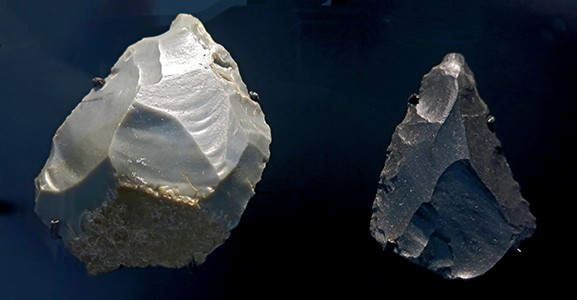
Grattoir à museau, or nosed/muzzle shaped scraper, and a point.
From layer 5 or 6, Große Grotte, Blaubeuren-Gerhausen, Alb-Donau-Kreis.
Photo: Don Hitchcock 2015
Source and text: Landesmuseum Württemberg, Stuttgart


Hand axe and leaf shaped scraper.
From layer 9, Große Grotte, Blaubeuren-Gerhausen, Alb-Donau-Kreis.
Photo: Don Hitchcock 2018
Source and text: Landesmuseum Württemberg, Stuttgart
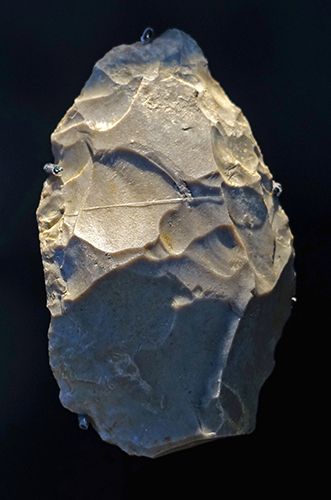

Leaf shaped scraper and a double point.
From layer 9, Große Grotte, Blaubeuren-Gerhausen, Alb-Donau-Kreis.
Photo: Don Hitchcock 2018
Source and text: Landesmuseum Württemberg, Stuttgart
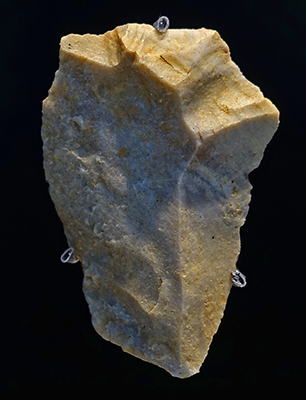

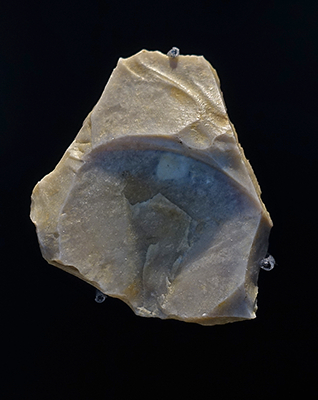
Three Levallois flakes.
From layer 11, Große Grotte, Blaubeuren-Gerhausen, Alb-Donau-Kreis.
Photo: Don Hitchcock 2018
Source and text: Landesmuseum Württemberg, Stuttgart
| Large mammal remains recovered from the Große Grotte number of identified specimens (NISP) and weight (g) |
|||||
|---|---|---|---|---|---|
| Scientific name | Common name | NISP | NISP(%) | weight (g) | weight (%) |
| Lepis cf. timidus | Arctic hare | 35 | 2.0% | 50.2 | 0.2% |
| Canis lupus | Wolf | 9 | 0.8% | 27.8 | 0.1% |
| Alopex lagopus now Vulpes lagopus | Arctic fox | 2 | 0.2% | 7.3 | 0.0% |
| Vulpes vel (similar to, aff.) Alopex | Arctic fox | 6 | 0.5% | 9.2 | 0.0% |
| Vulpes vulpes | Red fox | 8 | 0.7% | 31.8 | 0.2% |
| Mustela putorius vel (similar to, aff.) eversmanni | Steppe polecat | 9 | 0.8% | 27.8 | 0.1% |
| Martes martes | European pine marten | 1 | 0.1% | 2.7 | 0.0% |
| Crocuta crocuta spelaea | cave hyena | 1 | 0.1% | 12.0 | 0.1% |
| Felis silvestris | European wildcat | 1 | 0.1% | 1.0 | 0.0% |
| Panthera leo spelaea | European cave lion | 3 | 0.3% | 38.7 | 0.2% |
| Ursus spelaeus | Cave bear | 857 | 73.2% | 16705.1 | 80.6% |
| Mammuthus primigenius | Woolly mammoth | 2 | 0.2% | 196.0 | 0.9% |
| Equus germanicus | Wild horse | 9 | 0.8% | 215.3 | 1.0% |
| Coelodonta antiquitatis | Woolly rhinoceros | 1 | 0.1% | 67.0 | 0.3% |
| Cervus elaphus | Red deer | 3 | 0.3% | 428.0 | 2.1% |
| Rangifer tarandus | Reindeer | 50 | 4.3% | 467.2 | 2.3% |
| Cervidae indet. | Deer, Elk, Moose family | 2 | 0.2% | 4.0 | 0.0% |
| Rupicapra rupicapra | Chamois | 5 | 0.4% | 22.0 | 0.1% |
| Capra ibex | Alpine ibex | 114 | 9.7% | 2065.2 | 10.0% |
| Caprinae indet. | Sheep and goat family | 1 | 0.1% | 2.9 | 0.0% |
| Artiodactyla indet. | Even toed ungulates such as deer, antelopes, sheep, goats, and cattle | 54 | 4.6% | 304.2 | 1.5% |
| Total | 1165 | 100% | 20729 | 100% | |
Data above after Weinstock (1999)
References
- Adam, K., Kurz, R., 1980: Eiszeitkunst im süddeutschen Raum, Theiss.
- Bolus, M., Conard N., 2012: 100 Jahre Robert Rudolf Schmidts 'Die diluviale Vorzeit Deutschlands', Mitteilungen der Gesellschaft für Urgeschichte, 21 (2012) 63
- Çep B., 1996: Die Steinartefakte der Schichten VIII/VII und VI des Sirgensteins bei Weiler, in: Spuren der Jagd - die Jagd nach Spuren, Campen I, Hahn J, Uerpmann M (eds). Tübinger Monographien zur Urgeschichte 11: 207–216.
- Conard N., Uerpmann H., 1999: Ausgrabungen im Gravettien des Hohle Fels bei Schelklingen, Alb-Donau-Kreis, Archäol. Ausgr. Baden-Württemberg, 1999, 147–52.
- Conard N., Langguth K., Uerpmann H., 2000: Die Grabungen 1999 in den Gravettien-Schichten des 'Hohle Fels' bei Schelklingen, Alb-Donau-Kreis, Archäol. Ausgr. Baden-Württemberg, 1999, 21–25.
- Conard N., Floss H., 2001: An ivory statuette of 30,000 years BP found at Hohle Fels near Schelklingen (Baden-Württemberg, Germany): Paleo, 13 | 2001, 241-244.
- Conard N., Langguth K., Uerpmann H., 2001: Die Ausgrabungen 1997 und 1998 im Hohle Fels bei Schelklingen Alb-Donau-Kreis, Archäol. Ausgr. Baden-Württemberg, 2000, 18–22.
- Conard N., 2002: Der Stand der altsteinzeitlichen Forschung im Achtal der Schwäbischen Alb, Mitteilungen der Gesellschaft für Urgeschichte , 11 (2002) 65
- Conard N., Langguth K., Uerpmann H., 2002: Neue Aurignacien-Fundschichten im Hohle Fels bei Schelklingen, Alb-Donau-Kreis., Archäol. Ausgr., Baden-Württemberg 2001, 21–26.
- Conard N., Bolus M., 2003: Radiocarbon dating the appearance of modern humans and timing of cultural innovations in Europe: new results and new challengesJournal of Human Evolution , 44 (2003) 331–371
- Conard N., Malina M., Münze S., Seeberger F., 2004: Eine Mammutelfenbeinfköte aus dem Aurignacien des Geißenklösterle.: Archäologisches Korrespondenzblatt, 34, 2004
- Conard N., Malina M., 2006: Schmuck und vielleicht auch Musik am Vogelherd bei Niederstotzingen-Stetten ob Lontal, Kreis Heidenheim: Archäol. Ausgr. Baden-Württemb., 21–25 (2006).
- Conard N., Malina M., Münze S., 2009: New flutes document the earliest musical tradition in southwestern Germany: Nature, 10.1038/nature08169, 2009.
- Conard N., Malina M., 2011: Neue Eiszeitkunst und weitere Erkenntnisse über das Magdalénien vom Hohle Fels bei Schelklingen, Archäologische Ausgrabungen in Baden-Württemberg, 2010, 56–60.
- Conard N., Richter J., 2011: Neanderthal Lifeways, Subsistence and Technology: One Hundred Fifty Years of Neanderthal Study, (Google eBook), Springer, 2011, XV, 293p.
- Goldberg P., Solveig S., Meligne K., Dayton C., Conard N., 2003: Micromorphology and Site Formation at Hohle Fels Cave,Swabian Jura, Germany: Eiszeitalter und Gegenwart, 53 Hannover 2003
-
Hahn, J., Scheer, A., Wagner, E., 1985, Catalogue texts to: Hahn, J., Scheer, A., Symens, N. Höhlen als Unterschlupf für Mensch und Tier, in: Landesdenkmalamt Baden - Württemberg (Ed.), Der Keltenfürst von Hochdorf. Methoden und Ergebnisse der Landesarchäologie. Konrad Theiss Verlag, Stuttgart, pp. 226–245.
- Hahn J., 1977: Aurignacien, das ältere Jungpala¨olithikum in Mittel- und Osteuropa. Böhlau-Verlag,, Köln/Wien.
- Hahn J., 1985: Die Geißenklösterle-Höhle im Achtal bei Blaubeuren I. Fundhorizontbildung und Besiedlung im Mittelpaläolithikum und Aurignacien, Stuttgart, Theiss-Verlag
- Hahn J., 1988: Die Geißenklösterle-Höhle im Achtal bei Blaubeuren I. Fundhorizontbildung und Besiedlung im Mittelpaläolithikum und Aurignacien, Stuttgart, Theiss-Verlag
- Hahn J., 1989: Die Geißenklösterle-Höhle im Achtal bei Blaubeuren I. Fundhorizontbildung und Besiedlung im Mittelpaläolithikum und Aurignacien, Fundber. Baden-Württemberg 14, 1–22.
- Hahn J., Münze S., 1995: Knochenflöten aus dem Aurignacien des Geißenklösterle bei Blaubeuren, Alb-Donau-Kreis.: Fundber. Baden-Württemb., 20, 1–12 (1995).
- Holdermann C., Müller-Beck H., Simon U., Conard N., Floss H., Porr M., Waiblinger J., 2001: Eiszeitkunst im süddeutsch-schweizerischen Jura. Anfänge der Kunst. , Theiss, 2001, 142p.
- Münzel S., ca 2001: Spuren der Jagd – archäologische Quellen für die Interpretation steinzeitlicher Jagdmethoden, http://www.jagd-bayern.de/fileadmin/_BJV/Akademie/Jagdkultur/Menzel.pdf
- Münzel S., Conard N., 2004: Change and Continuity in Subsistence during the Middle and Upper Palaeolithic in the Ach Valley of Swabia (South-west Germany), International Journal of Osteoarchaeology, 14: 225–243 (2004)
- Orschiedt J., 1997: Der Nachweis einer Sekundärbestattung aus dem Magdalénien der Brillenhöhle, Alb-Donau-Kreis (Baden-Württemberg). Archäologisches Korrespondenzblatt, 27(2): 193-206.
- Orschiedt J., 1999: Manipulationen an menschlichen Skelettresten. Taphonomische Prozesse, Sekundiirbestattungen oder Kannibalismus, 13. MoVince, Tübingen.
- Orschiedt J., 2002: Secondary burial in the Magdalenian: the Brillenhöhle in Southwest Germany, Paléo, 14: 241-256.
- Osborn H., 1915: Men of the old stone age, their environment, life and art, New York, Charles Scribner's Sons
- Rau, S., Naumann D., Barth M., Mühleis Y., Bleckmann C., 2009: Eiszeit: Kunst und Kultur, Thorbecke, 2009, 396p. ISBN: 978-3-7995-0833-9
- Saier C., 1994: Das Material der 'Altgrabungen' vom Hohlen Felsen, Gemeinde Scheklingen, Alb-Donau-Kreis, Masters Thesis; University of Tübingen.
- Scheer A., 1989: Schmuck und neue Funde aus dem Gravettien des Geißenklösterle bei Blaubeuren, Alb-Donau-Kreis, Archeol. Ausgr Baden Württemberg, 1988, 23–28.
- Schmidt R., 1910: Der Sirgenstein und die diluvialen Kulturstätten Württembergs, Stuttgart
- Schmidt R., 1912: Die diluviale Vorzeit Deutschlands, Stuttgart
- Toniato G, Münzel S., Starkovich B., Conard N., 2018: Middle and Upper Palaeolithic Bone Retouchers from the Swabian Jura: Raw Materials, Curation, and Use. In The Origins of Bone Tool Technologies, in: The Origins of Bone Tool Technologie, eds. Gaudzinski-Windheuser et al., 251-267.
- Taute W., 1965: Retouscheure aus Knochen, Zahnbeinund Stein vom Mittelpaläolithikum bis zum Neo-lithikum, Fundberichte aus Schwaben, N.F. 17: 76–102
- Weinstock J., 199: The upper Pleistocene mammalian fauna from the Große Grotte near Blaubeuren (southwest Germany), Stuttgarter Beiträge zur Naturkunde, 277, 1-49
- Wolf S., Dapschauskas R., Velliky E., Floss H., Conrad N., 2018: The Use of Ochre and Painting During the Upper Paleolithic of the Swabian Jura in the Context of the Development of Ochre Use in Africa and Europe, Open Archaeology 2018; 4: 185–205, https://doi.org/10.1515/opar-2018-0012
- Zilhão J., d'Errico F., 2003: The Chronology of the Aurignacian and of the Transitional Technocomplexes: Dating, Stratigraphies, Cultural Implications, Proceedings of Symposium 6.1 of the XIVth Congress of the UISPP, University of Liège, Belgium, September 2-8, 2001, 355p.
- Zilhão J., d'Errico F., 2010: An Aurignacian «garden of Eden» in southern Germany ? An alternative interpretation of the Geißenklösterle and a critique of the Kulturpumpe modelPaleo (online), 15 | 2003, URL : http://paleo.revues.org/1231
Back to Don's Maps
 Back to Archaeological Sites
Back to Archaeological Sites
